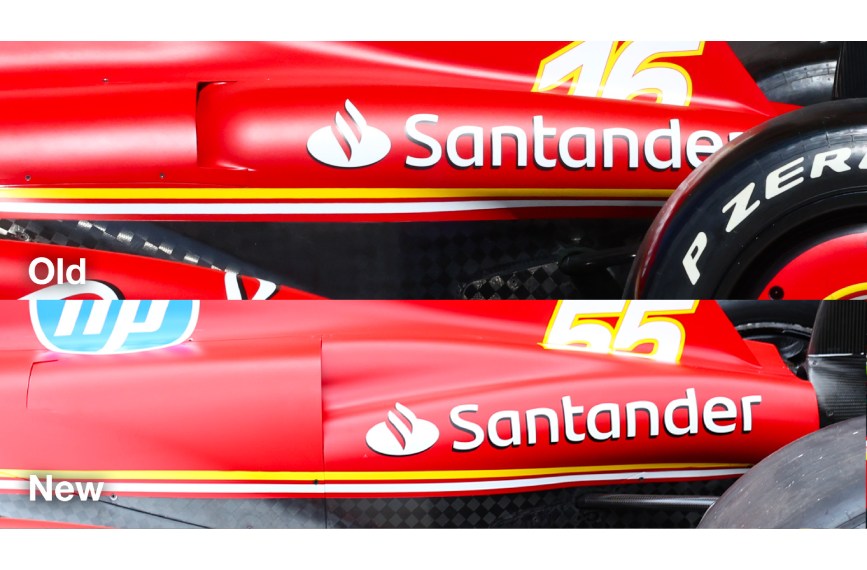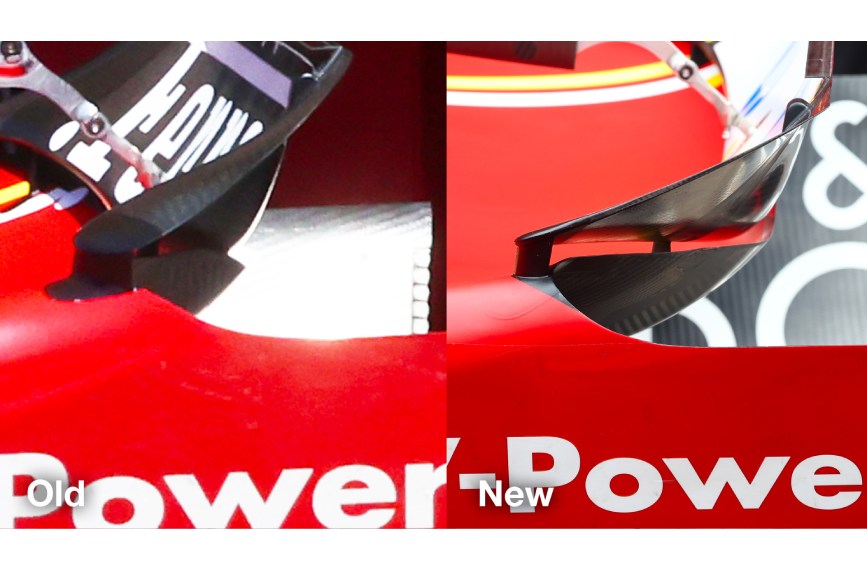Car
Formula 1 2024 upgrades: RB and Sauber make changes for Abu Dhabi Grand Prix
by Raceteq
30min read
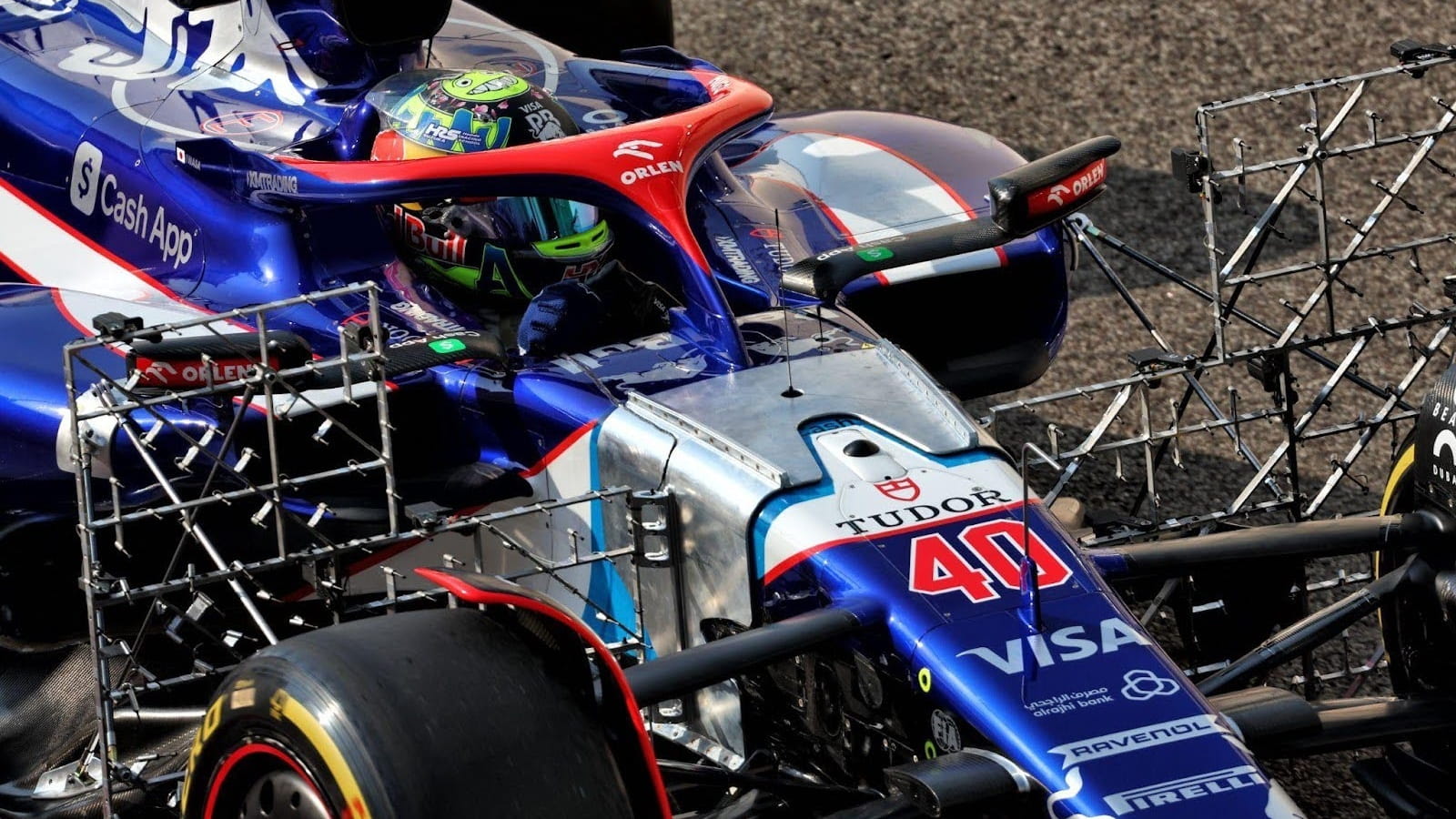
The sun set on the 2024 Formula 1 season in Abu Dhabi but there were still upgrades to note as teams continued their development cycles at the season finale.
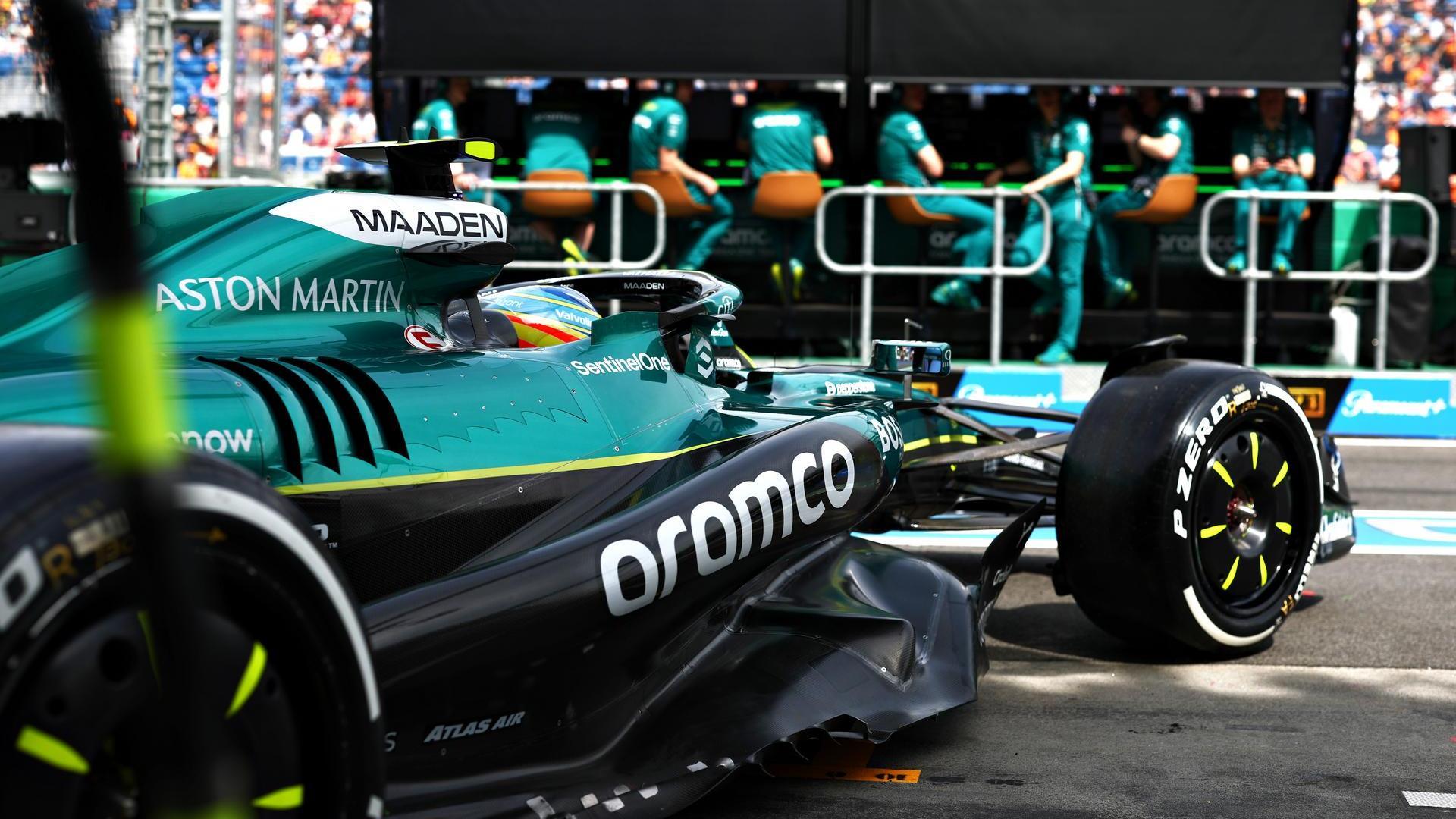
Sign up for a weekly newsletter and we'll make sure you're fully up-to-date in the world of race technology
Sauber and RB were the two teams that declared upgrades at Yas Marina Circuit - both of those upgrades clearly implemented with a view to developing their respective cars for 2025.
Here are the details of the final F1 car presentation submissions for 2024.
RB
A new nose and front wing comprised RB’s declared upgrades for the 2024 Abu Dhabi Grand Prix.
The entirety of the front wing was reshaped while the nose of the car was shortened to complement its characteristics.
RB’s sporting director, Alan Permane, says that the team brought a pair of new front wings to Yas Marina Circuit to increase downforce and make the car more compliant for drivers Yuki Tsunoda and Liam Lawson.
“It is aimed at just going faster. There's no special trick about it,” he said.
Jump to grand prix:
Qatar | Las Vegas | Brazil | Mexico City | United States | Singapore | Azerbaijan | Italy | Netherlands | Belgium | Hungary | Great Britain | Austria | Spain | Canada | Monaco | Emilia-Romagna | Miami
The wing was however removed for qualifying and the race and replaced with the previous specification - but seen as a step forward and a possibly useful part at other circuits with different characteristics to Abu Dhabi.
The team failed to score in Abu Dhabi and finished eighth in the 2024 constructors’ standings.
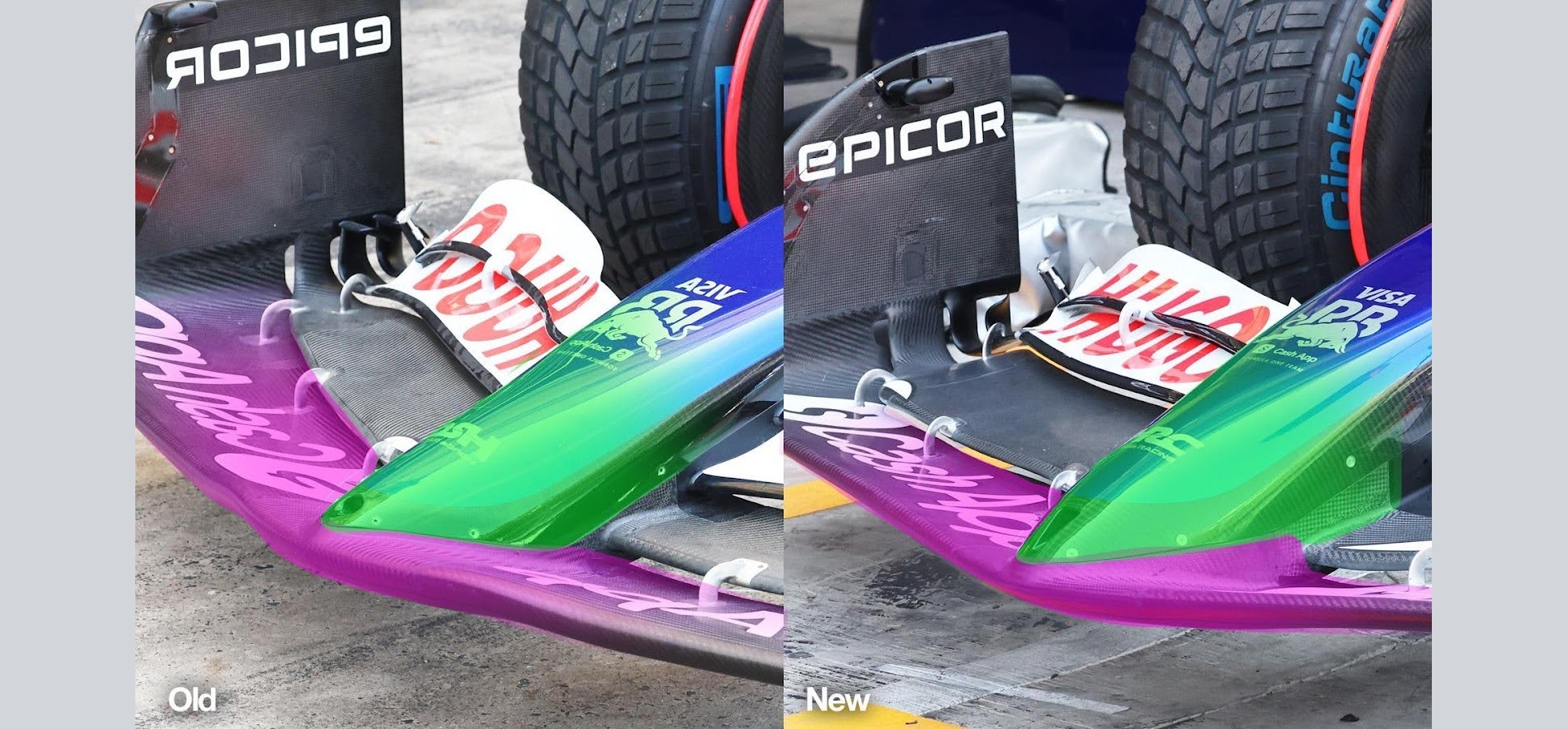
Comparison to further highlight difference between RB's new front wing (R) and old front wing (L) in Abu Dhabi
Sauber
Sauber changed its floor for the season-ending race in preparation for next season.
It added volume to the rear floor body to improve airflow and reduce losses of downforce when the car is at its lowest.
It also repositioned its rear brake ducts lower deflectors to control vortices and improve the efficiency of the diffuser.
Sauber missed out on points in Abu Dhabi but its outgoing driver Valtteri Bottas said that the team had made a step forward in recent races - even if it was “a little bit late” for his liking.
The team finished 10th and last in the 2024 constructors’ standings.
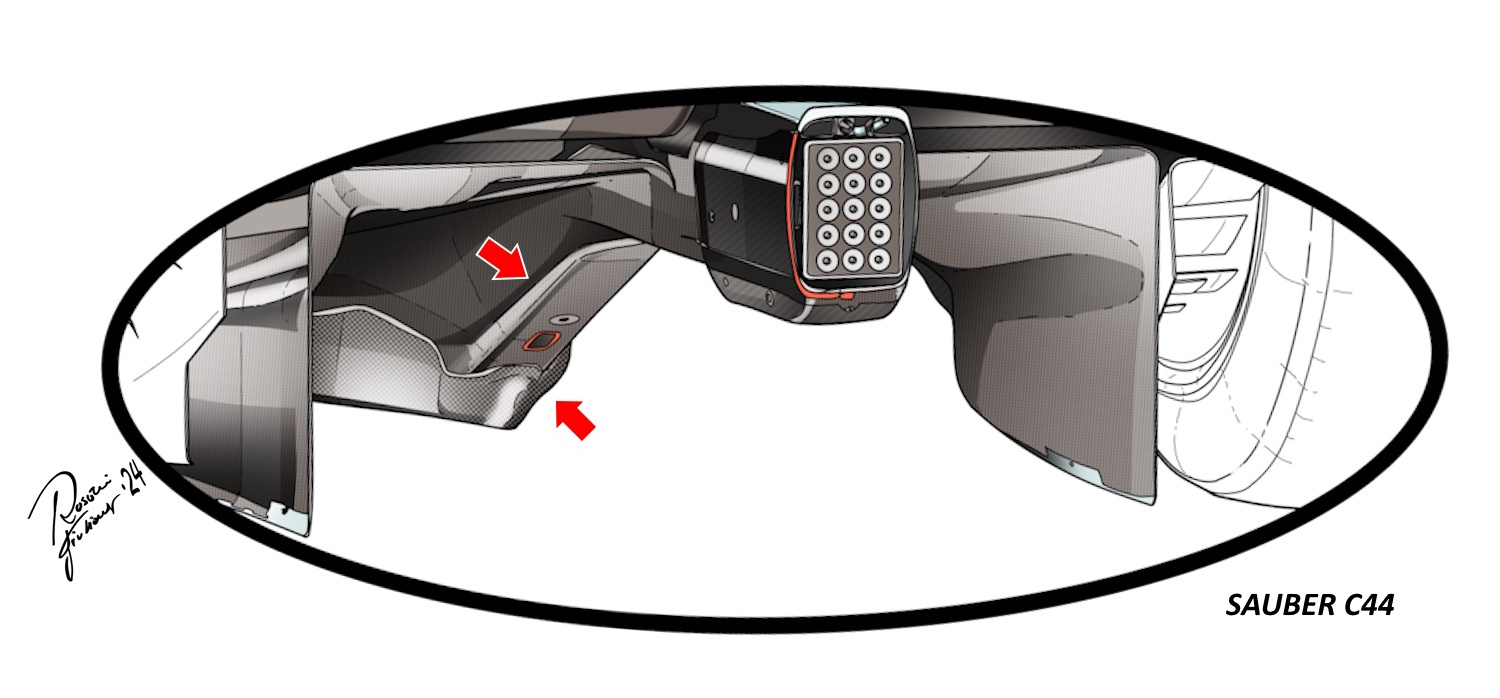
Illustration of Sauber's diffuser update in Abu Dhabi, with red arrows showing the main area of change under the rear of the C44 car
Although Qatar is the penultimate grand prix of the 2024 Formula 1 season, teams continued to bring upgrades to Lusail International Circuit in preparation for the 2025 F1 season.

Sign up for a weekly newsletter and we'll make sure you're fully up-to-date in the world of race technology
Alpine prepares for 2025 with Qatar Grand Prix wing
Next year will be the final one of this set of regulations, with a wide-ranging suite of changes coming to F1 in 2026. Teams will therefore be winding down their development of the current-specification of machines earlier than usual next year and carrying over plenty from this year’s car to save resources.
As a result, next season teams will essentially begin by continuing their development from this year rather than debuting wildly new design concepts - as Mercedes did with this year’s W15 F1 car.
Here are the upgrades that teams disclosed to the media for the 2024 Qatar F1 Grand Prix.
Alpine
Alpine reshaped every element of its front wing including a mainplane detached from the nose. This was done to improve airflow management inboard and enhance downforce generated by the front wing.
The nose of the Alpine car was also shortened to be compatible with the new front wing geometry and its detached mainplane.
These parts were brought to Qatar in an effort to develop the car for next season. Only one of the new front wing and nose was produced in time for this race, with Alpine attaching it to Pierre Gasly’s car.
The team used this opportunity to test the efficacy of the new wing versus the old wing - what's sometimes known as an A/B test.
Gasly finished a stellar fifth in the grand prix to boost the team's hopes of finishing sixth in the standings; Esteban Ocon ended up without points - although the new front wing alone could not have given Gasly a one-second advantage in qualifying pace over Ocon.
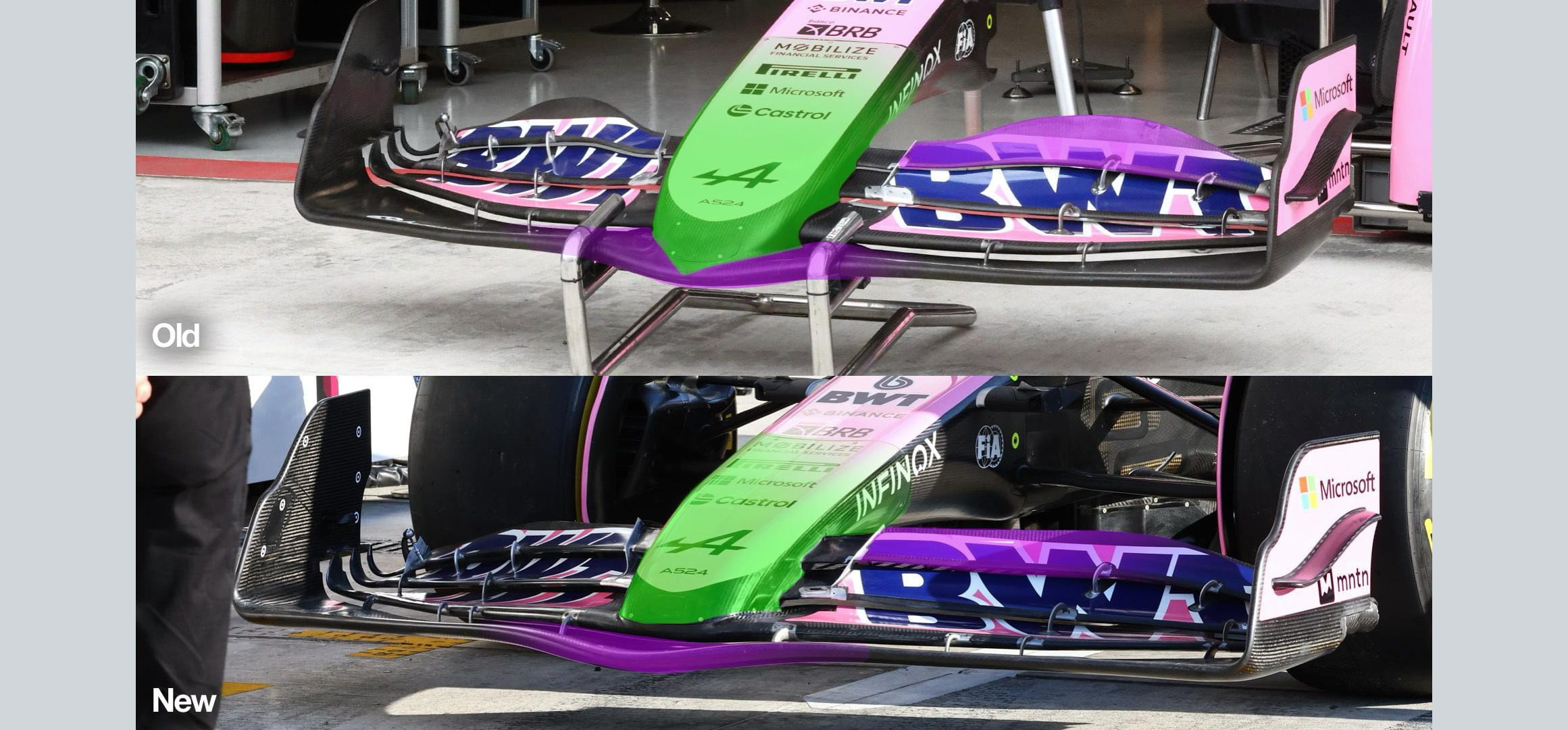
A highlighted comparison showing the new Alpine wing (below) and the previous spec (above). Sauber made a change to its front wing as well, trimming the area highlighted in purple above
Sauber
Sauber trimmed down the rearmost flap of its front wing. It reasoned that this change would allow the team to extend the “potential balance range of the already existing front wing flap” - meaning that the front wing can now be run at a lower-downforce configuration.
The team broke its point-less streak in Qatar as Zhou Guanyu took a brilliant eighth-place finish.
This wing wasn't the central reason for that success. Continued development including a new floor in Las Vegas has buoyed the team.
The Las Vegas Strip Circuit is a high-speed challenge that demands a low-downforce set-up from teams to maximise top-speed. The grid therefore brought new circuit-specific upgrades to the 2024 Las Vegas Formula 1 Grand Prix.

Sign up for a weekly newsletter and we'll make sure you're fully up-to-date in the world of race technology
Major changes for Red Bull, RB and Ferrari in Las Vegas
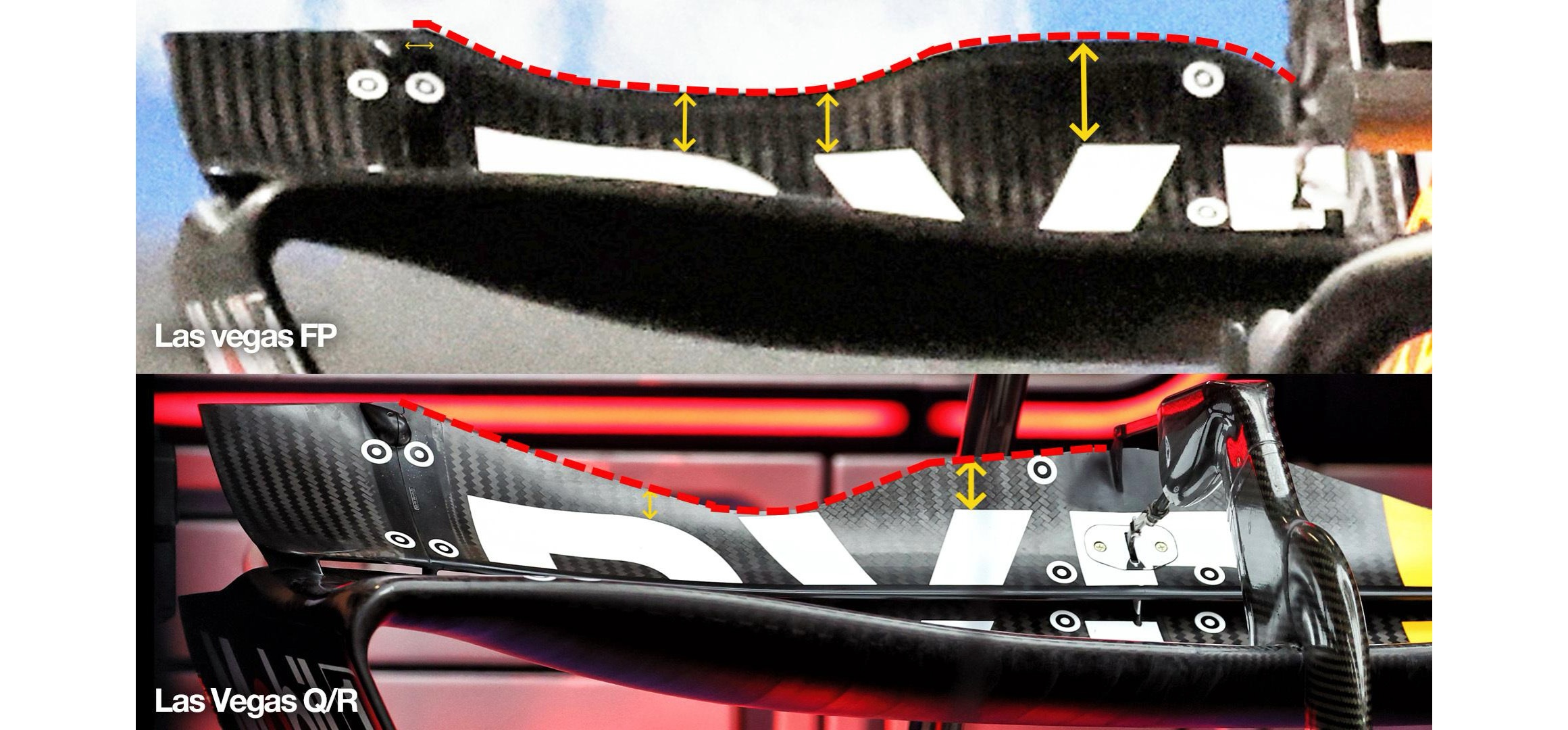
Red Bull modified its rear wing for qualifying and the race in Las Vegas
Red Bull
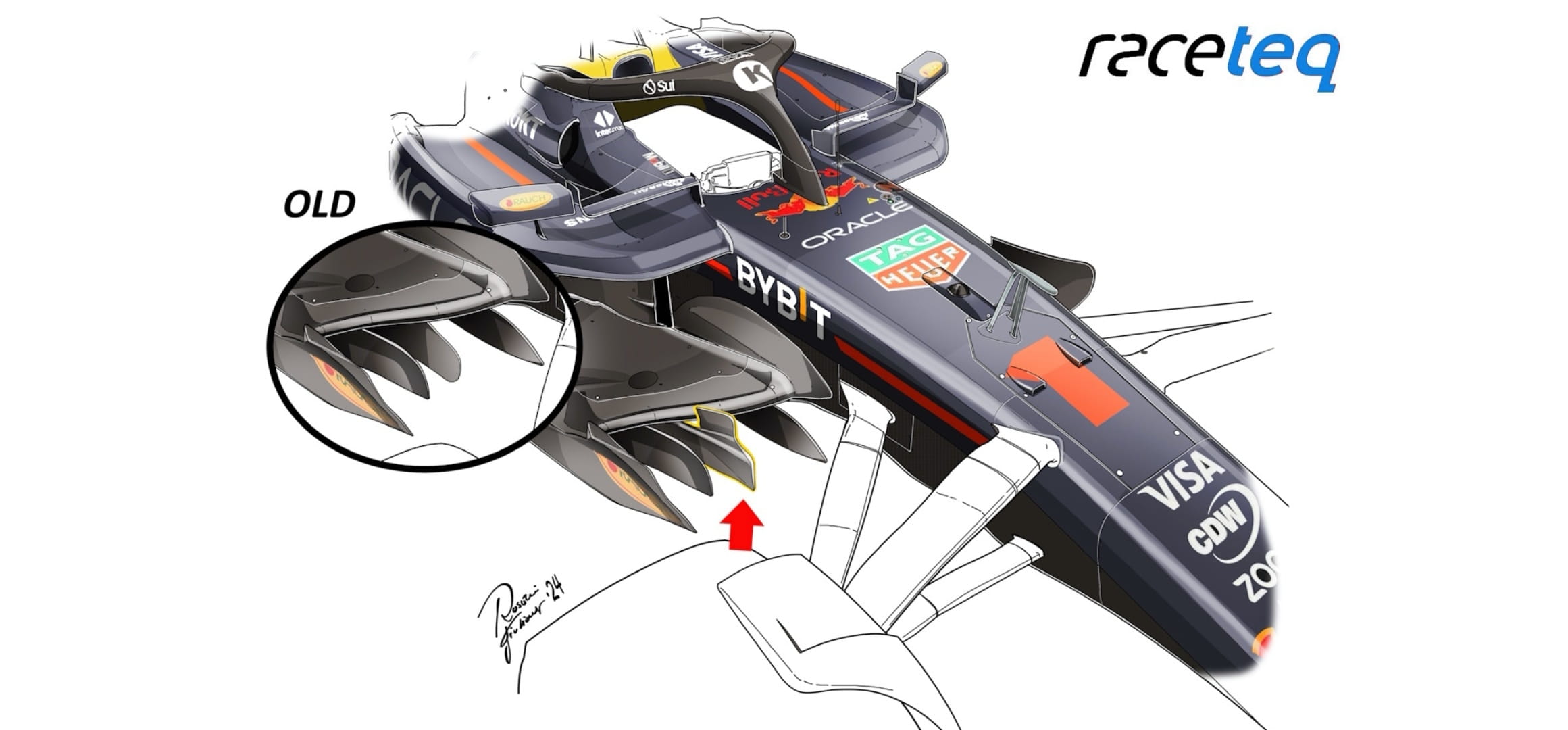
An illustration showing changes to the strakes at the front of the floor of the Red Bull RB20 in Las Vegas
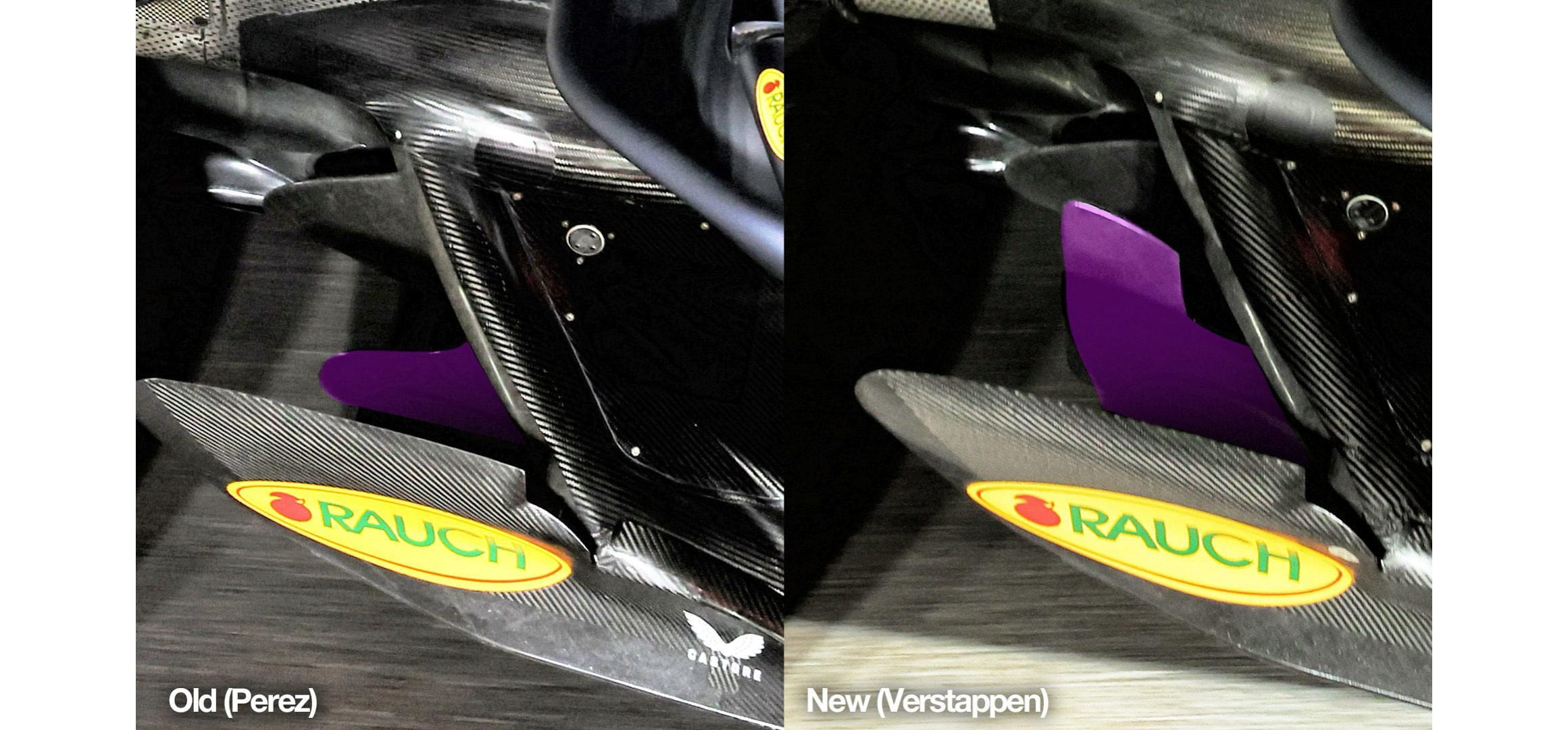
Changes to the front floor fence of the Red Bull RB20 in Las Vegas
Mercedes
Ferrari
McLaren
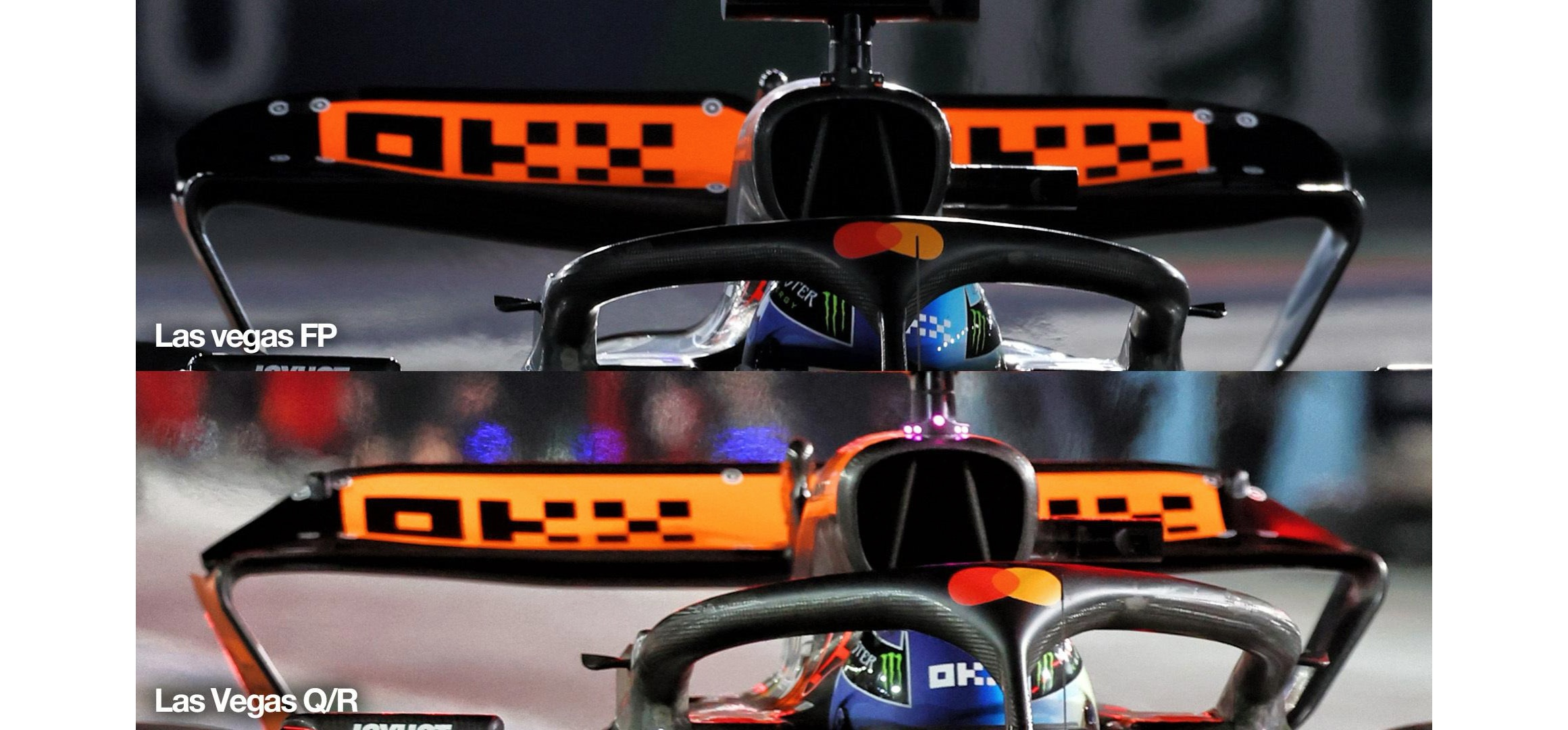
McLaren made subtle changes to its rear wing, implementing a shallower plane for qualifying and the race in Las Vegas
Aston Martin
Alpine
RB
RB's list of declared upgrades looked quite minor, but only because of a quirk of what teams have to declare in their race-by-race documents as actually it brought a substantial change to Las Vegas.
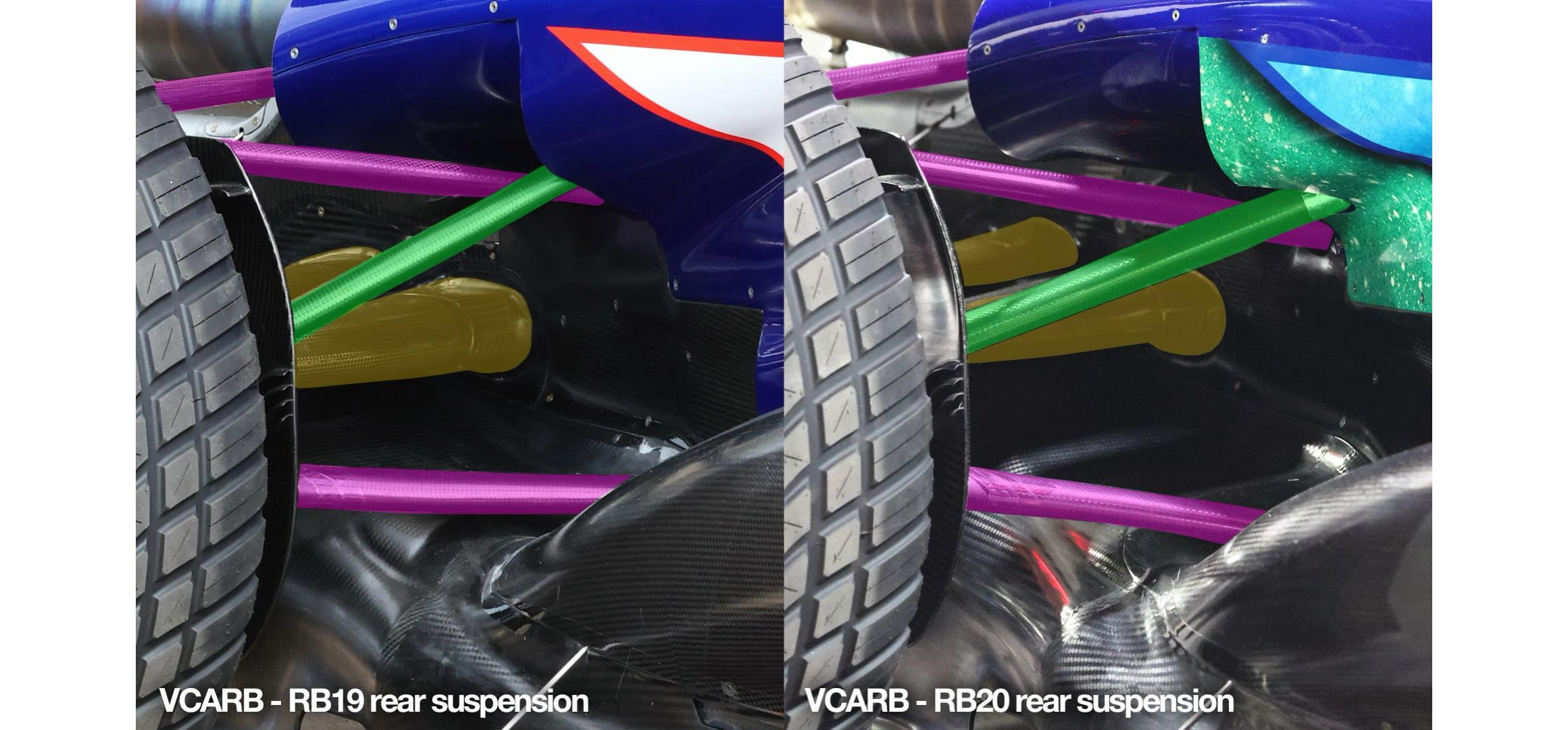
RB adopted Red Bull’s rear suspension in Las Vegas
Sauber
Haas
The 2024 Brazilian Formula 1 Grand Prix weekend was dramatic from start to finish, with a dry sprint race and a soaking wet grand prix on Sunday. Only two teams declared upgrades this weekend.
.jpg?cx=0.5&cy=0.5)
Car, Innovation
F1 upgrades: How are aerodynamic upgrades planned and deployed?
McLaren and Sauber bring changes to Brazilian Grand Prix
McLaren
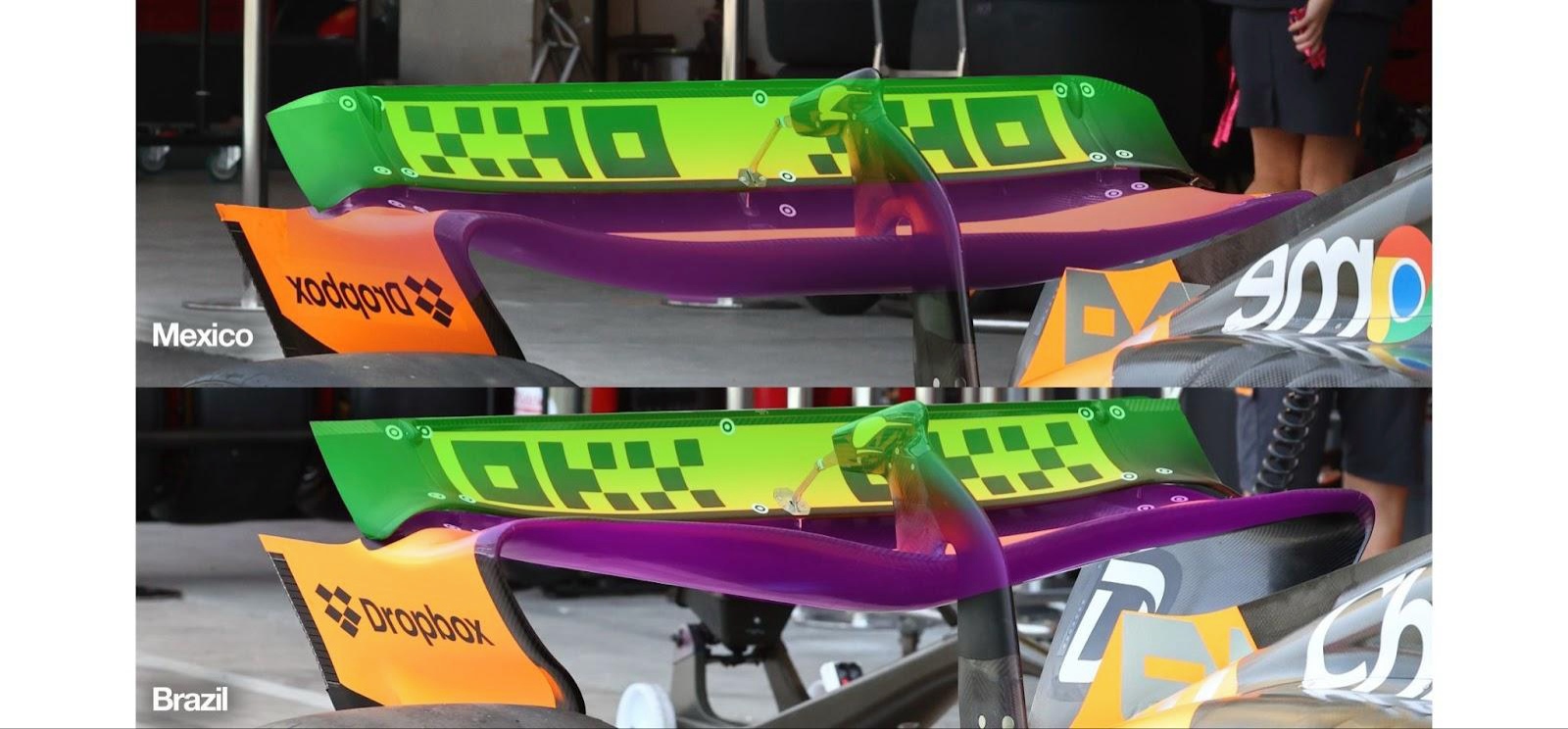
Comparison showing the previous medium-downforce rear wing and the new ‘V-shaped’ rear wing (below) brought to Brazil
Sauber
Mexico City is the highest-altitude grand prix on the Formula 1 calendar, which means downforce and cooling challenges for the F1 teams. Here’s how teams tackled that with upgrades.
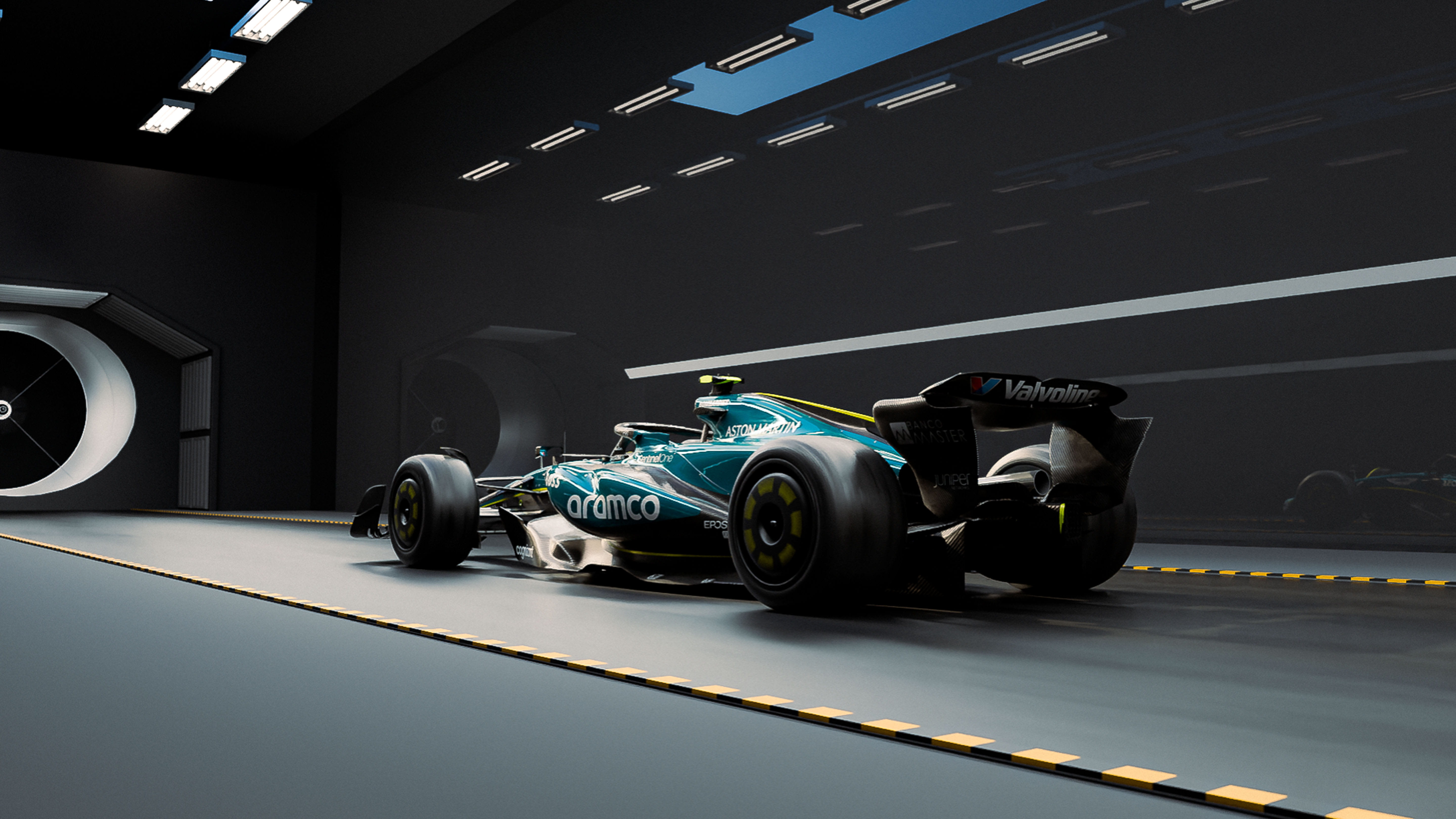
Car, Innovation
Motorsport aerodynamics explained: the role of wings, stalling and diffusers
Cooling upgrades dominate Mexico City Grand Prix changes
Autodromo Hermanos Rodriguez, the Mexico City Grand Prix venue, is characterised by demanding Monaco levels of downforce but Monza levels of speed. This is because it lies at more than 2,200 metres above sea level.
Being at high altitude, the air is less dense at this circuit. That means fewer particles of air to provide downforce - but also, less drag. As a result, teams have to run high-downforce aerodynamic packages in Mexico City but ensure their engines are sufficiently cooled because of the relative lack of oxygen and the long straight line section.
Here are the upgrades disclosed by F1 teams in Mexico City.
Red Bull
Red Bull enlarged the central top section of its bodywork and included bigger cooling exits on its front brake ducts.Max Verstappen was penalised 20 seconds for two incidents with Norris and the defending champion finished sixth, while his team-mate Sergio Perez took 17th at his home race.
Ferrari
Ferrari brought large, gill-like cooling louvres to account for the thin air in Mexico City.Carlos Sainz dominated to win the race while Charles Leclerc finished third, putting the team second in the constructors’ championship to McLaren.
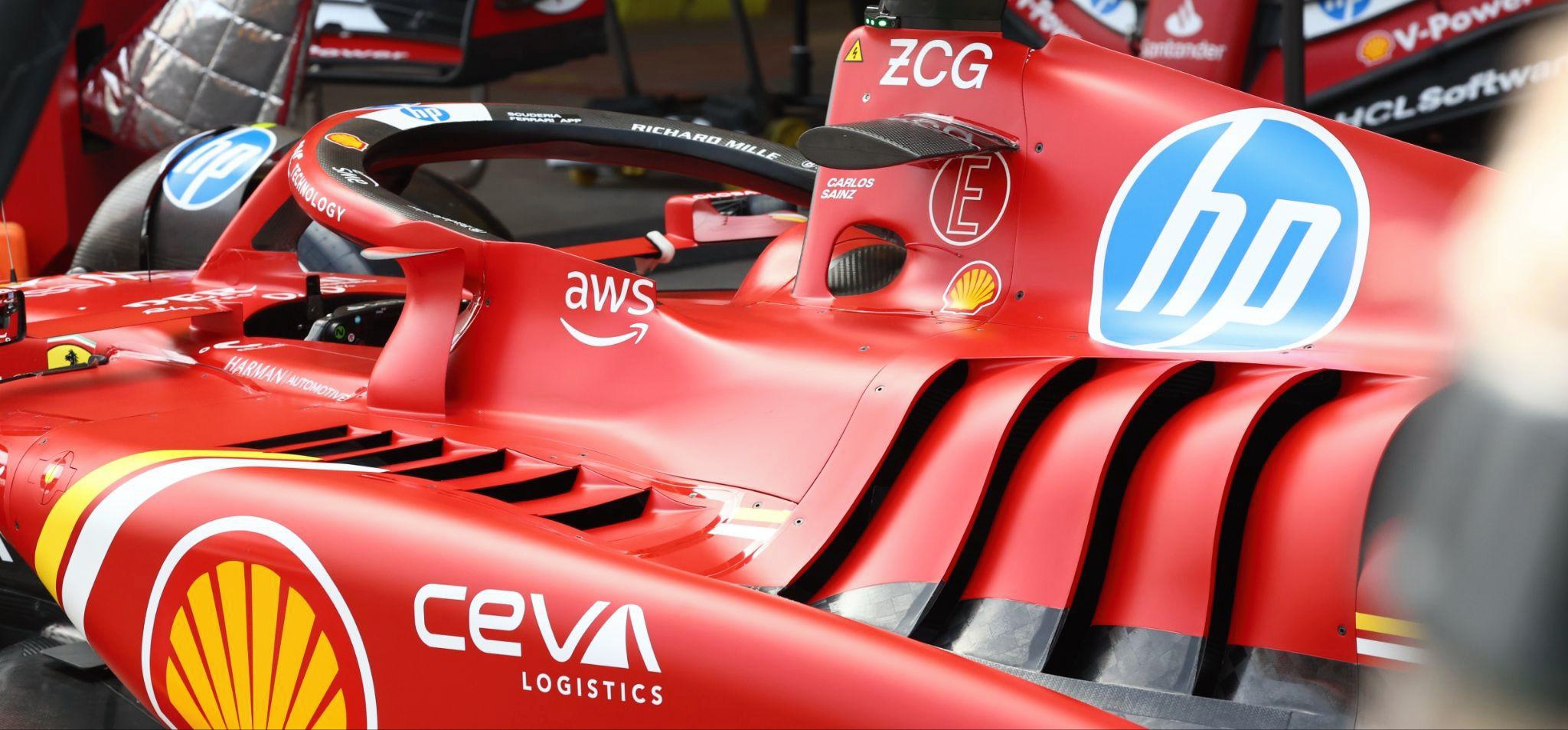
Large cooling openings on the side of the Ferrari in Mexico
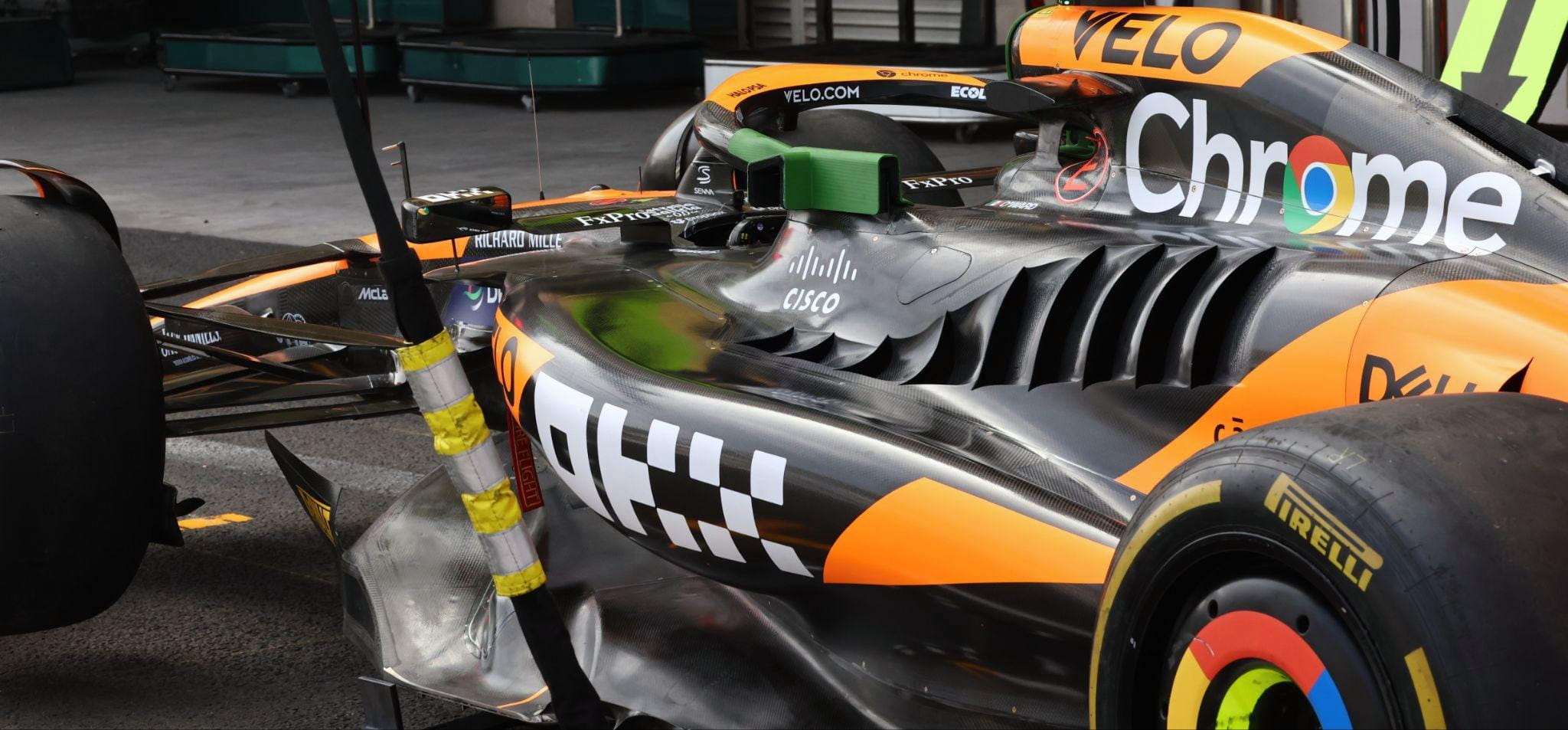
McLaren also had large cooling outlets on its car in Mexico
Williams
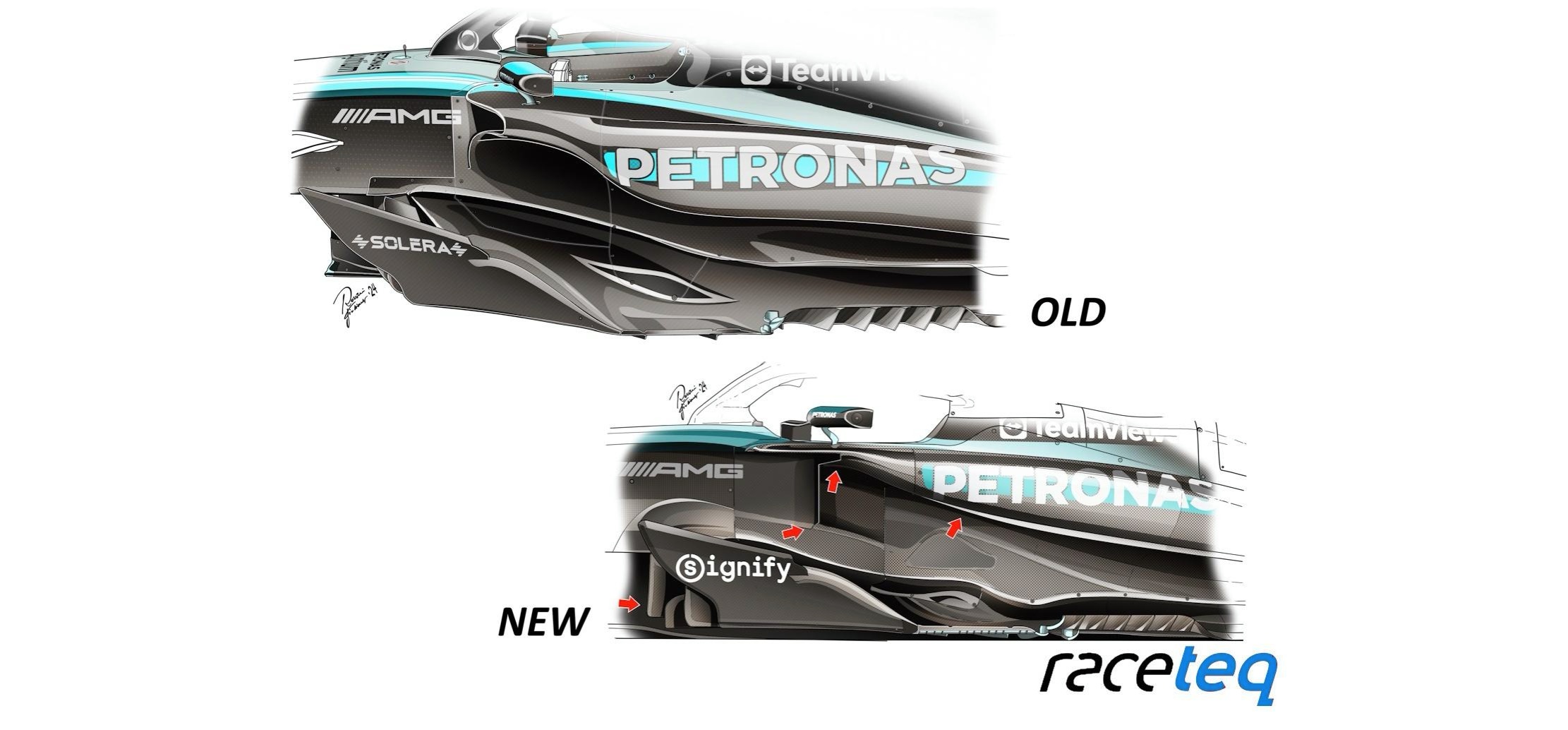
Illustration of the Mercedes sidepod changes in Mexico with arrows denoting the tapered sections around the sidepod inlet.
Mercedes
RB
Aston Martin
Red Bull turned heads ahead of the 2024 United States Grand Prix because of a contentious part of its RB20 while it, Mercedes, and McLaren, were among the teams to bring upgrades to the race at Austin.
All eyes on Red Bull in the United States
Red Bull brought numerous upgrades to the race in the United States, as did its championship rival McLaren, Mercedes, Aston Martin, and Alpine.
But attention centred around Red Bull's 'bib' or 'T-tray' device, fitted to the front of the floor to change the height of that section.
Here's what the teams disclosed to the media at the Circuit of the Americas.

The T-Tray device at the front of Red Bull's floor illustrated with the red arrow denoting the controller that raises or lowers the height of the front of its floor
Red Bull
The T-tray device wasn't a specific upgrade for this race but it dominated headlines – just as McLaren's flexible rear wing did in Azerbaijan, where it agreed to make adjustments to the device as per the FIA's request.
Red Bull's device allowed the team to adjust the height of the front of the floor from the front of the car and the cockpit. Other teams have adjusters for this part of the floor, but those are located underneath the car and therefore much harder to reach in parc ferme.
The RB20's T-tray garnered attention because teams suspected it could be used to change the front floor's height in parc ferme conditions with a mechanic doing so from the cockpit of the car. This is of course forbidden in the regulations – and both Red Bull and the FIA denied it was occurring.
Away from the contentious bib at the front of the RB20, the team brought a revised floor edge wing to increase local load and reprofiled the upper surface of its sidepods for more efficient cooling.
More efficient cooling means fewer openings needed to cool the engine - and more efficient airflow across the rear of the car.
Max Verstappen won the sprint on Saturday and finished third on Sunday to consolidate his championship lead. Sergio Perez, who finished seventh on Sunday, did not have the floor upgrade at Austin but expects to have it for his home race in Mexico on October 27.
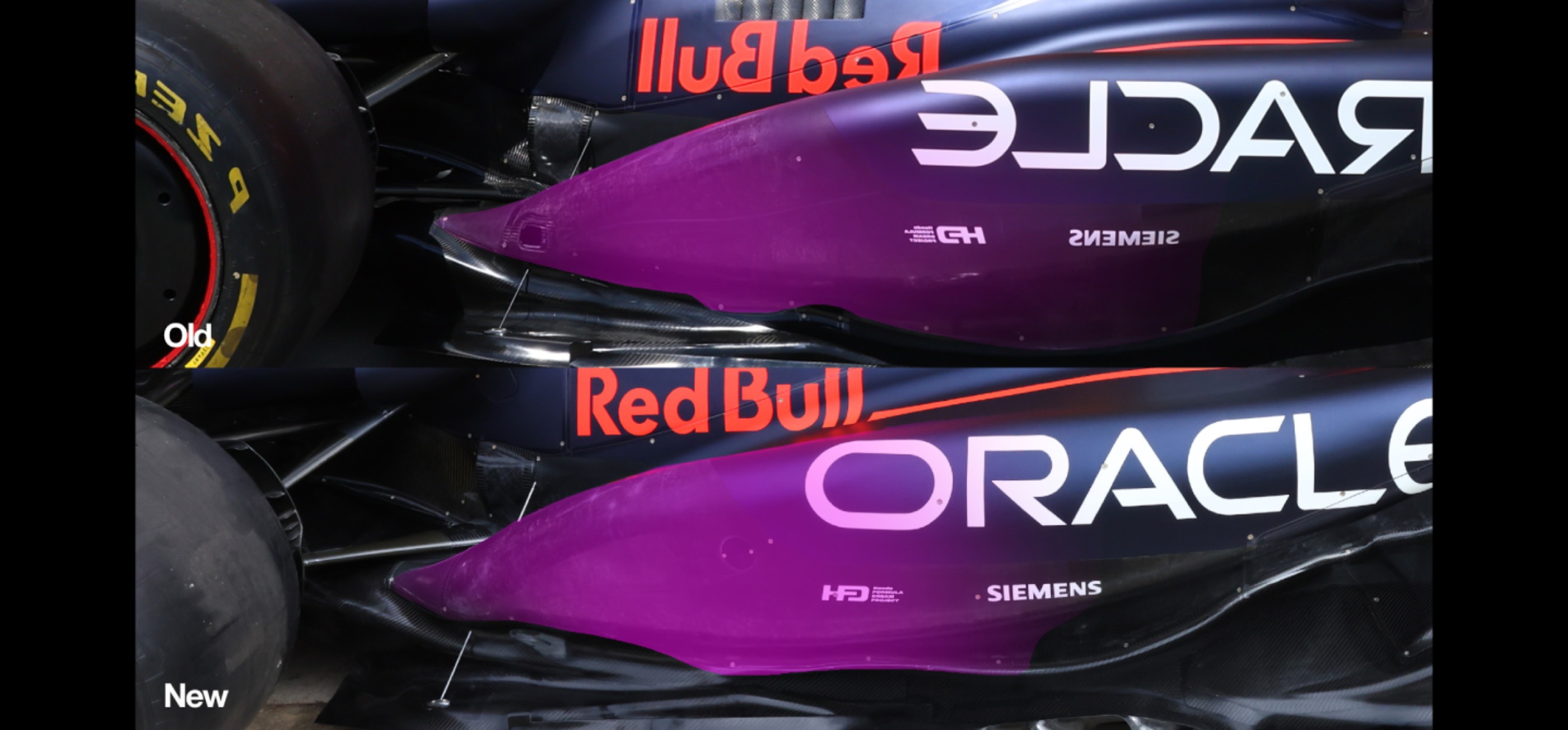
Subtly reshaped sidepods and floor edges comprised part of Red Bull's upgrade in the USA
Mercedes
Mercedes brought a major upgrade to the United States with the floor edge wing, floor vanes, and a new front wing designed to work together and improve airflow from the front to the rear of the car.
The front upper suspension wishbone fairing was also reprofiled in Austin, with an extended piece of bodywork to improve cooling towards the engine.
Furthermore, the team put an additional cooling outlet near the rear suspension to increase speed of airflow travelling over the sidepods.
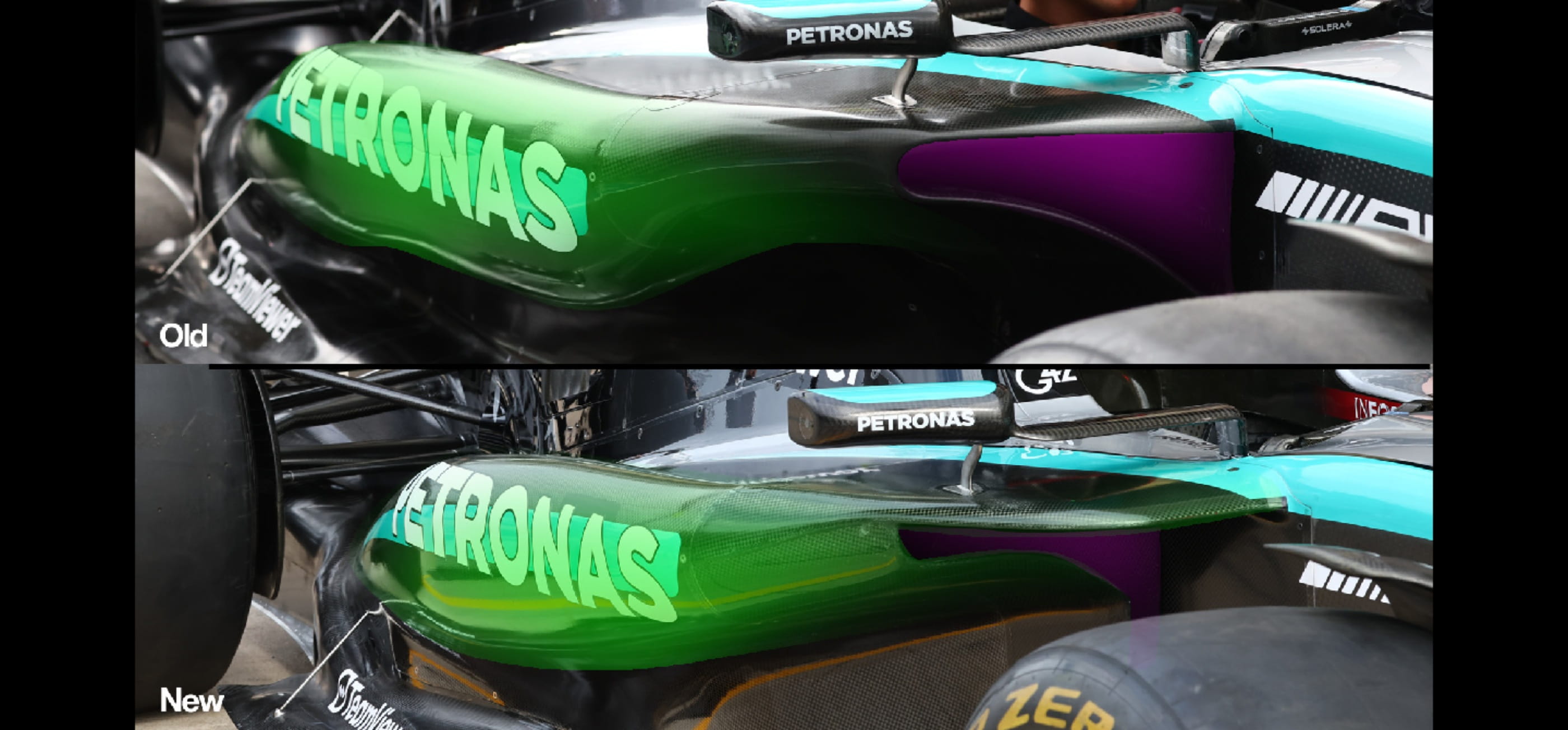
Mercedes reprofiled the rear of its car to aid cooling and airflow in Austin
George Russell finished fifth ahead of Lewis Hamilton in the sprint, but the former crashed at the end of qualifying while the latter qualified only 17th.
Russell's qualifying crash meant Mercedes had to work out of curfew and repair his car, attaching the team's spare Singapore-specification parts to the car.
Russell had to start the race from the pitlane but made it up to sixth on Sunday. Hamilton beached his car in the gravel early in the grand prix.
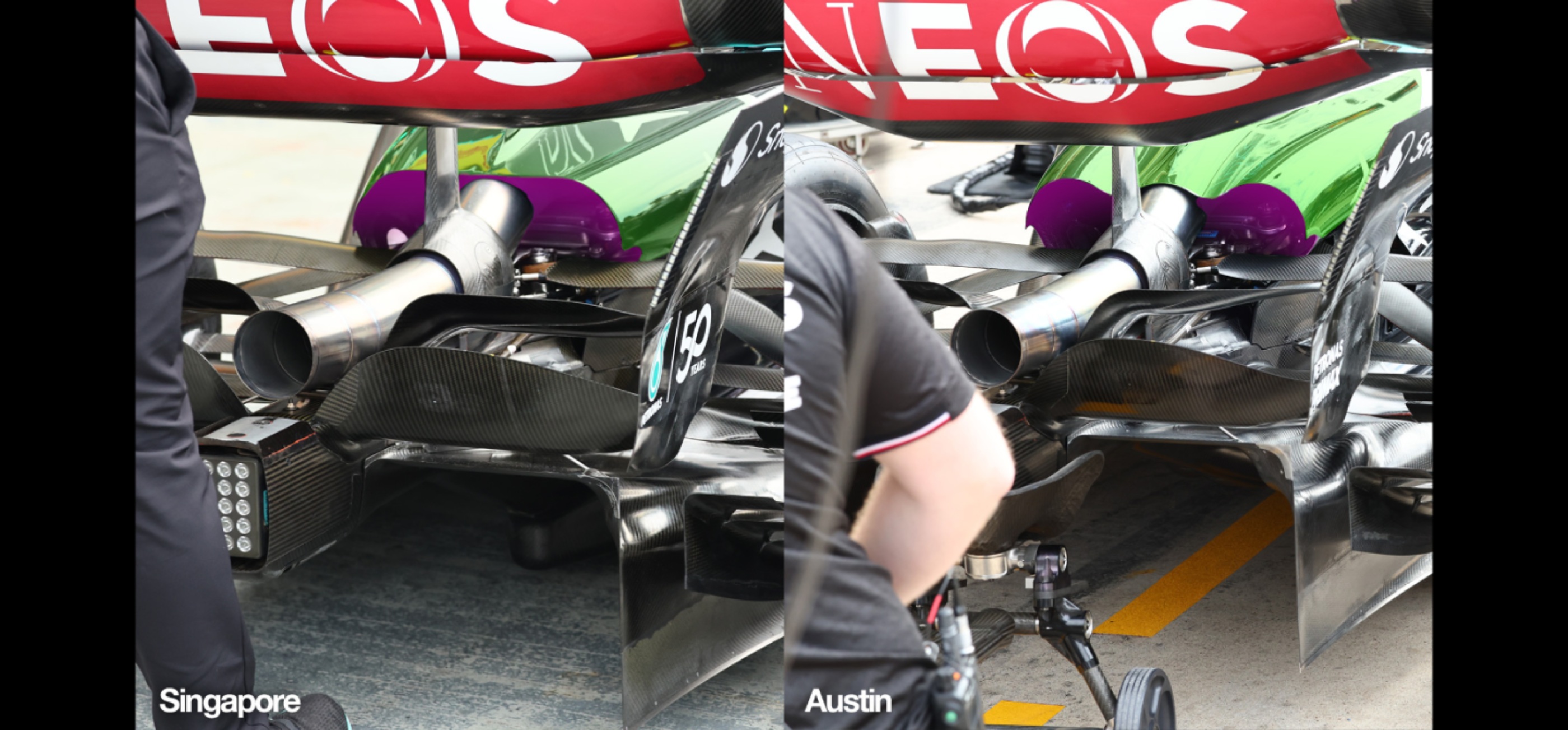
Reprofiled sidepods and sidepod inlets made up an extensive upgrade package for Mercedes at COTA
McLaren
Championship contender McLaren brought numerous upgrades to Austin including a new front wing to improve flow towards the back of the car and increase aerodynamic load.Suspension sheathing and brake ducts were also reshaped to work with the new front wing.
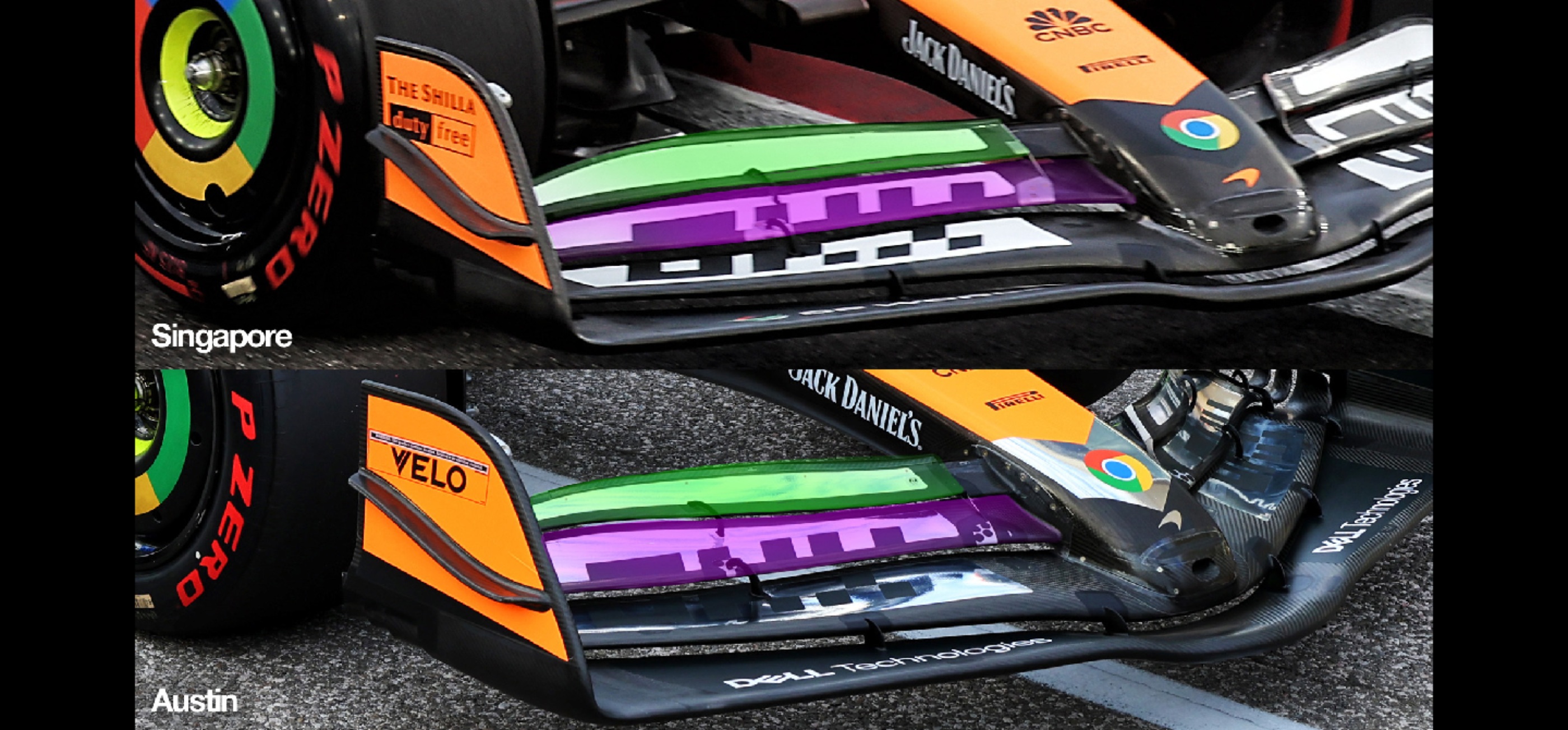
McLaren subtly revised its front wing at the Circuit of the Americas
The rear brake ducts and a new beamwing were also redesigned to improve downforce without creating as much drag as the previous specification.
Norris scored a podium in the sprint despite conceding a place to Ferrari's Carlos Sainz with a late lock-up, but Piastri struggled on Friday.
The team was outscored by both Ferrari and Red Bull over the weekend after Norris finished fourth and Piastri fifth on Sunday.
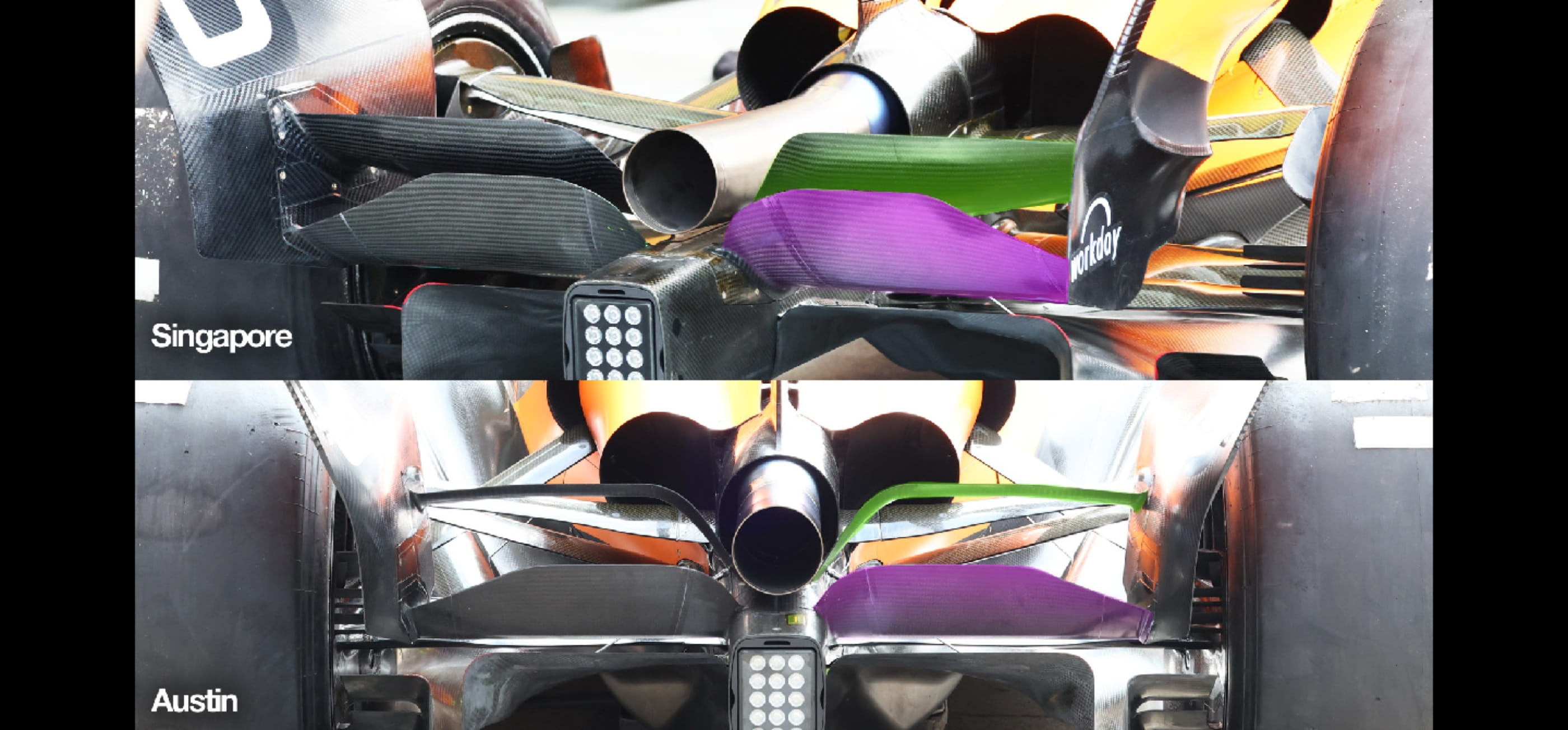
McLaren revised its beamwing in the United States
Aston Martin
Aston Martin brought a new upgrade package centred around a new floor, which included a reprofiled Venturi tunnel underneath.
Furthermore, the team attached a new diffuser and tweaked its floor edge for what it hoped would be a significant improvement in aerodynamic performance.
The engine cover and section towards the rear of the car (the coke bottle section) were also reshaped to enhance performance under the car.
Aston Martin also brought a new front wing flap design and revised endplates to improve control in turbulent air.
Fernando Alonso was not convinced about the efficacy of the new upgrade and Lance Stroll called for improvements from the upgraded Aston Martin after neither driver scored points in the sprint nor the grand prix.
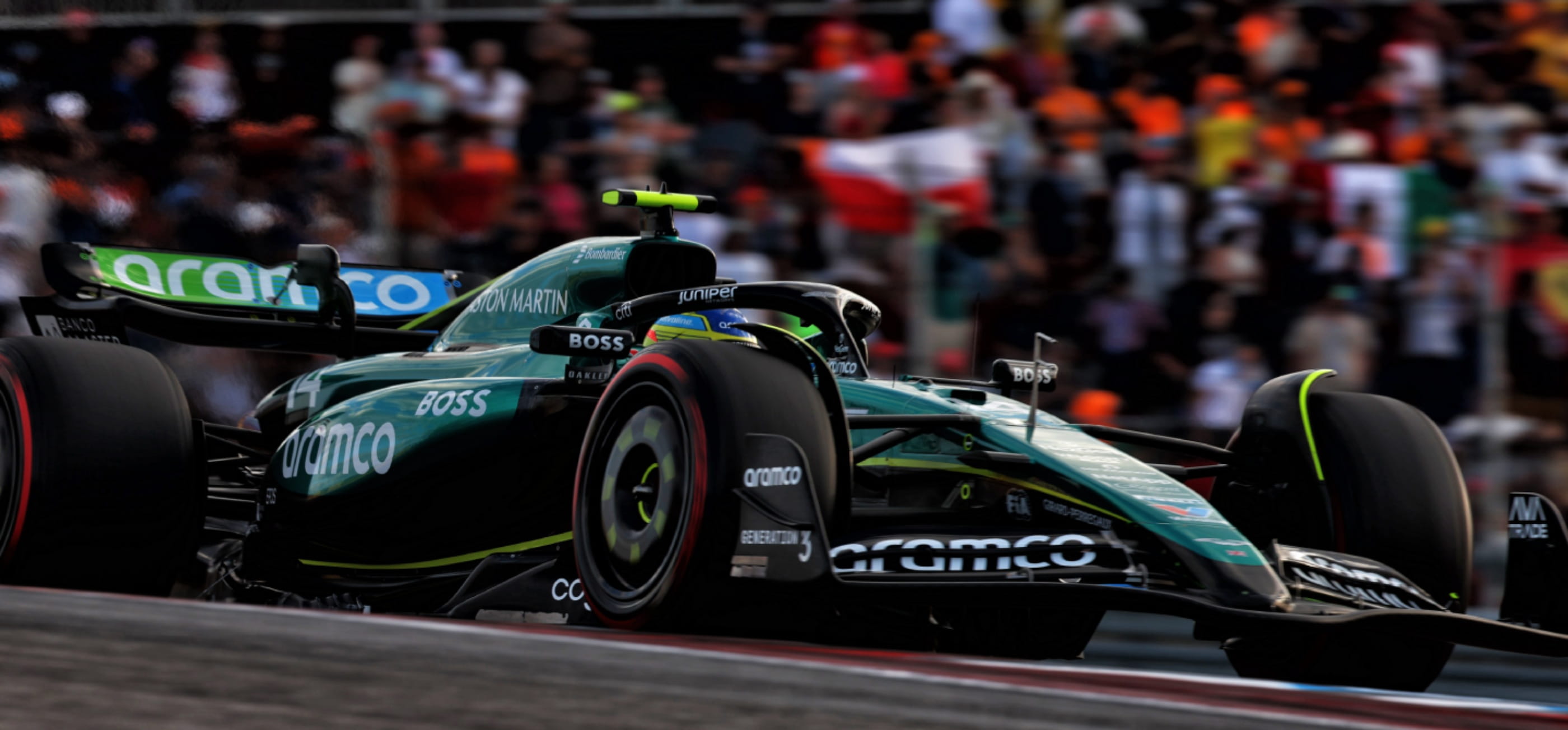
Aston Martin’s latest upgrade fell flat in the United States
Alpine
Alpine, like Aston Martin, brought a new floor body to the car with new details along its floor edge.
The rear of the car - the aforementioned coke bottle section and engine cover - were also reshaped to improve flow underneath the car.
The rear wing was also reprofiled for greater efficiency.
Pierre Gasly ran the bulk of the upgrades at Austin but Esteban Ocon will receive them in coming races. Neither driver scored a point at Austin.
Haas
Haas brought its biggest upgrade since Silverstone in July to the United States Grand Prix, the team's home race.
This included a deeper sidepod undercut to allow for an expanded floor. In turn, the diffuser, floor fences and floor edges were reprofiled.
The team picked up points in the sprint and on Sunday as Nico Hulkenberg finished eighth in the grand prix.
RB
RB made minor changes to its floor geometry – a minor tweak to ensure more consistent aerodynamic load on the car.
Liam Lawson finished ninth on his return to RB but Yuki Tsunoda missed out in the race.
Sauber
A new front wing to control turbulent wake and new suspension sheaths were Sauber's upgrades in Austin. The team remains without points this season after another difficult weekend.
Teams brought a swathe of track-specific upgrades to suit the winding layout of the Marina Bay Street Circuit for the 2024 Formula 1 Singapore Grand Prix.
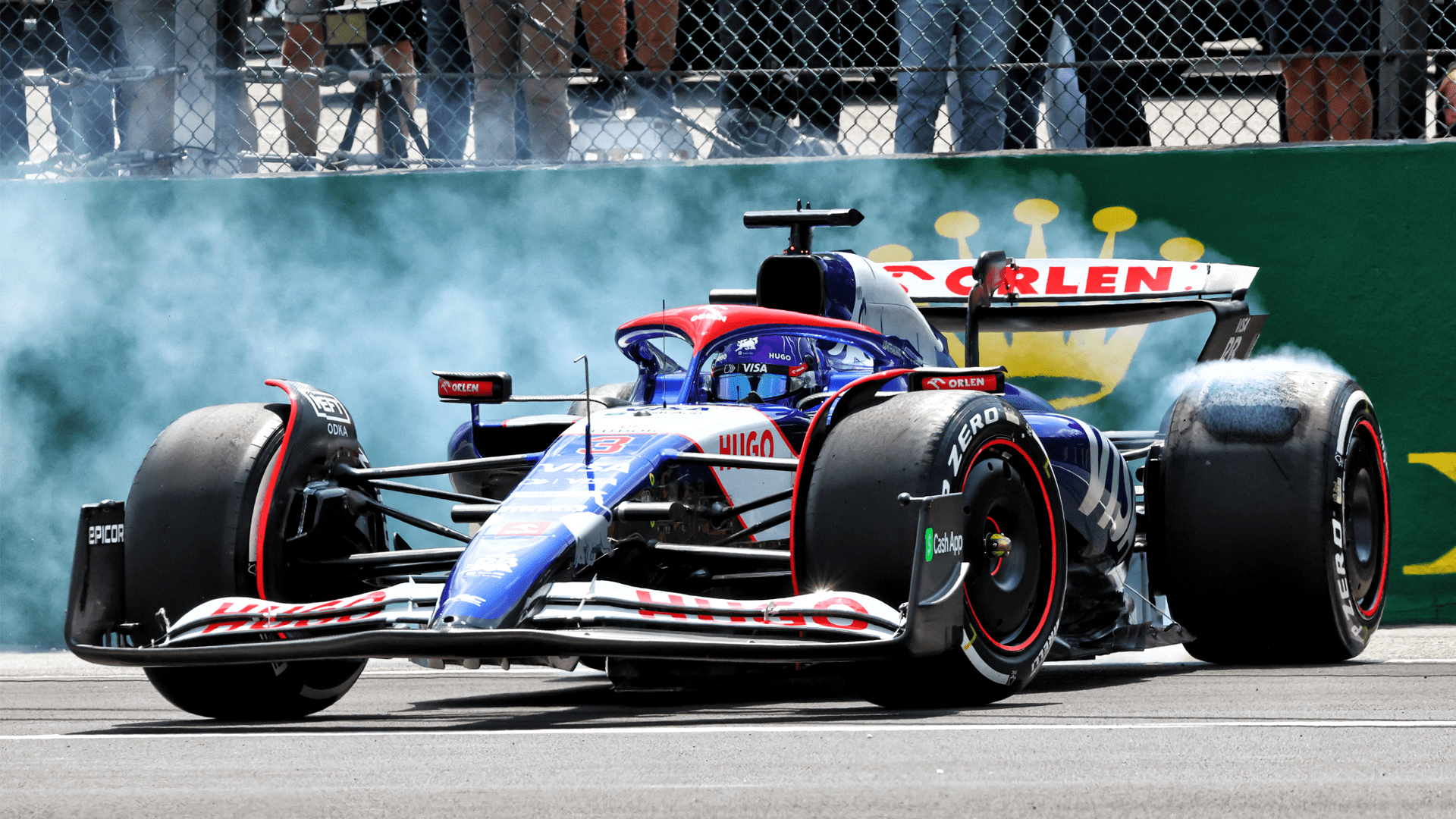
Car, Innovation, Motor
The science behind tyre degradation in Formula 1
Formula 1 2024 upgrades: Teams bring track-specific upgrades to the 2024 Singapore Grand Prix
Most of the developments for the 18th round of the 2024 F1 season centred around front and rear wings, and the areas immediately affected by those wings: brake ducts and suspension fairings.
Here’s what the teams disclosed to the media in Singapore.
McLaren
McLaren reverted to a higher-downforce lower beam wing, which sits under the rear wing, to suit the circuit demands. Lando Norris dominated to win on Sunday while Oscar Piastri finished third - extending McLaren’s constructors’ championship lead to 41 points.
Red Bull
Red Bull increased the exit area of the front brake ducts for better cooling given the high temperatures and hard braking zones at Marina Bay. Max Verstappen managed to take second place and retain a lead of 52 points in the drivers’ standings.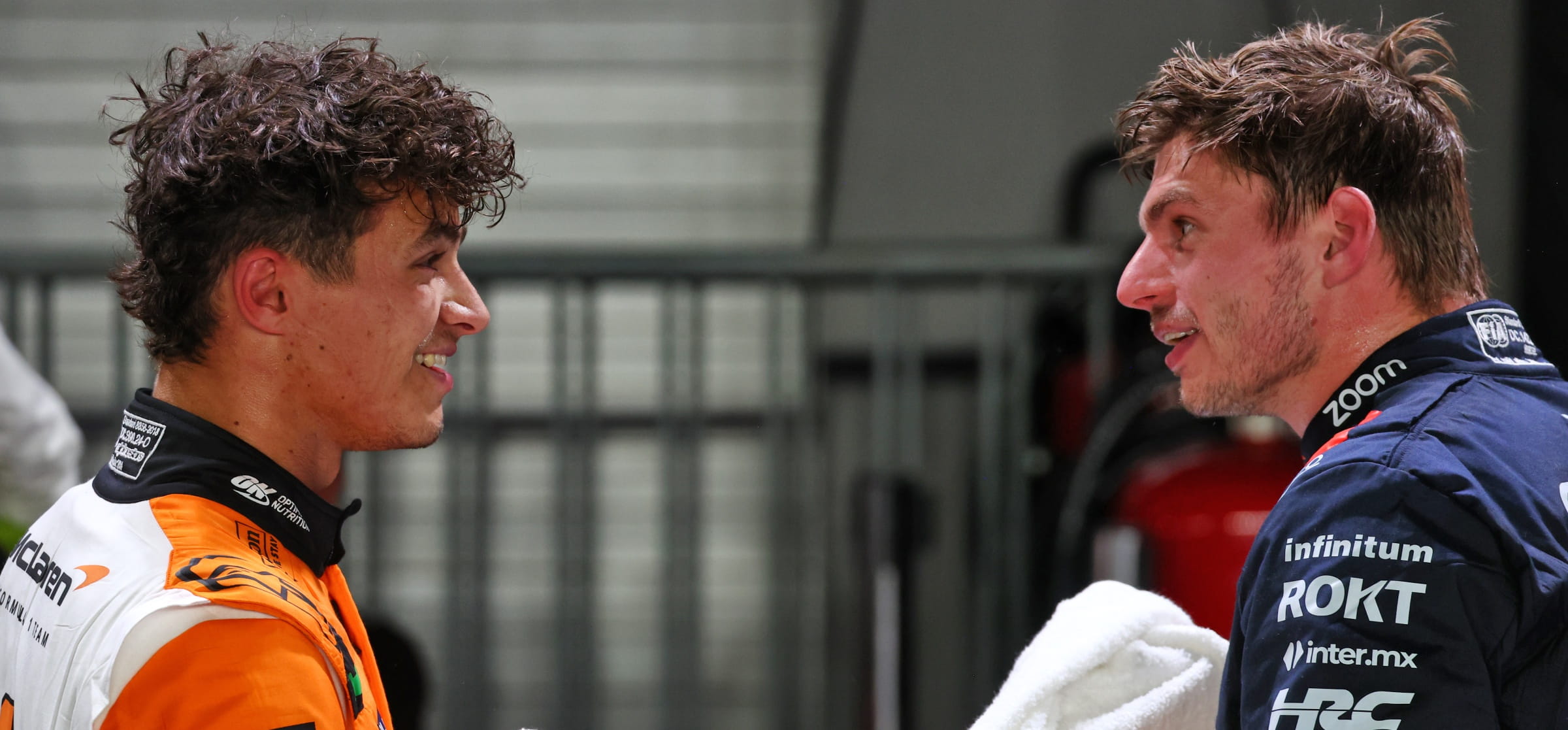
Max Verstappen (right) retained his drivers’ championship lead after finishing second to Lando Norris (left) in Singapore
Ferrari
Ferrari deployed its front wing with different geometry to improve the airflow of the car in “transient” conditions, such as when the car is changing direction. Charles Leclerc finished fifth and his team-mate Carlos Sainz seventh after a poor qualifying session for the Scuderia.
Aston Martin
Aston Martin targeted improved car balance with a more aggressive front wing, generating more load, to suit this street circuit. Fernando Alonso managed to score four points with eighth place.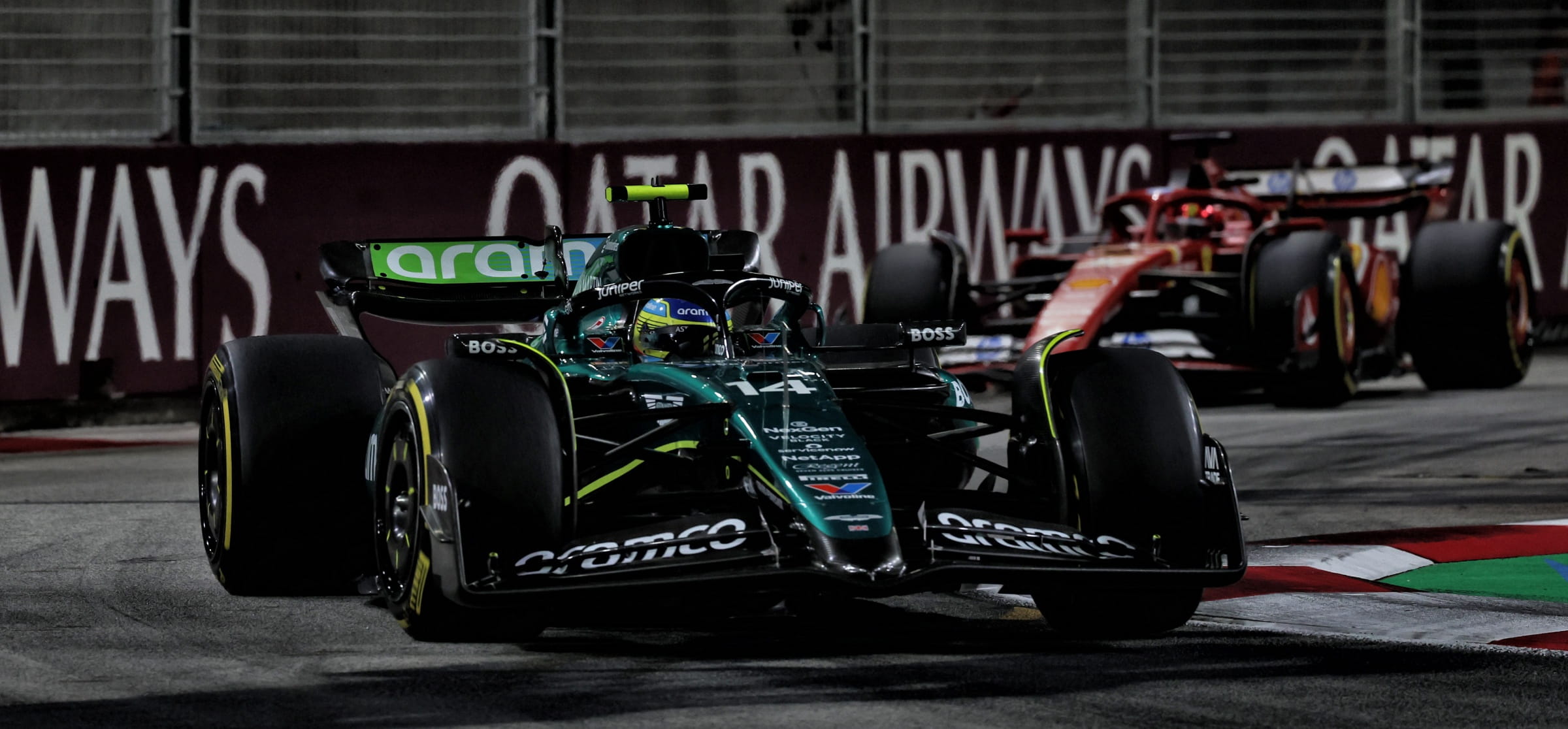
Fernando Alonso finished eighth in Singapore but conceded that Aston Martin have lost ground to their rivals
Alpine
Like Aston Martin, Alpine went for a more aggressive front wing to generate more downforce. Neither driver scored points.
Williams
Having introduced a new package at Zandvoort for the Dutch Grand Prix, Williams optimised the bodywork with new aero sheathing around the front suspension wishbones, trackrod and pushrods. Alex Albon was forced to retire with a power unit issue and Franco Colapinto just missed out on points.
RB
RB followed Aston Martin and Alpine in bringing a more aggressive front wing flap to the track to balance its car around a circuit-specific high downforce rear wing. Daniel Ricciardo set the fastest lap in what could be his final F1 race for RB but neither he nor Yuki Tsunoda scored points.
The 2024 Formula 1 Azerbaijan Grand Prix was a stunning race that at one point had three drivers from three different teams vying for victory - but what upgrades did the teams bring to Baku City Circuit?
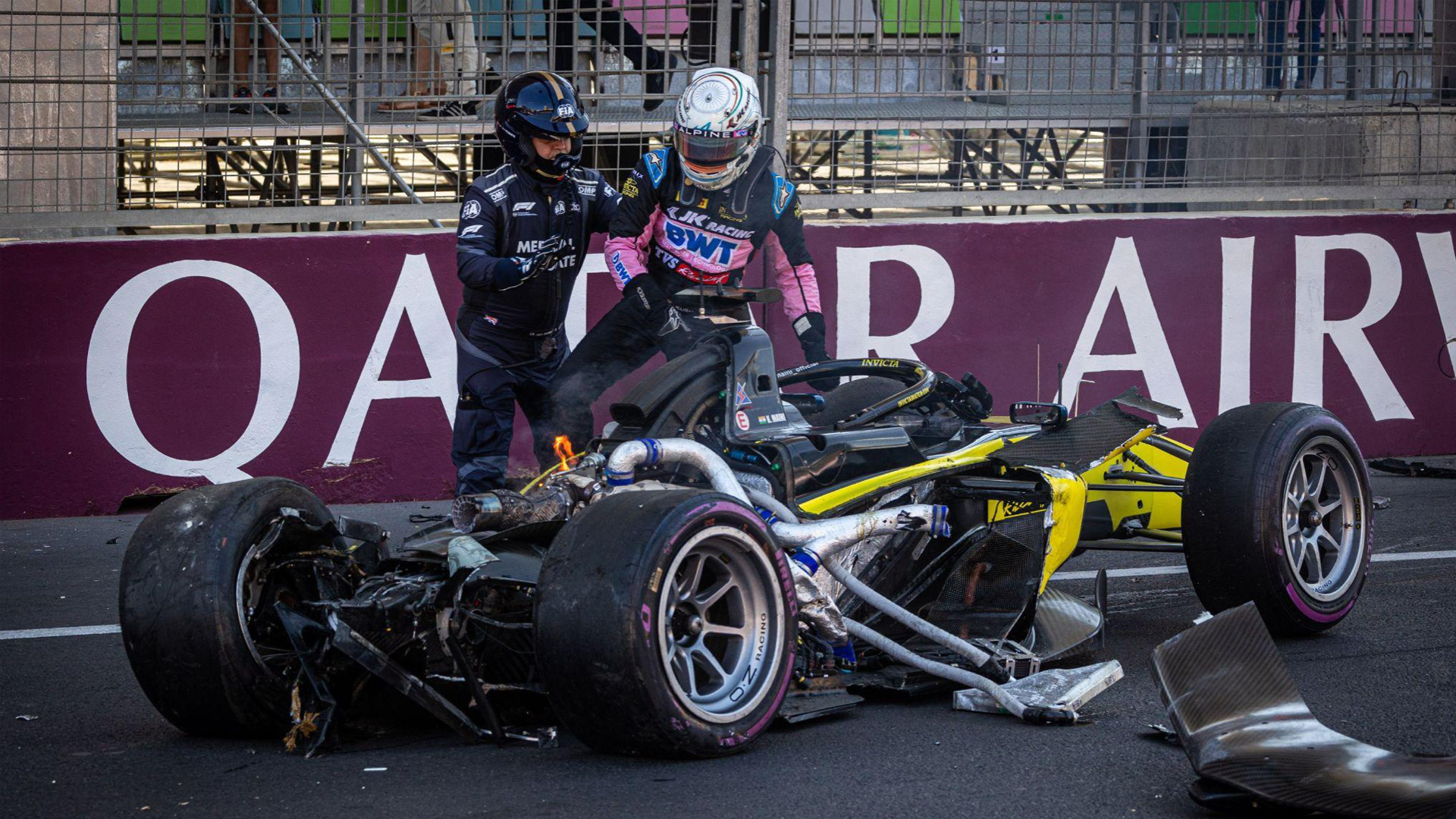
Motor, Innovation, Car, Event
Formula 2 2024 season: Why did a huge crash occur in Azerbaijan?
Mercedes, Red Bull and Aston Martin develop in Azerbaijan
Mercedes and Red Bull reverted to older specifications in their respective quests to find missing performance relative to McLaren and Ferrari, while Aston Martin and RB also made minor changes.
Here’s what teams disclosed to the media about their car upgrades in Azerbaijan.
Mercedes
Mercedes reverted to an older floor specification as part of its ongoing evaluation of upgrades introduced during this season.
The team had introduced a new floor design aimed at improving aerodynamic load and performance, particularly in generating more downforce. However, in previous races such as the Belgian Grand Prix, the team noticed a drop in performance.
It therefore reverted to a pre-Belgium iteration of the floor as it understood this part better. This floor also offered more predictable handling for Lewis Hamilton and George Russell.
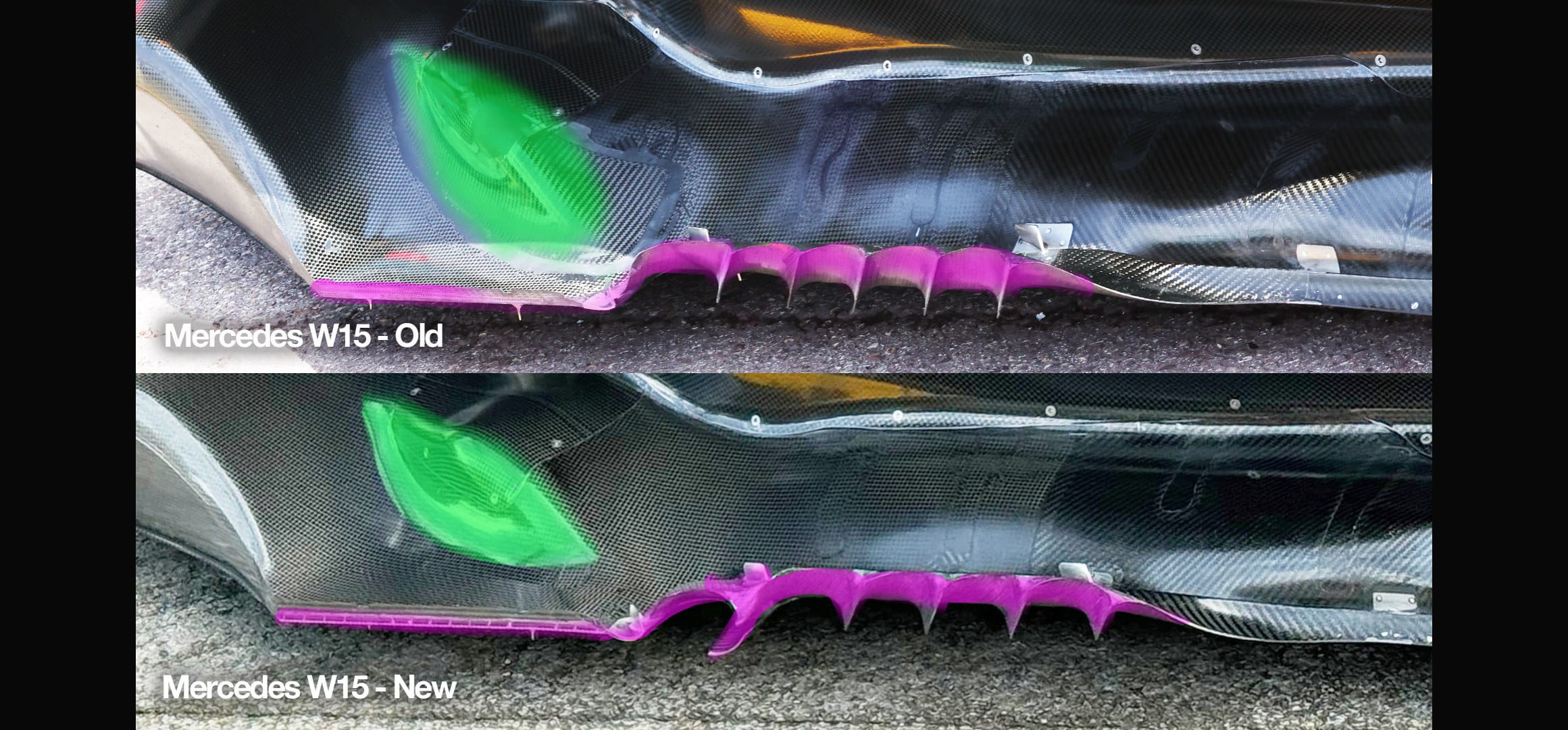
Mercedes used the older spec (above) of floor in Azerbaijan
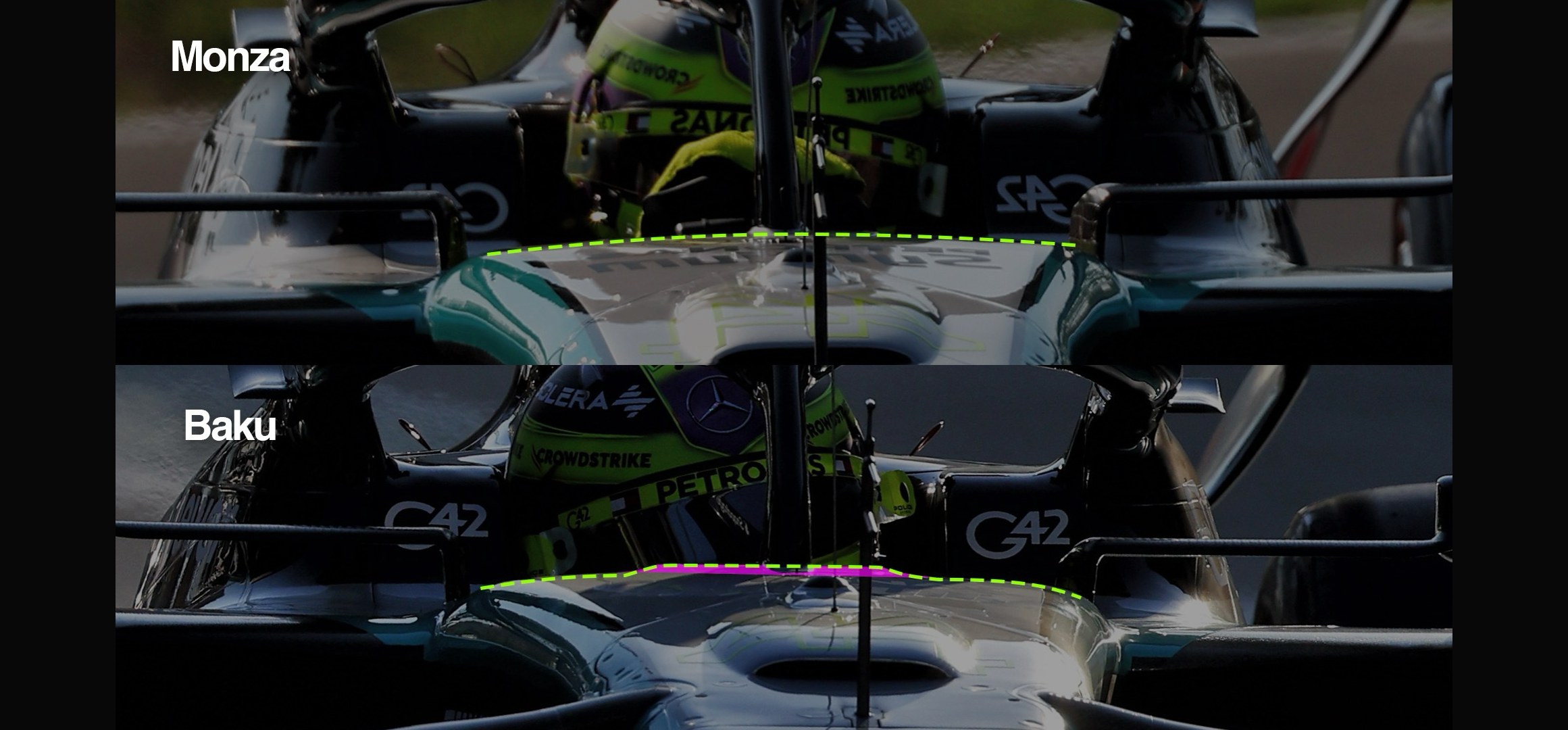
Mercedes also added a small kink under the foot of the halo, in front of the driver, in Azerbaijan
Red Bull
Red Bull altered its floor geometry to improve aerodynamics underneath the RB20 as it aims to claw back performance and hold onto its lead in the championships.
The team will test the floor’s performance at Baku before making adjustments for the next race in Singapore. It plans to bring more significant upgrades to the RB20 in races later this season - perhaps as early as the United States Grand Prix.
However, as the race at Austin includes a sprint, Red Bull might not implement an upgrade there as it’s harder to test the efficacy of updates with just two practice sessions rather than the usual three.
Max Verstappen and Sergio Perez both said the car felt better in Baku but Verstappen blamed a set-up change between third practice and qualifying for harming the balance of the car, and in the race he struggled to fifth place.
Perez meanwhile crashed out late on after battling with Carlos Sainz.
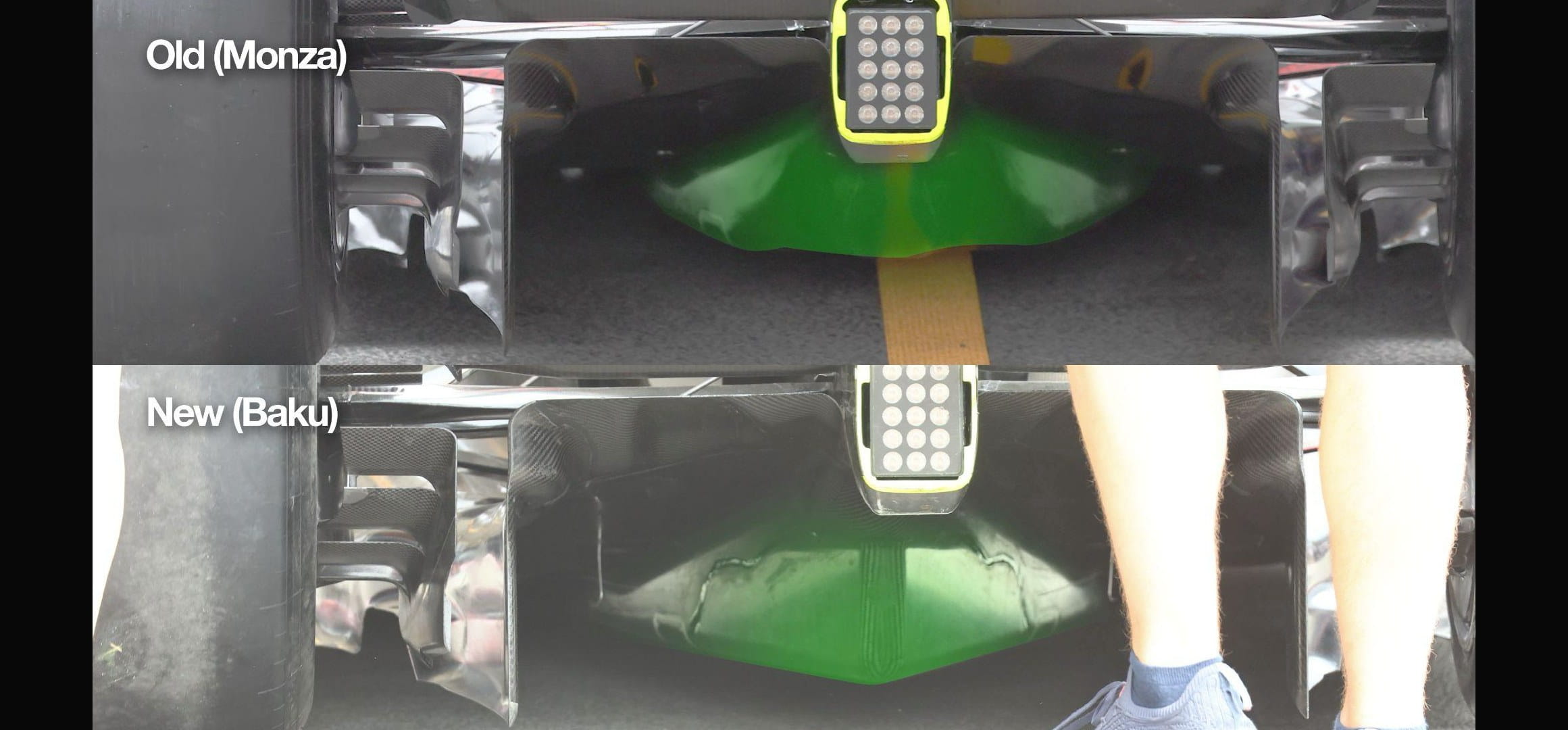
Red Bull’s subtle floor tweak at Baku
Aston Martin
Aston Martin revised the trim around the bottom edge of the rear lower deflector to improve the performance of its diffuser.The team reverted to a previous specification of floor to find some performance in Azerbaijan, and Fernando Alonso ran with a low-downforce set-up to optimise his speed on the straights.
Alonso finished sixth in Azerbaijan.
RB
RB opted for a circuit-specific front wing to work with a low-downforce rear wing to complement Baku’s high-speed nature.
All eyes were on Ferrari at the 2024 Formula 1 Italian Grand Prix, where the Scuderia brought numerous car upgrades in an effort to claw its way back up the grid.
/xpb_1303968_hires/xpb_1309279_hires-(1)/xpb_1312121_hires/xpb_1317176_hires-(1)/xpb_1319965_hires-(1)/xpb1325482hires-1-1.jpg?cx=0.52&cy=0.64)
Event
2024 Formula 1 World Championship drivers' and constructors' standings
Ferrari leads 10 teams in Italian Grand Prix update list
With Monza being a high-speed circuit on which drivers spend more than 80 percent of a qualifying lap on the throttle, teams brought low-drag bodywork to the Italian circuit.
Charles Leclerc won the 2024 Italian Grand Prix for Ferrari to send its home fans into raptures. He pitted once on his way to the chequered flag, a strategy that was helped by Ferrari’s comparative mercy on the front tyres.
Every team disclosed updates to the media at Monza, so there was plenty to sift through.
Ferrari
Ferrari brought the Monza-specific low-downforce rear wing to its second home race of the 2024 F1 season after Imola.
It also debuted a new floor including a reshaped central section underneath and changes to the fences that channel air to the bottom of the car.
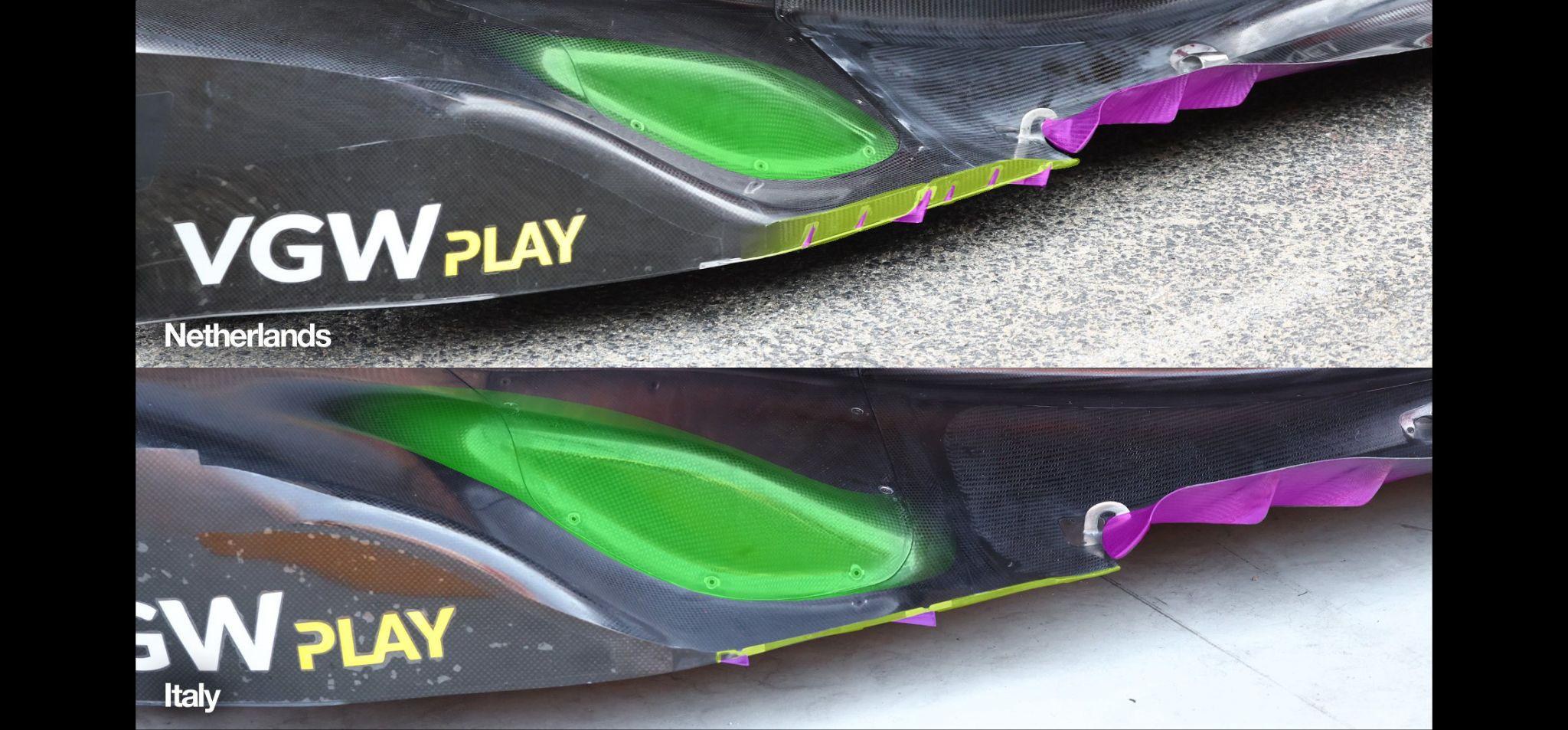
Reshaped areas towards the front of the Ferrari (below) in Italy
Furthermore, the team changed the details of its floor edges, the diffuser, and a slightly bigger undercut underneath the sidepods.
Ferrari also paid homage to carbon fibre with one-off black driver suits and helmet designs for Charles Leclerc and Carlos Sainz.
Leclerc won while Sainz was in the hunt for a podium before tyre wear caught him out and he fell to fourth.

Changes to the floor edges (below) of the Ferrari in Italy
Red Bull
Red Bull returned to its low-drag bodywork package that differs from the high-downforce package used at Zandvoort and Hungary. This means the return of the ‘cooling cannons’ on the side of the engine cover.
The team brought low-downforce wings with smaller planes than usual to Monza as well.
Neither Max Verstappen nor Sergio Perez qualified as well as they had hoped - on the fourth row.
The race was difficult for the team with both drivers noting continued issues with car balance - understeer and unpredictability - as Verstappen finished sixth and his team-mate Perez was eighth.
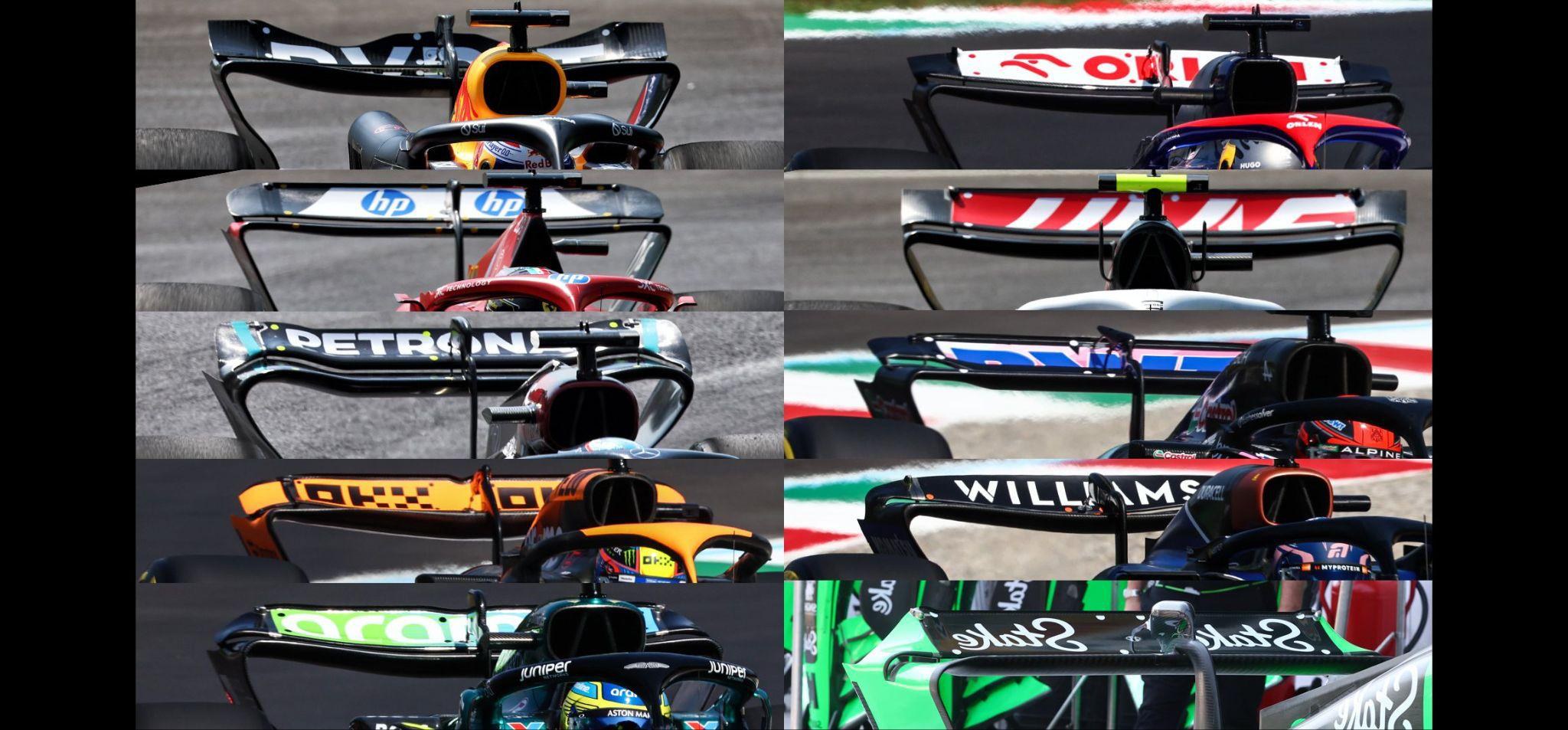
A collage of the F1 teams’ low-downforce wings at Monza. All of them have slimmer main plain and shallower angle to reduce drag
McLaren
McLaren evolved its Zandvoort update at Monza with a new sidepod shape beneath the engine cover, plus a bespoke low-downforce front wing.
The team locked out the front row as Lando Norris took pole.
However, Oscar Piastri overtook Norris on the first lap and then Leclerc scythed his way into second. McLaren opted for a two-stop strategy but it was outfoxed by Ferrari’s one-stop plan.
Mercedes
The Mercedes rear wing was tweaked with a reduced camber angle on the flaps and cutaways at its outer edges - a low drag set-up to account for this high-speed circuit.
As well as the Monza wings, a second phase of the Zandvoort update appeared here – with a new sidepod shape beneath the engine cover.
George Russell qualified third and finished seventh having lost places at the start.
Lewis Hamilton was unhappy to qualify sixth, but he worked his way up to fifth at the chequered flag.
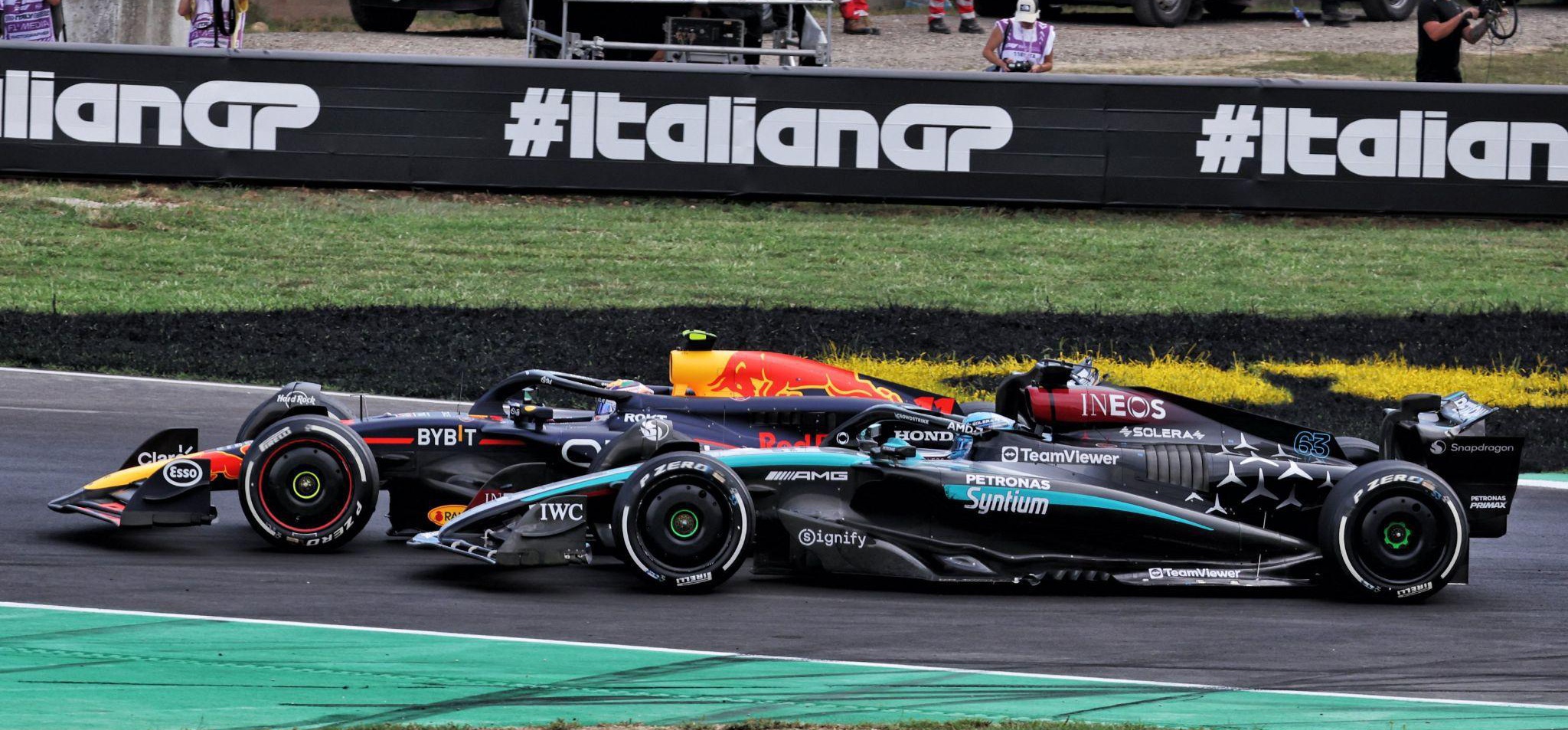
George Russell and Sergio Perez battle for position in the 2024 Italian Grand Prix
Aston Martin
Rear wings that produce less load, plus a new beam wing and a front wing to match that low-downforce specification were Aston Martin's upgrades for the 2024 Italian Grand Prix.
The team did not expect to perform well at Monza and neither Fernando Alonso nor Lance Stroll scored points.
Alpine
Having struggled with car balance at Zandvoort, where Esteban Ocon complained of oversteer, Alpine fared better in the Netherlands although neither driver scored points.
Pierre Gasly was involved in a collision with Kevin Magnussen for which the Haas driver was given a 10-second penalty and two penalty points on his superlicence. As he has now accrued 12 points in a 12-month period, Magnussen will miss the next race of the season at Baku, Azerbaijan.
RB
Along with low-downforce wings for both cars, a new floor was fitted to Yuki Tsunoda’s car at Monza and the Japanese driver was unhappy with the balance of his car as he qualified 16th for the race.
Tsunoda was the only retiree from the race after a collision with Haas’s Nico Hulkenberg at the start.
Daniel Ricciardo, meanwhile, was 13th and expressed that RB has more performance to find.
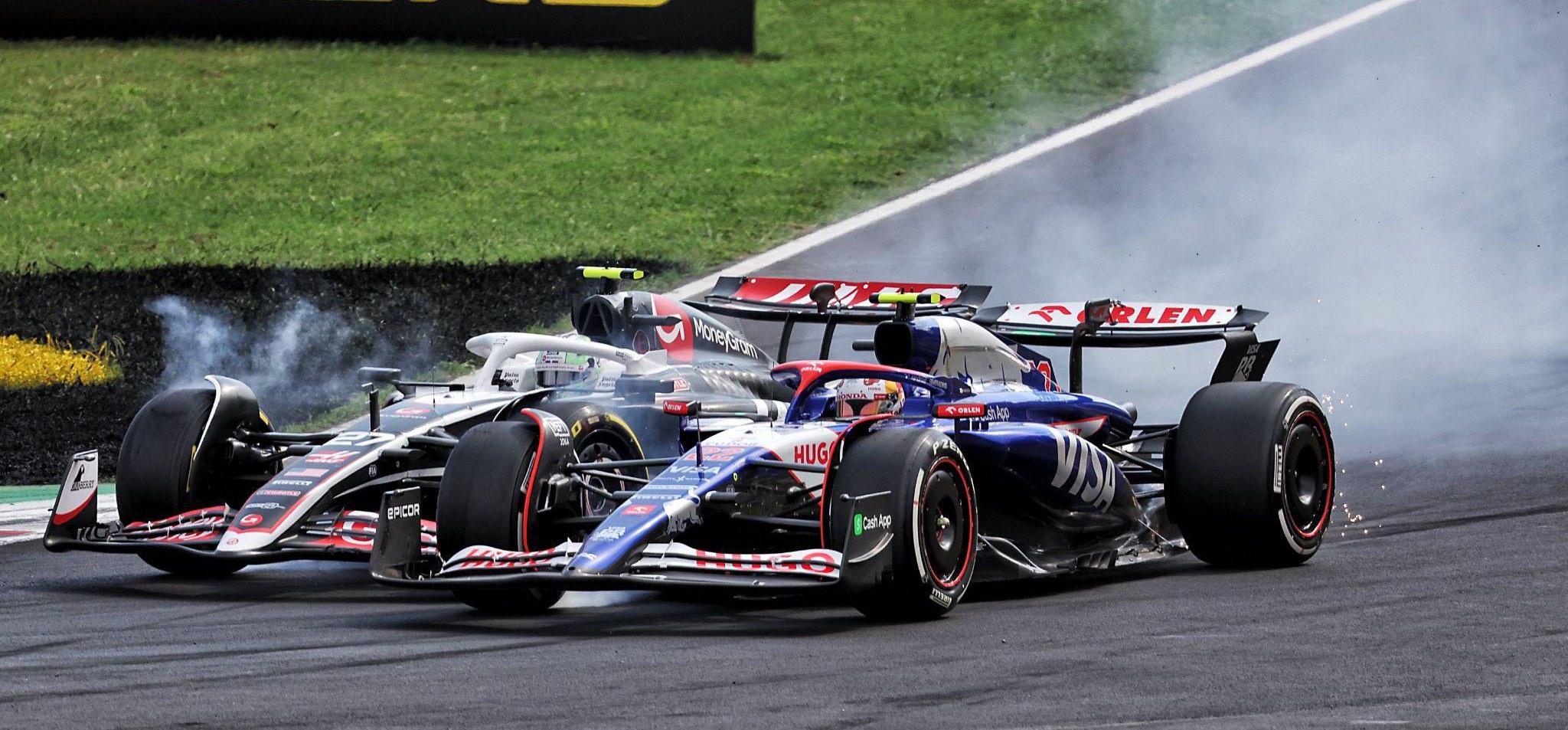
Haas’s Nico Hulkenberg collides with RB driver Yuki Tsunoda at the start of the race at Monza
Sauber
Sauber brought a more extensive upgrade package to Monza with a new forward floor for increased load and a slightly revised diffuser to accelerate flow through the tunnel underneath the car.
Neither Valtteri Bottas nor Zhou Guanyu scored as Sauber continues its point-less run.
Haas
A front wing flap suited to Monza was paired with new sheathing around the front suspension.
Magnussen scored a point with a one-stop strategy, despite taking a 10-second penalty and penalty points on his licence.
Hulkenberg also received a 10-second penalty after colliding with Tsunoda and he finished 17th
Williams
Williams removed part of its front wing endplate and reduced the angle of the wing, balancing it with a low-downforce rear wing.
Alex Albon scored two points in ninth place while Franco Colapinto finished a solid 12th on his debut.
McLaren and Williams brought substantial upgrade packages to their cars for the 2024 Formula 1 Dutch Grand Prix in the Netherlands, while Red Bull reverted to a previous specification of bodywork.
McLaren and Williams bring new parts to the Dutch Grand Prix
McLaren
The floor, suspension and wings of the McLaren were reshaped at Zandvoort.
New floor edges were brought to increase local load (increasing downforce produced in that specific area) and the performance of the floor overall.
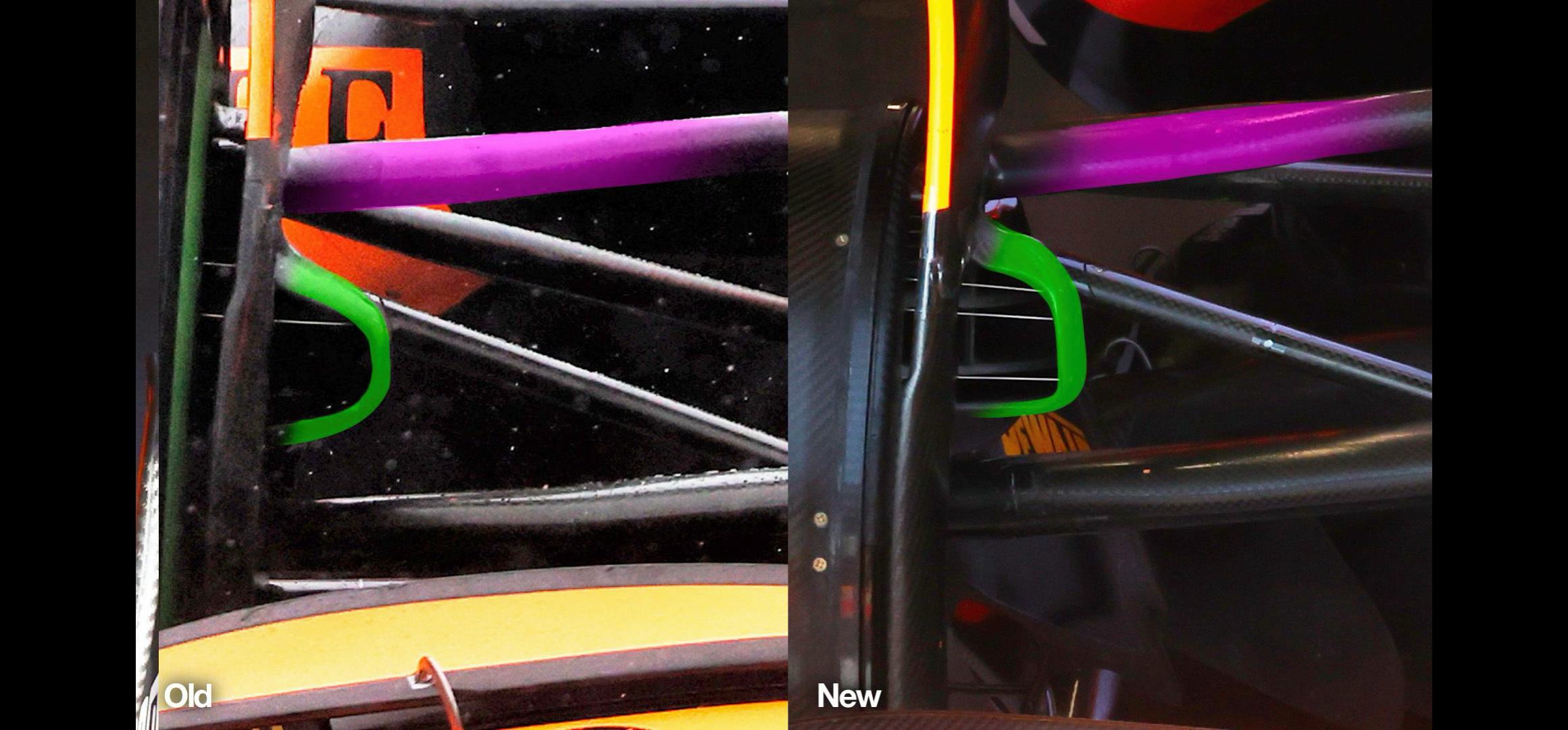
Reshaped suspension was part of McLaren’s upgrade package at Zandvoort

McLaren’s new wing and beamwing (below) shown together in this comparison. The team brought a new higher-downforce package to the Netherlands this weekend.
Williams
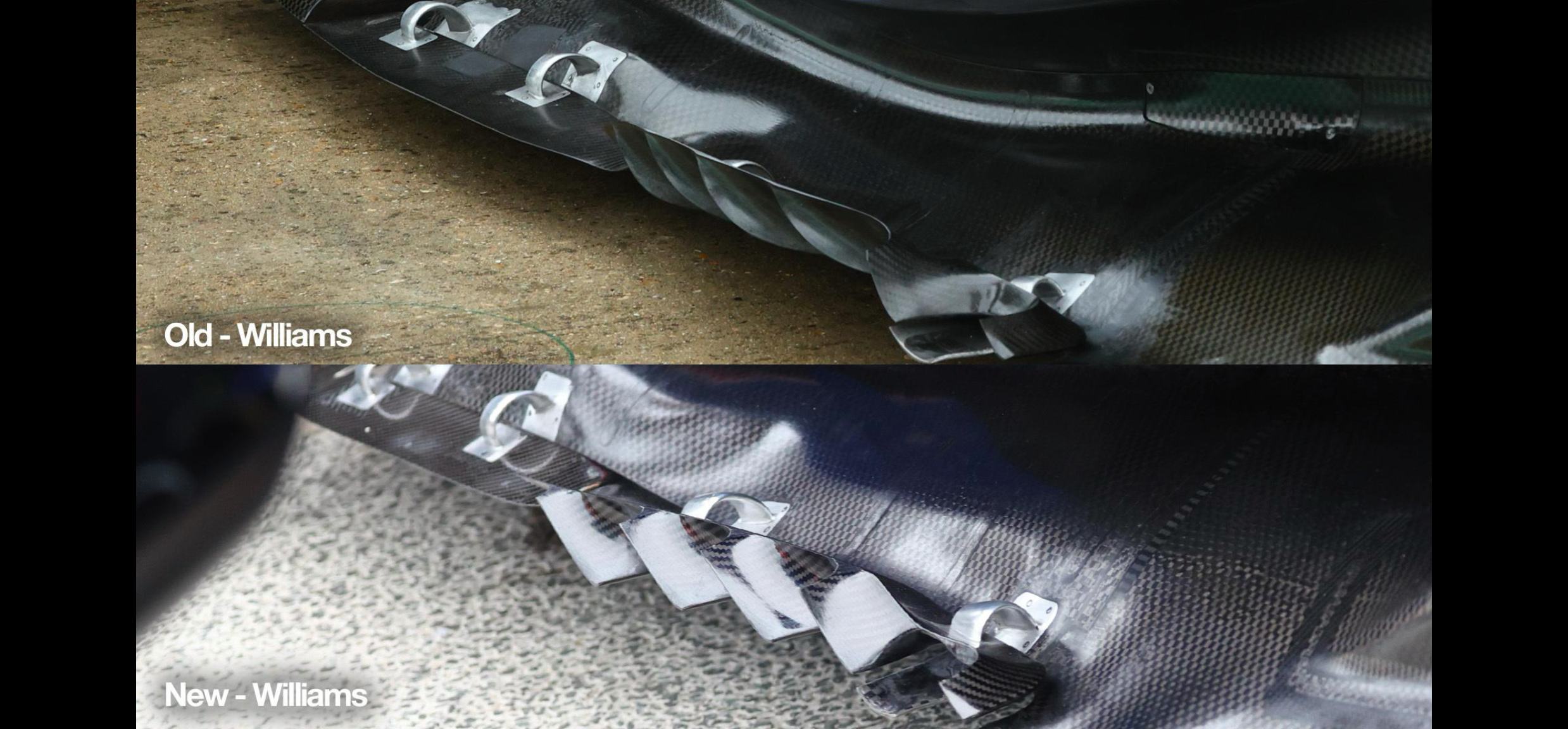
New floor vanes on the Williams (below) in the Netherlands
Red Bull
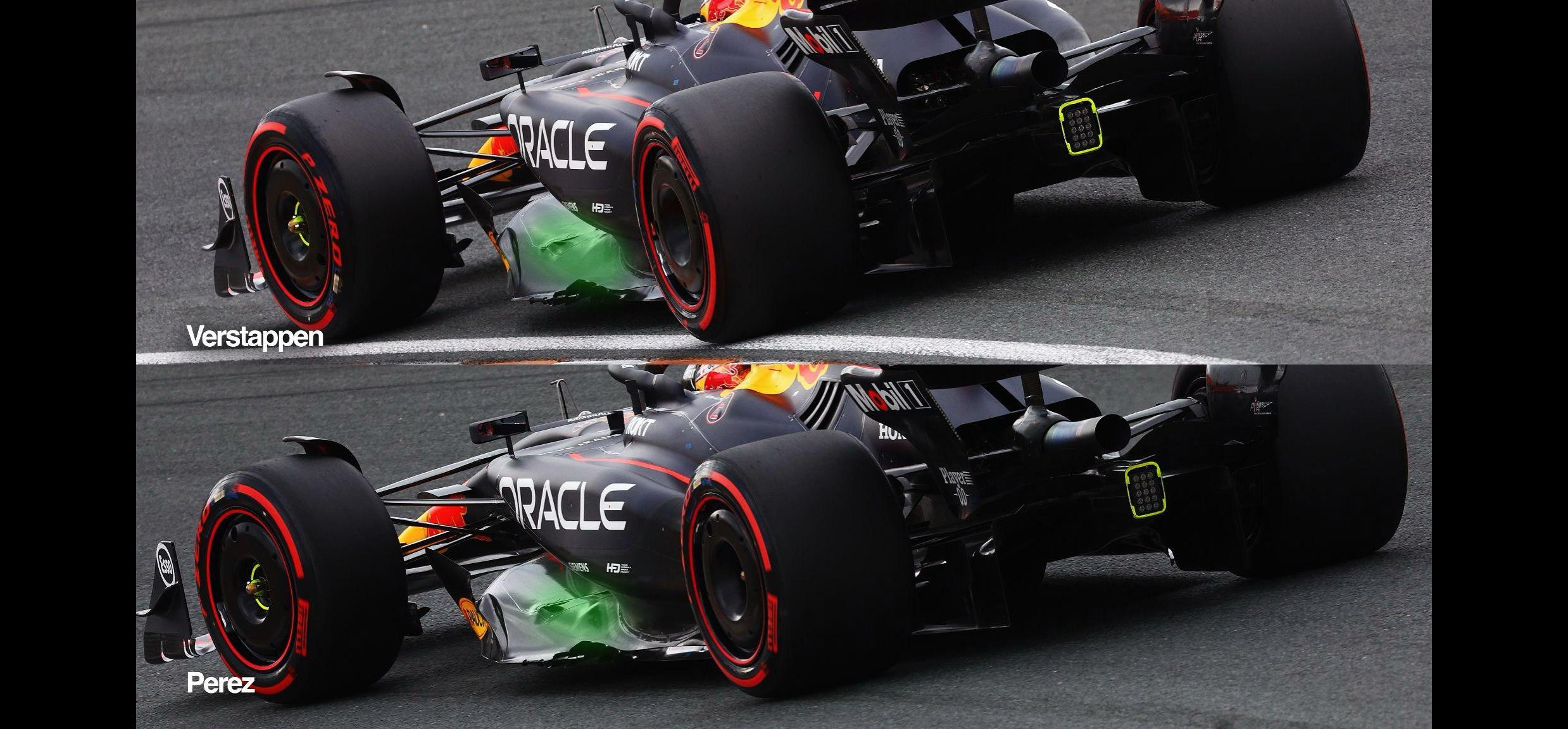
Max Verstappen ran an older specification of floor at Zandvoort while Sergio Perez raced with the new floor
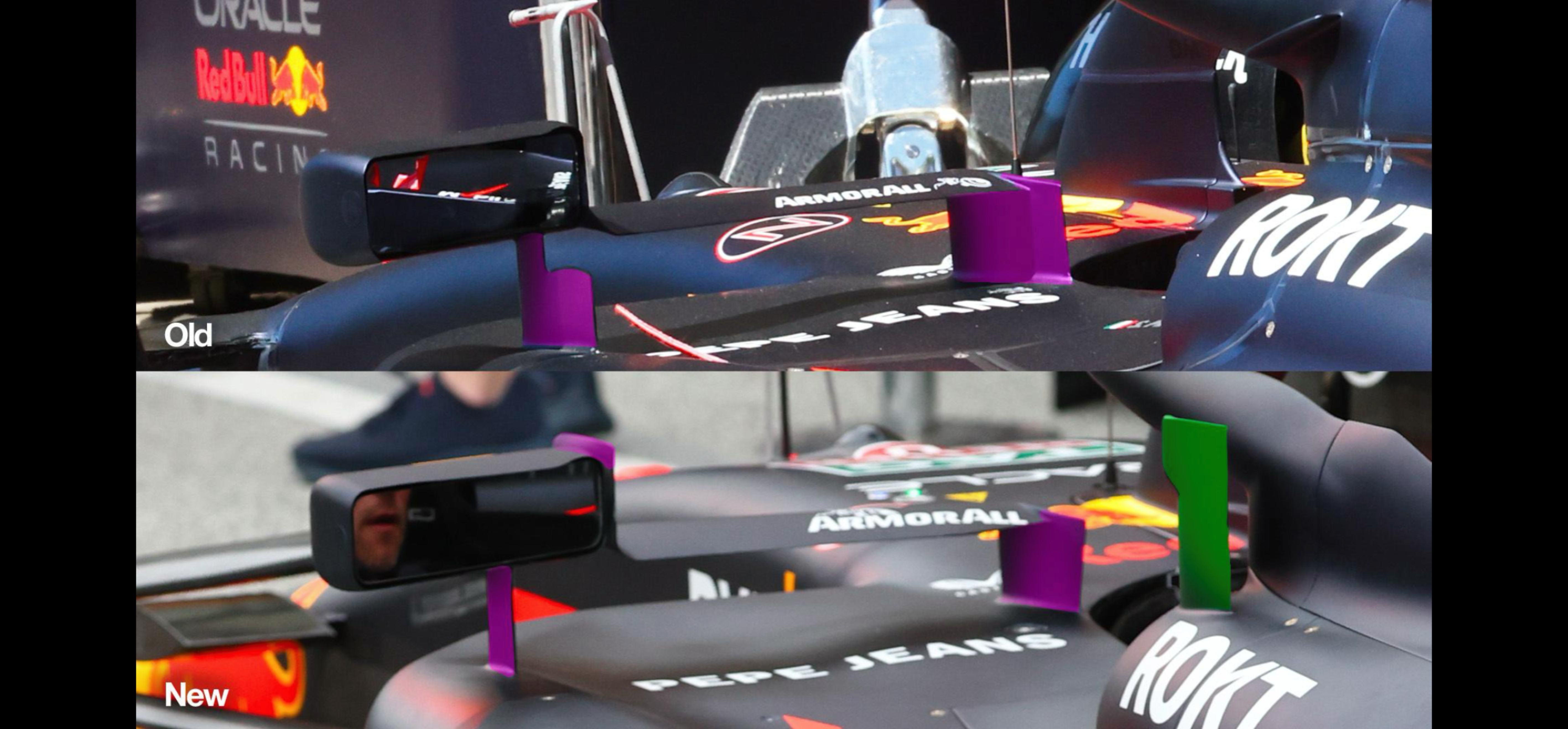
Haas
Alpine
RB
Mercedes, Alpine and RB led the list of teams that brought upgrades to the 2024 Belgian Formula 1 Grand Prix at Spa-Francorchamps, but the situation turned out to be more complicated than that.
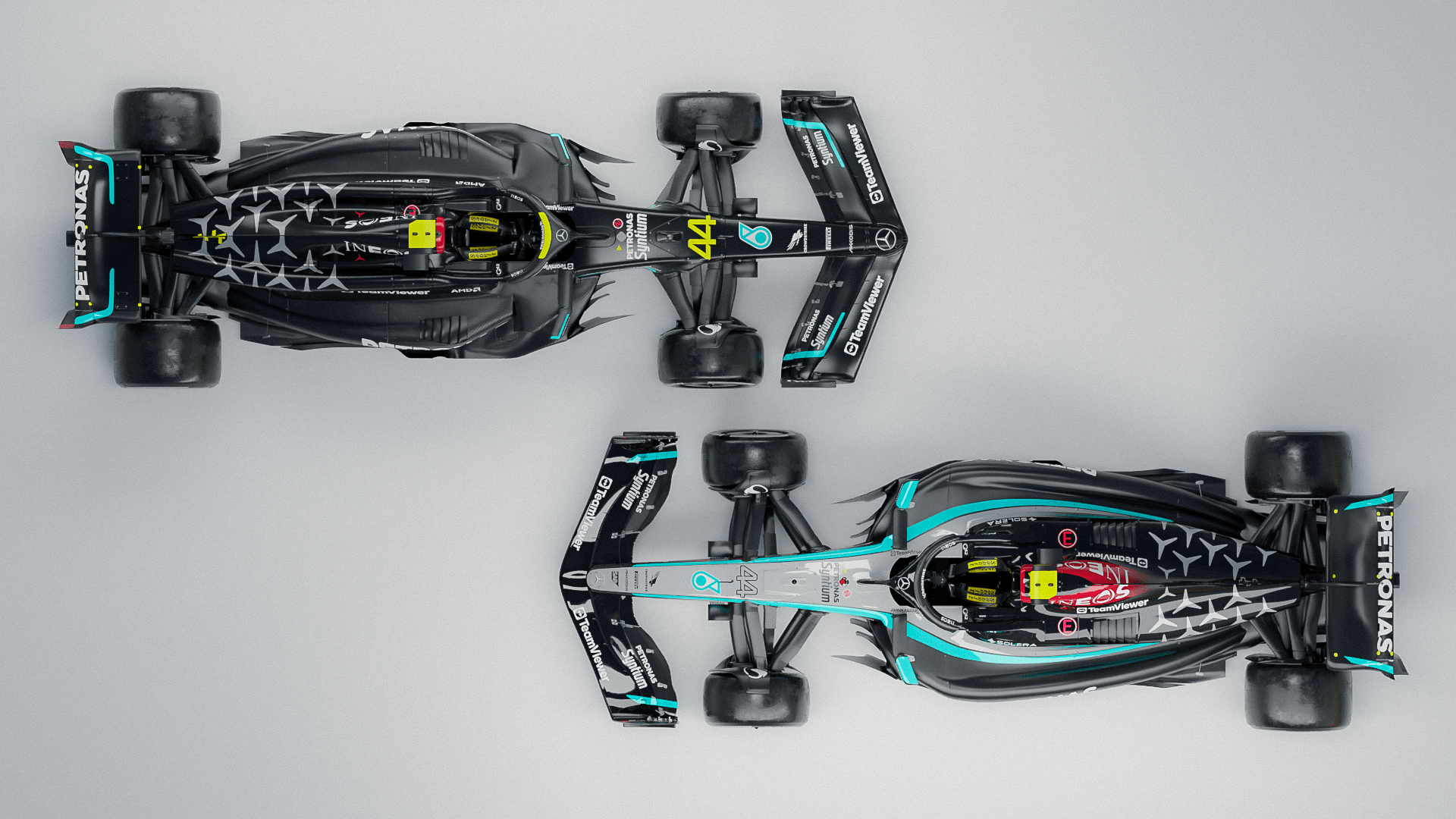
Car
Mercedes W15: Why the F1 team has struggled with innovative car – and how it differs from W13 and W14
Mercedes leads upgrades list for the Belgian Grand Prix
Mercedes brought a new floor to the track but ended up rolling back to the previous specification on Saturday while Red Bull - who had overhauled Max Verstappen’s car in Hungary - reverted to a previous specification as well.
Meanwhile Alpine, who had brought circuit-specific changes to account for Spa-Francorchamps’s low-downforce demands, split set-ups between the cars of Esteban Ocon and Pierre Gasly.
The likes of McLaren and Ferrari also brought track-specific upgrades to meet the demands of the high-speed layout at Spa.
Here’s what the teams disclosed to the media in Belgium.
Mercedes
The floor and the diffuser of the W15 were the main focal points of Mercedes’s drive to upgrade its car in Belgium. Further changes disclosed to the media included a new element to the floor-edge wing - to create additional load on the forward part of the floor - and a change to the angle of the diffuser roof at the rear of the car.George Russell and Lewis Hamilton used the new floor in Friday practice but both suffered from bouncing and car balance issues - ending up more than a second off the pace in Free Practice 2.
The Silver Arrows then reverted to the previous floor design ahead of third practice at Spa-Francorchamps.
.jpg?cx=0.5&cy=0.5)
Comparison showing the new Mercedes floor (below) and the previous specification (above) that the team reverted to on Saturday in Belgium
Russell said: "It was important for us to revert to something we know, and see, in the race, if it's a challenge with Spa for us, which I'm pretty confident it is - as opposed to the upgrade.
“So, the upgrades were nothing substantial; it’s just part of the development over the course of the year. And it gives us time now to sort of review all the data from yesterday [Friday practice] and go from there. But I’m pretty confident those upgrades were working as expected.”
Mercedes also brought a low-downforce rear wing and smaller front wing elements to account for Spa-Francorchamps’s lower-drag demands.
Russell took the chequered flag but was later disqualified as his car was underweight after fuel was taken out for compliance checks, promoting Hamilton to his second win in three rounds.
.jpg?cx=0.5&cy=0.5)
George Russell was disqualified in Belgium as the car was found to have been underweight during post-race checks
Alpine
A one-off movie-themed livery complemented wide-ranging changes to the Alpine A524.
The team reprofiled its front wing flap elements to account for lower-downforce circuits, with similar changes made to the rear wing, which had a lower camber at Spa. The beam wing was also modified to account for the new low-downforce rear wing.
The engine cover was redesigned to improve overall internal cooling efficiency. The inlet and exit ducts at the rear corner were also redesigned for a similar purpose.
The sidepods of the A524 also appeared to have changed in Belgium.
Alpine made the decision to put the higher-downforce package, with a larger rear wing plane, on Gasly’s car while Ocon ran the lower-downforce package.
“Today was absolutely terrible down the straights,” said Gasly after finishing 14th and 14 seconds behind 10th-place Ocon (with both drivers promoted after Russell’s disqualification).
Gasly however clarified that part of that deficit was down to an engine issue.
“I ended up losing seven tenths every lap with some engine temperature issue. It’s just very frustrating.”
.jpg?cx=0.5&cy=0.5)
Comparison showing a slightly new engine cover and sidepod shape to the Alpine A524 in Hungary
Red Bull
Red Bull did not disclose any upgrades to the media but the major upgrade package it had brought to Hungary - which did away with the ‘cooling cannons’ on the engine cover of the car - weren’t brought to Belgium.
Instead, Red Bull’s car more closely resembled the RB20 that raced at Silverstone.
“I won’t say that they [the upgrades brought to Hungary] didn't work, but maybe we didn't extract everything out of it,” said Verstappen in Belgium.
This decision implies that the team could pursue a parallel upgrade path, using its Hungary-spec car at high-downforce circuits such as Singapore, while retaining its other specification of car for circuits such as Monza, Qatar, and Abu Dhabi.
Verstappen took fourth place and his team-mate Sergio Perez finished seventh with the fastest lap bonus point at Spa-Francorchamps.
Ferrari
The Ferrari SF-24 was fitted with lower-downforce front and rear wings to suit the layout of Spa-Francorchamps.
Charles Leclerc secured the final podium place while his team-mate Carlos Sainz took sixth in Belgium.
McLaren
McLaren also brought circuit-specific changes to Belgium: a low-downforce rear wing, a beam wing to match, and ‘furniture’ around the rear brake ducts to match.
Oscar Piastri finished second to Hamilton and Lando Norris finished fifth, narrowly behind Verstappen, in Belgium.
RB
Three circuit-specific changes were made by RB at Spa.
The rear corner winglets were replaced with a different arrangement to reduce downforce and drag.
Meanwhile the rear wing was profiled to reduce drag - and an extra plane was added to the beam wing to achieve the same goal.
Neither driver finished in the points.
Sauber
Sauber brought further changes to its car to optimize its continued development.
The mirrors were reshaped to provide better flow control and quality for the rear end of the car.
Meanwhile, the floor fences were reworked to generate more local flow and complement the rear end.
The front wing, rear wing and beam wing were all redesigned for Spa’s low-downforce demands.
Sauber remains the only team yet to score a point this season before the 2024 Dutch Grand Prix.
Haas
Haas also brought circuit-specific upgrades to Spa: a new beam wing and rear wing, but Kevin Magnussen and Nico Hulkenberg finished 14th and 18th, respectively.
The Hungarian Grand Prix, the 13th round of the ongoing Formula 1 season, was a logical place at which to wheel out track-specific and general upgrades.
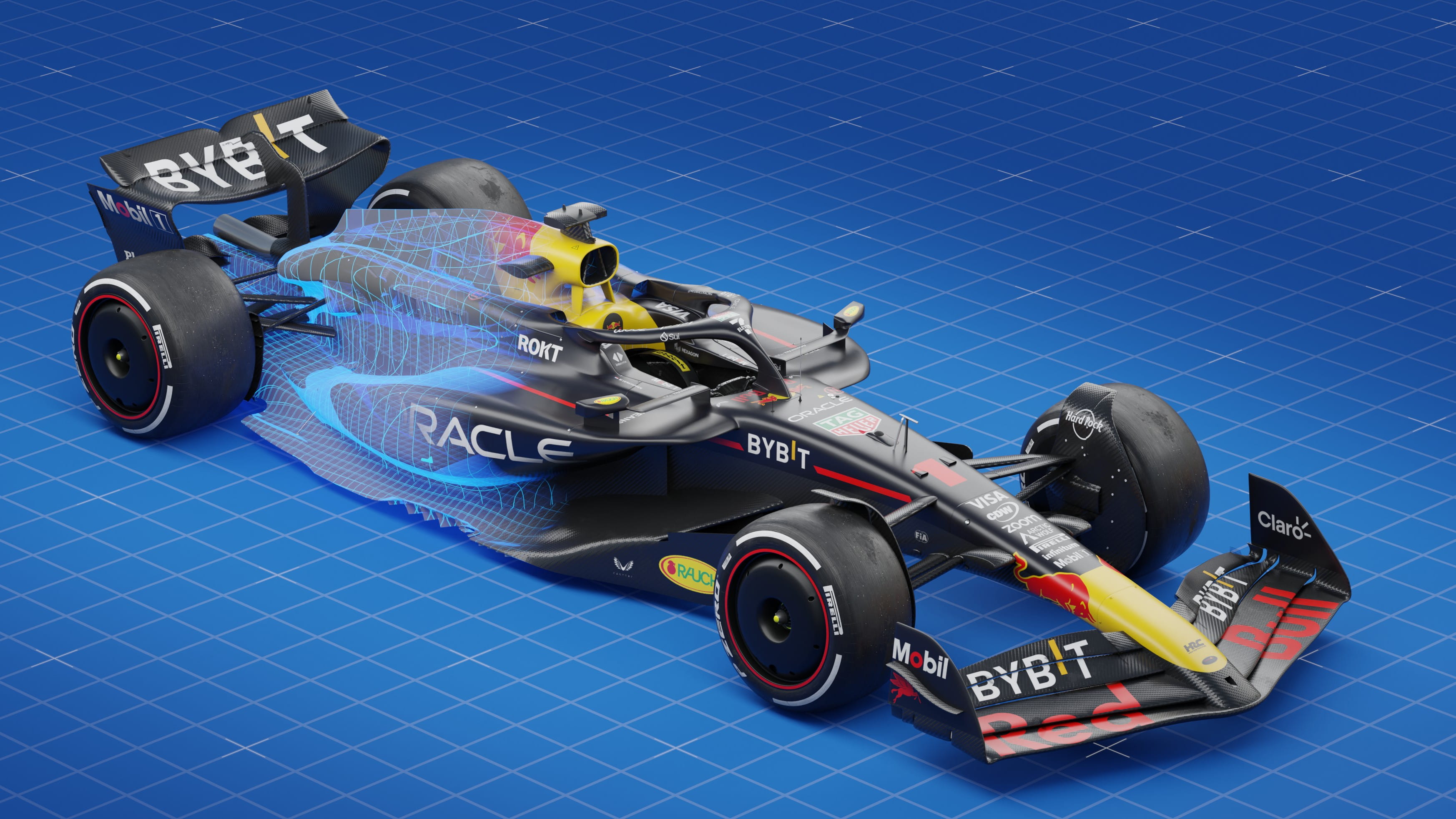
Car, Motor
Inside the revolutionary Red Bull RB20 F1 car
Max Verstappen runs new-spec Red Bull in Hungary
Red Bull
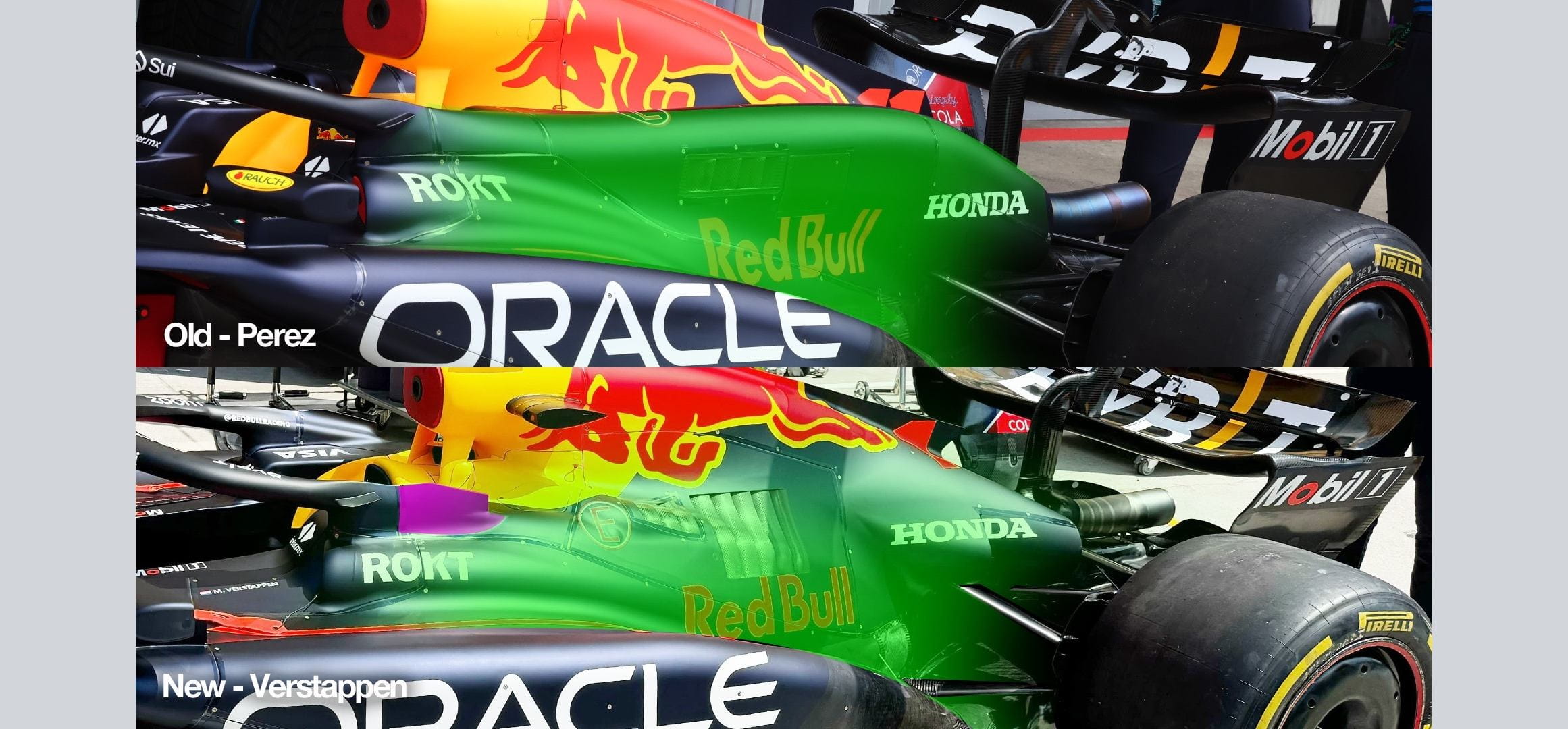
Comparison showing the new Red Bull RB20 engine cover run by Max Verstappen (below). The new engine cover does away with the 'cooling cannons' (above)
The fairings on the halo rearward mounts have been adjusted accordingly "to eliminate mismatches in the local surfaces".
But that's only part of what was a major upgrade package, that also included changes to the wheel bodywork, a reprofiled front wing and a new shroud profile on the front suspension's lower wishbone forward leg. Those parts, unlike the new bodywork, were also on Sergio Perez's car.
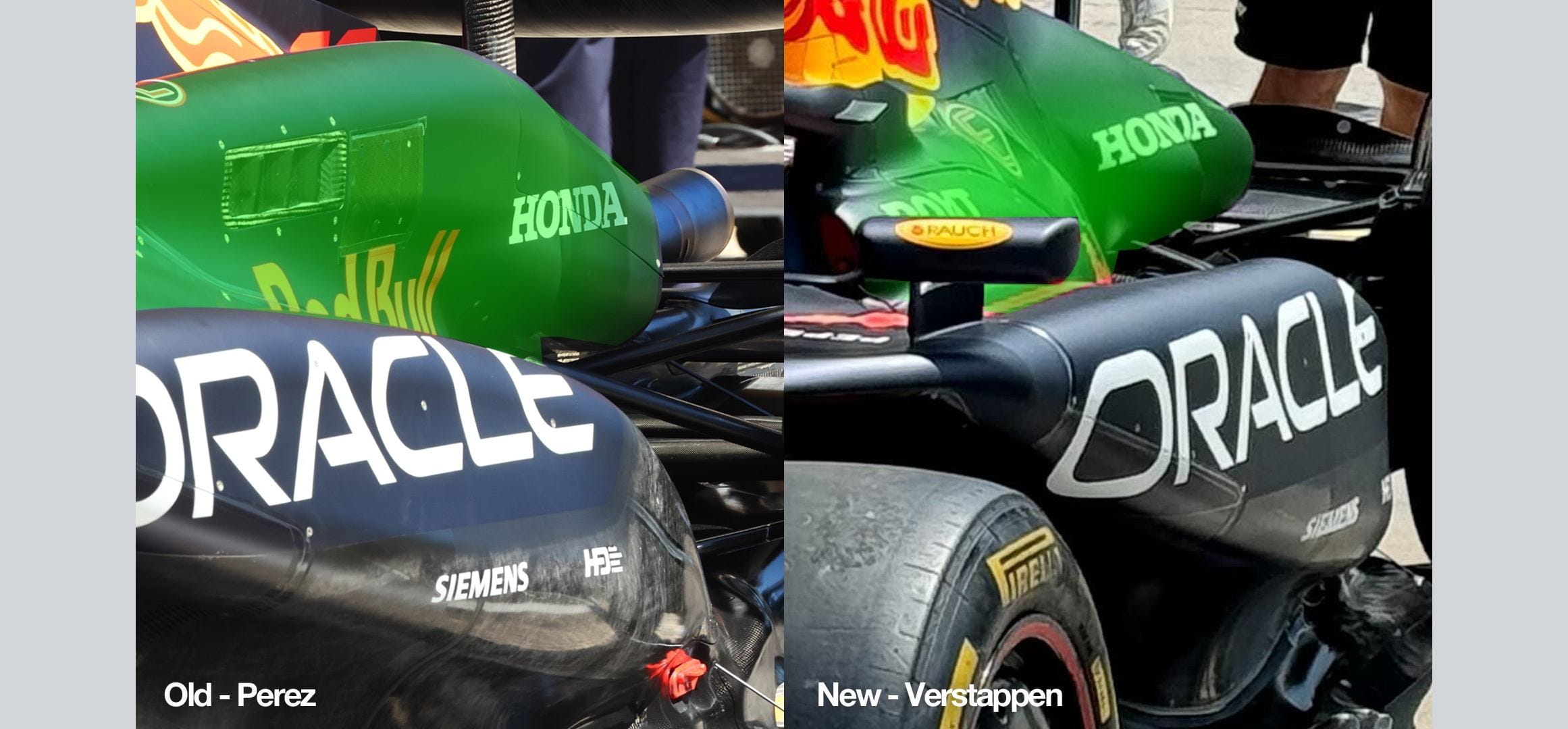
Another view of the changes to the body of the Red Bull RB20 in Hungary, with Max Verstappen (right) using the new spec
.jpg?cx=0.5&cy=0.5)
Red Bull also made changes to the rear part of its floor in Hungary
Aston Martin
Sauber
Ferrari
Mercedes
Cooling changes
Most Formula 1 teams tweaked their cars to account for Silverstone’s high-speed layout - but Ferrari took a differing approach at the 2024 British Grand Prix.
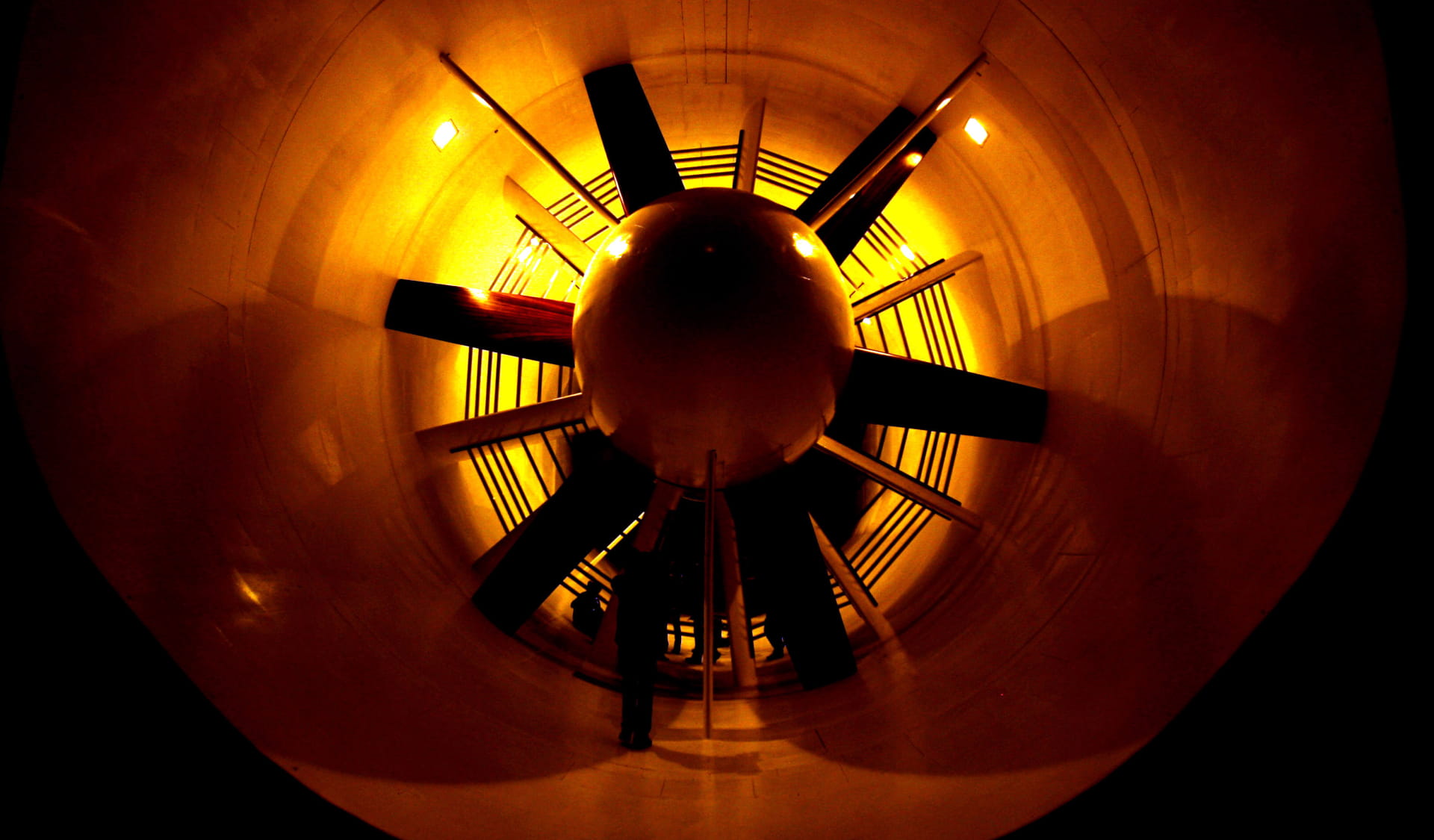
Innovation
Ground effect in F1: How aviation pioneers sparked a motorsport revolution
Ferrari takes a step backwards for the British Grand Prix
Ferrari
.jpg?cx=0.5&cy=0.5)
“We've lost some performance since Monaco, as a matter of fact, and we are looking into it; that's also why we are doing all these tests,” said Leclerc. “We came to the conclusion that it was the right choice to come back for this weekend mostly because of bouncing.”
After qualifying seventh, Sainz said the choice to revert “hasn't given us any extra performance; it's just given us a little bit more consistency in the high-speed given we have a bit less bouncing on that floor, and we need to make the car as consistent or predictable as possible in the high-speed knowing that, obviously, we're not going forwards or backwards - we're just making the car a bit more consistent.”
Despite Ferrari coming away from Silverstone with just 11 points - its second-worst weekend this season, barring the non-scoring Canadian GP weekend - 14th-placed Leclerc said it was the “right choice” to revert specification.
“At a track like this we decided it was probably better having a bit less performance but having more consistency and I think it was the right choice. Going forward we’ll analyse the data of the two packages and see if there’s anything we didn’t understand with the new one,” said the Monegasque driver.
.jpg?cx=0.5&cy=0.5)
Carlos Sainz (above) used the old specification of Ferrari during Friday practice at Silverstone while Charles Leclerc (below) tested the latest version
Red Bull
Red Bull made tweaks to the floor edge and floor edge winglet at Silverstone to induce more load. Both Sergio Perez and Max Verstappen damaged their floors in separate incidents during qualifying, which required spares of the same specification to be fitted and in particular cost Verstappen a shot at pole position on Saturday.
However, Verstappen came away with a second-place finish on Sunday, ensuring Red Bull is still 71 points ahead of Ferrari in the constructors' standings heading to Hungary.
.jpg?cx=0.5&cy=0.5)
Max Verstappen went off track and picked up damage during qualifying on Saturday, which hurt his chances of fighting for pole position
Haas
Mercedes
McLaren
Aston Martin
RB
Sauber
Despite its status as the shortest track on the calendar, both in terms of laptime and the number of corners, the Red Bull Ring – the venue of this past weekend's Austrian Grand Prix – is something of an all-round test of teams' performance thanks to a fairly wide corner range.
McLaren and four other teams bring minor changes to Austria
However, it also places a bigger premium than the vast majority of its grand prix host counterparts in alleviating drag, which was reflected in several of the upgrades teams declared this past weekend.
Five of the teams – including championship leader Red Bull at its home event – declared no upgrades at all, which is unsurprising given both the race's status as the middle event in a triple-header and, more pertinently, the sprint weekend format.
This means there is just one practice session that's much better used for dialling in the competitive set-up than trying to figure out whether an upgrade package is performing.
McLaren
The Woking-based team made arguably the biggest and least circuit-specific change, debuting a new front wing specification that it described as an evolution of the concept it had debuted at Miami.
The new wing is characterised by a flatter, more uniform top chord and some reshaping on the outer ends of the three chords.
This targets gains in low-speed corners, which used to be a real Achilles' heel of McLaren's, but is no longer a major weakness thanks to its recent development work.
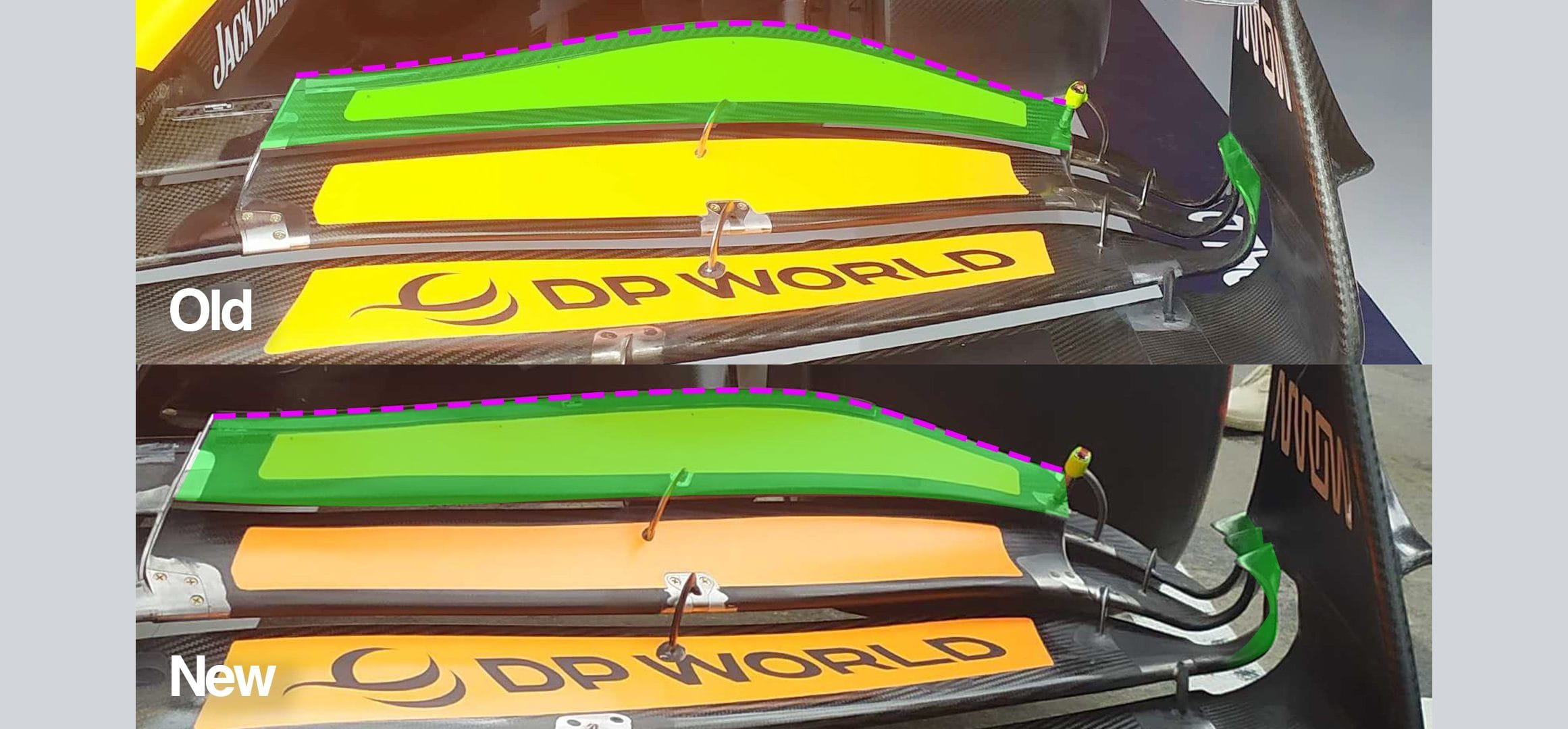
A comparison showing McLaren’s new front wing, brought to the 2024 Austrian Grand Prix
Paired up with the front wing change are reworked suspension shrouds, albeit that's very much secondary given the suspension is "more of a passive component" compared to something like the floor, according to team principal Andrea Stella.
"When you change the front wing it changes slightly the flow that goes to the back of the car, and so you need to optimise the components downstream for the slight variation on the flow topology..
"This is very normal. I think I see more and more that when teams bring front wing upgrades, they always upgrade then brake ducts and suspension shrouds. But that's purely aerodynamics."
Mercedes
Mercedes, whose driver George Russell emerged victorious in Austria, brought a reduced-camber beam wing to the Red Bull Ring.
"It's not really circuit-specific, in that there'll be other places that we run it," was Mercedes trackside chief Andrew Shovlin's description of the team's Austrian Grand Prix update.
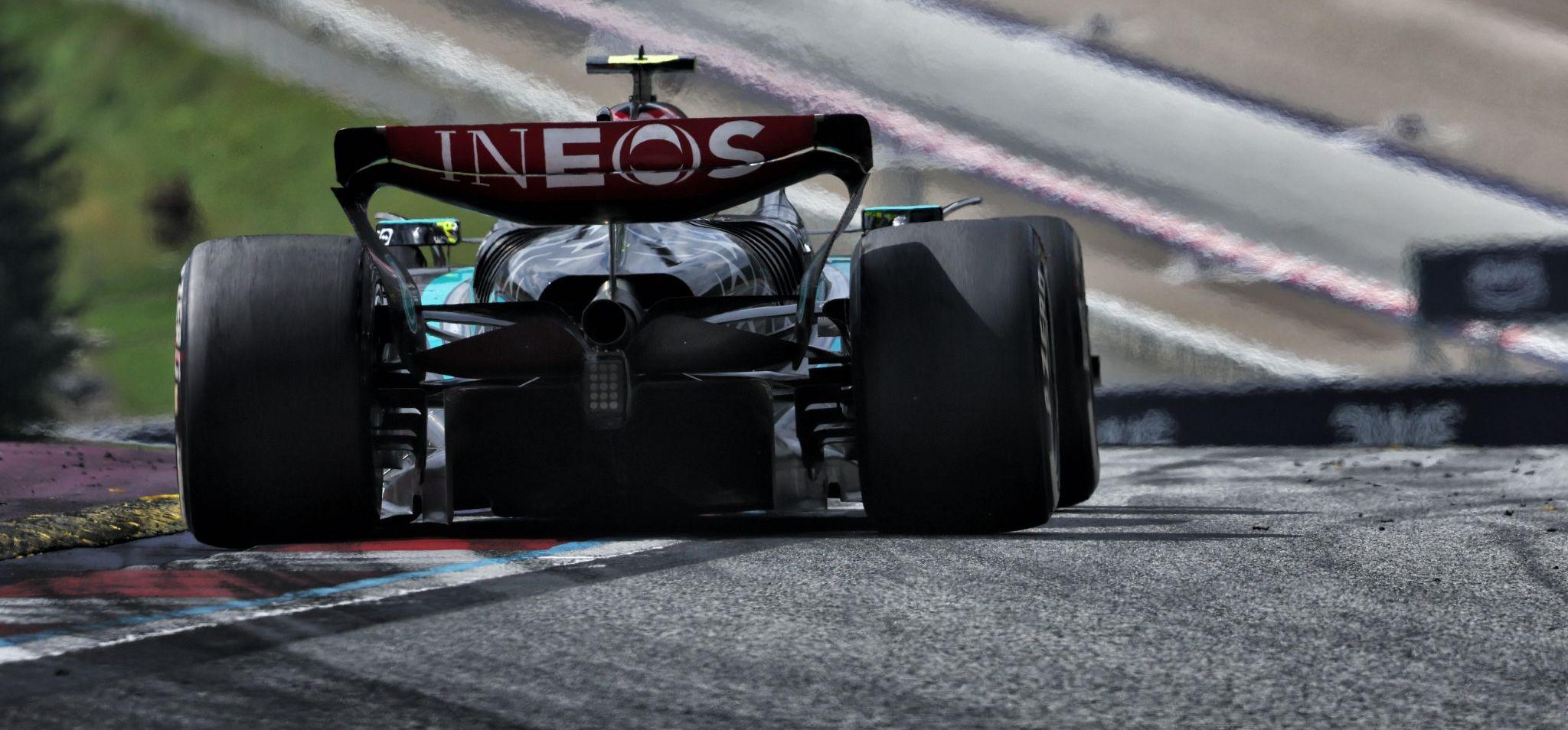
Rear view of the Mercedes W15 at the Red Bull Ring, where the team brought a revised beam wing
The team said it "reduces load both locally and on the floor", which ties in with the aforementioned onus on drag reduction at the Red Bull Ring.
"It just allows us to achieve a lower drag level with the same upper wing [rear wing]," Mercedes said in a press release.
Sauber
Another team to introduce a beam wing change, also in the pursuit of a drag reduction, was Sauber who brought in a single-element version for this weekend specifically – but admitted ahead of running that it might not use that part for the weekend.
Instead, Sauber settled on its previous configuration.
RB
The primary development focus for Red Bull's second team right now is getting the most out of its latest big upgrade, which the team CEO Peter Bayer admitted had arrived with a bit of a "belly flop" in Barcelona.
The package was more competitive at the Red Bull Ring, and part of that package specifically for Austria was a revision to the winglets on the rear brake drum to "help manage the flow at the back of the car".
Ferrari
The Scuderia made what it described as a circuit-specific change with an addition of an extra cooling louvres panel, "in anticipation of possible high ambient temperatures".
This change came "at an expense of aerodynamic efficiency", but its anticipation was correct, with the air temperature around 30 degrees Celsius for the race after a cooler start to the grand prix weekend.
Circuit de Barcelona-Catalunya was once the venue where every Formula 1 team would unleash their first major upgrade packages of the season. That’s no longer the case, but Red Bull, Ferrari, and RB did bring significant updates for the 2024 Spanish Grand Prix.

Max Verstappen leading George Russell in the 2024 Spanish Grand Prix
Formula 1 2024 upgrades: Red Bull, RB and Ferrari ring the changes in Spain
F1 teams’ vast knowledge of this track, based on the fact it has historically been a favoured testing venue, means it is a very valuable place for introducing updates and benchmarking progress. However, as the Spanish Grand Prix takes place later in the season than before, teams no longer wait until this race to implement their upgrade packages.
This track consists mostly of medium and high-speed long-duration corners – with a couple of slower-speed ones – and only one moderately lengthy straight. The removal of the final chicane from 2023 also eliminated the one section that required the cars to ride kerbs aggressively, so the current, faster, configuration naturally pushes teams towards bigger rear wings and lower ride height ranges than in Canada.
This track consists mostly of medium and high-speed long-duration corners – with a couple of slower-speed ones – and only one moderately lengthy straight. The removal of the final chicane from 2023 also eliminated the one section that required the cars to ride kerbs aggressively, so the current, faster, configuration naturally pushes teams towards bigger rear wings and lower ride height ranges than in Canada.
Here are the updates disclosed by teams to the media in Spain.
Red Bull
Red Bull and Ferrari have both been relatively quiet on the upgrade front since Imola, but both teams introduced significant changes for Spain. For Red Bull, this encompassed the radiator inlets, engine cover side panels and floor, as well as a revised rear wing.
The revised geometry of the radiator inlets was brought to induce a higher pressure of air being fed there, so as to minimise the area of aerodynamically-damaging outlet louvres. This brought with it a change to the engine cover side panels and even to the floor, so as to match the new bodywork.
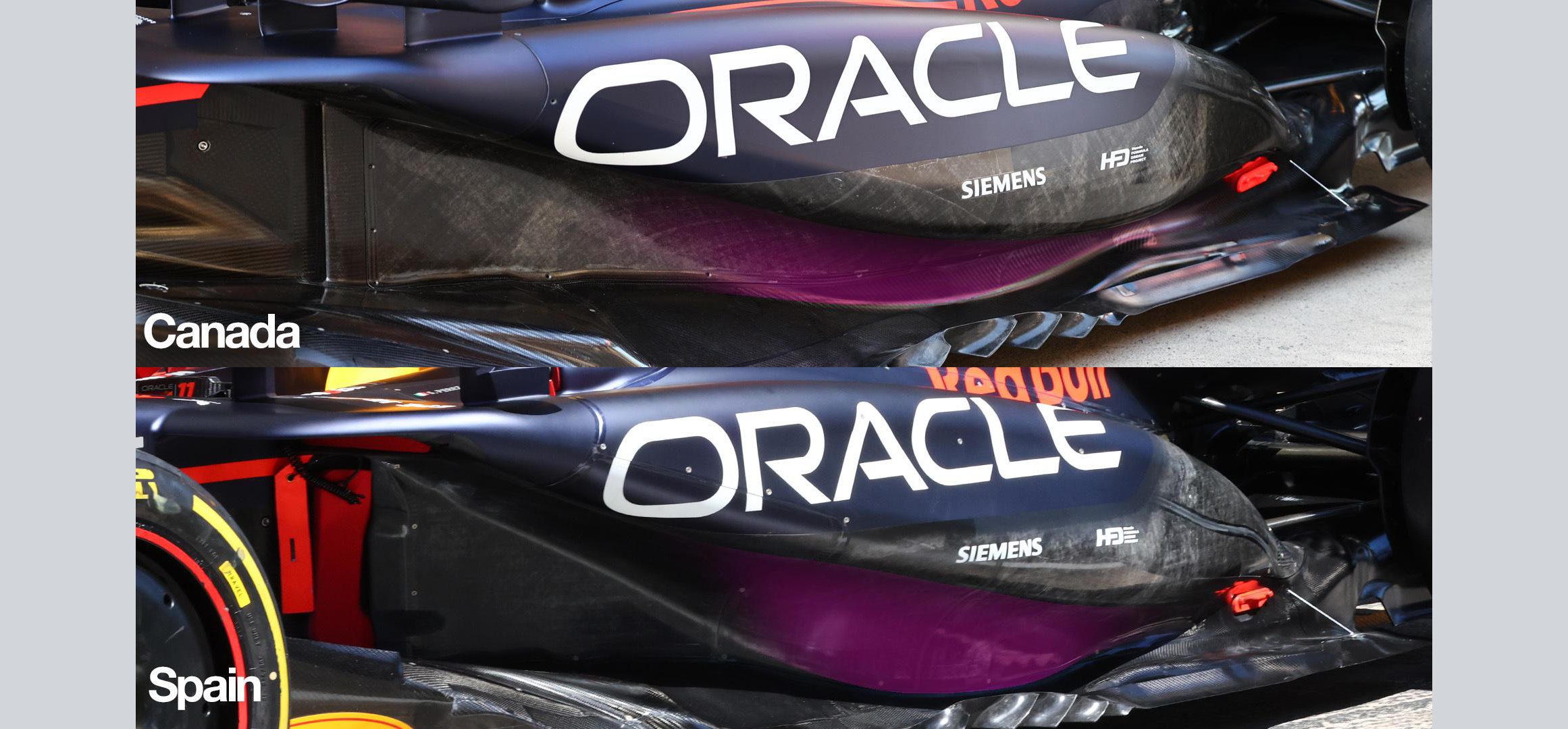
Red Bull revised its sidepod undercut for the Spanish Grand Prix
The span of the lower beam wing has been expanded to merge into a new endplate geometry, which should give more load from the beam wing itself. In order to incorporate this change, the lower part of the main wing’s endplates have been moved outboard.
Red Bull chief engineer Paul Monaghan indicated the cooling configuration changes were about improving the aerodynamic efficiency of the car for circuits like Circuit de Barcelona-Catalunya and Silverstone.
At these tracks, the car is aerodynamically sensitive to so-called ‘dirty air’ spilling off of louvres that will, by necessity, need to be opened to cool the car in the higher ambient temperatures of the European summer.
Ferrari
The most visible changes to the Ferrari were to the sidepod undercut – with the area underneath the front of the sidepod opened up. The sidepod undercut and the coke bottle cutaway at the rear have both been enhanced with the aim of increasing downforce at the rear of the car and the floor fences at the tunnel inlet have been suitably re-aligned to fully exploit this.
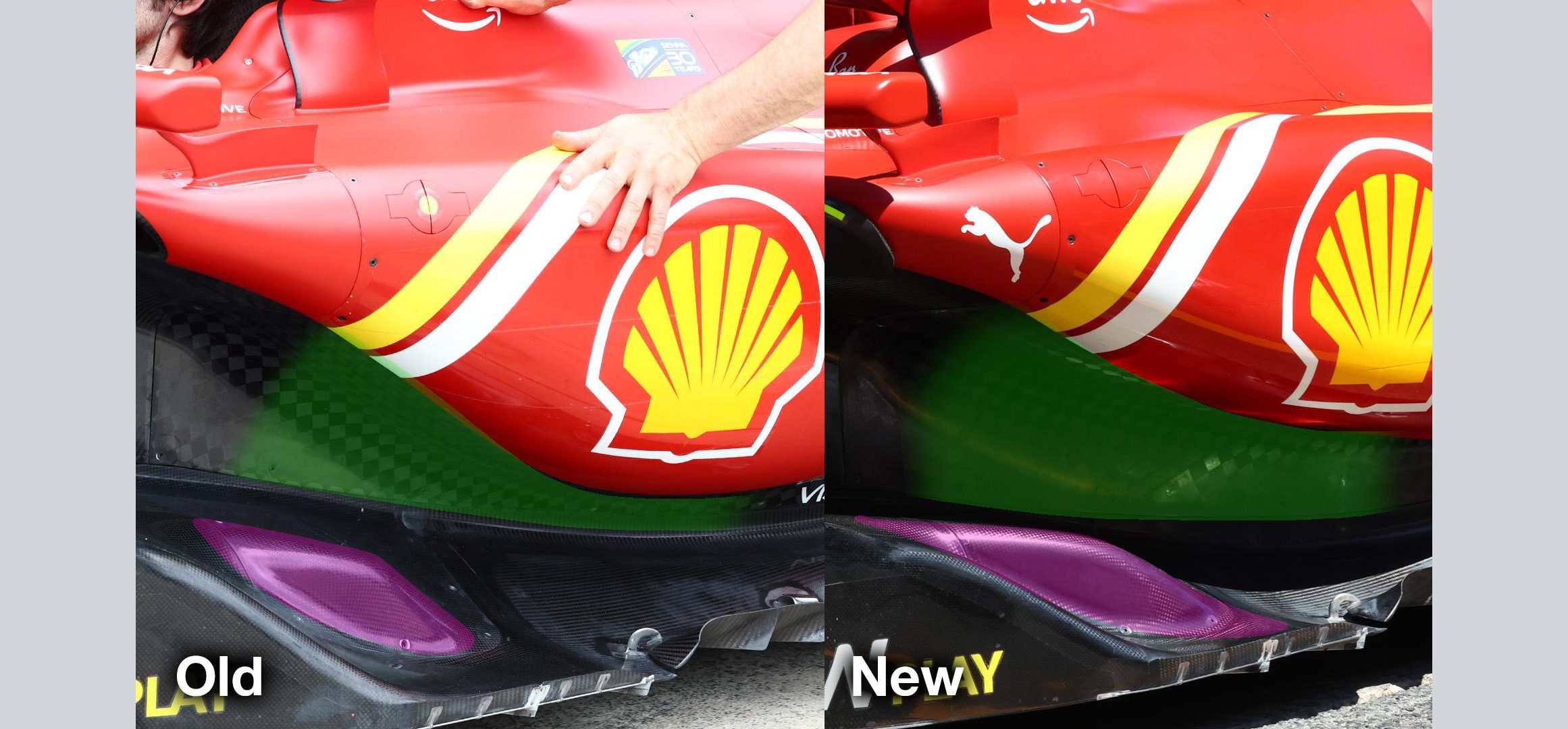
Ferrari made changes to the sidepod undercut and floor roof of the SF-24 in Spain
The roof of the floor itself has been lowered at the front to enhance the effect. The new floor also incorporates a newly shaped central ‘canoe’ section between the tunnels, revised floor edges and a new diffuser geometry.
Ferrari has introduced a new high downforce rear wing and beam wing offering what it claims is a wider range of effectiveness in the transient state, when the car is in yaw.
Senior performance engineer Jock Clear described this latest update as resulting from a parallel program of development instigated for the car at Imola, which was “somewhat fast-tracked” to Barcelona because of its “fantastic” suitability for car upgrade evaluation.
“It’s super close,” added Clear, of the development battle Ferrari and F1’s other top teams are embroiled in. “And if you can come one race earlier [with an upgrade] the gain’s doubled, effectively.”
RB
RB too brought a significant upgrade to Spain, focused on the engine cover, sidepod and radiator inlet shape – as well as a new floor and rear wing.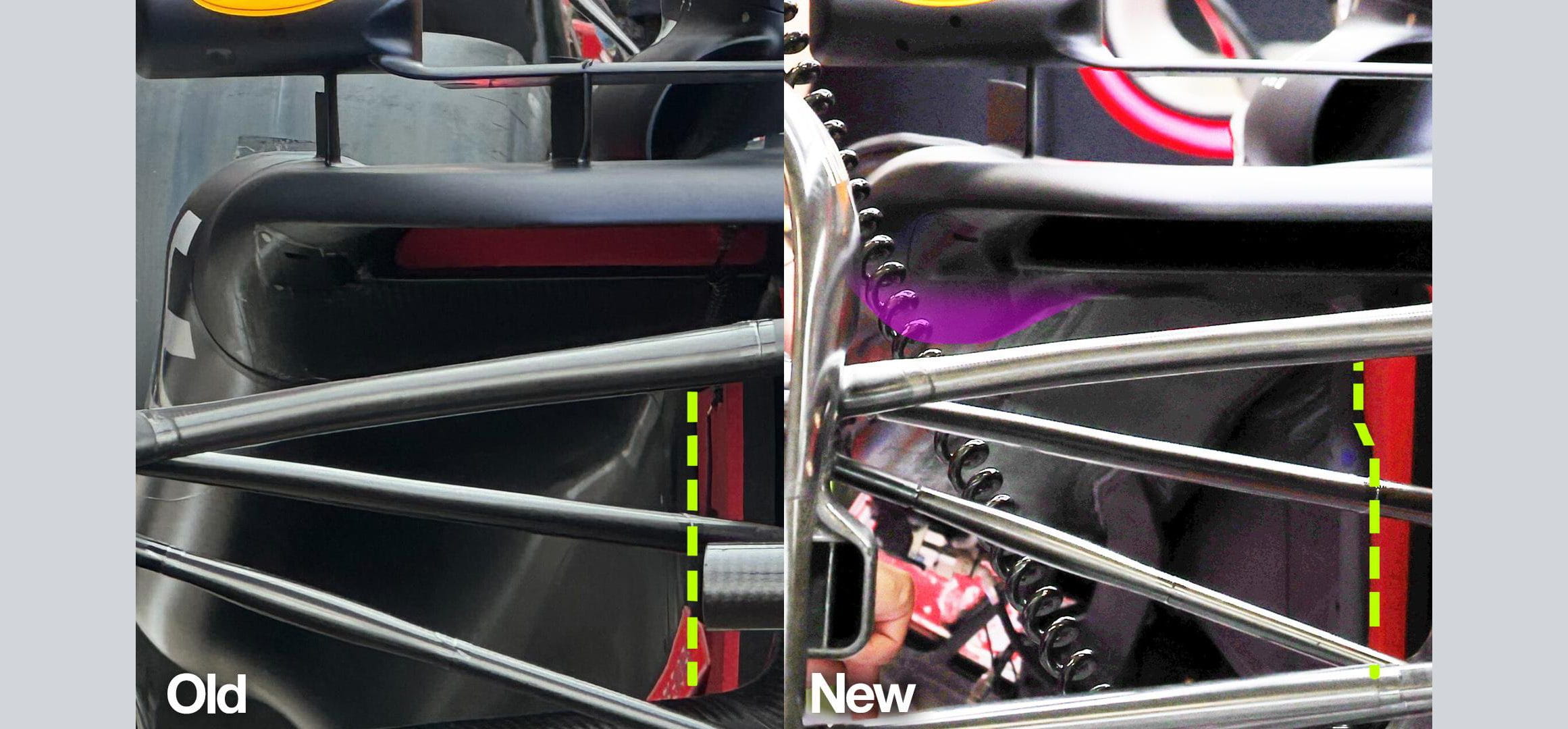
A comparison showing changes to the upper sidepod profile and vertical letterbox of the RB VCARB 01 in Spain
The new engine cover/upper sidepod profile is designed to improve flow to the rear wing and this has involved reshaping the radiator inlet leading edge. This has been done in line with changes to the height of the forward part of the floor and to the alignment and geometry of the tunnel inlet fences – and a new rear wing to maximise efficiency at the sort of downforce levels used for Barcelona and similar tracks.
RB sporting director Alan Permane said this latest update was “in line” with previous efforts to improve the car’s performance at high-speed, given it’s been a relatively stronger performer through low-speed corner profiles so far.
Sauber
Sauber introduced a new rear wing which more fully integrates with the switch to a single pylon mounting made two races ago – plus updated front brake ducts for a better aero/cooling trade-off.
Aston Martin
Aston Martin modified its front suspension fairings to give a better airflow interaction with the flow exiting the redesigned brake duct.
There are also slight changes to the aero devices on the rear brake ducts to increase local load.
Haas
Haas attached a new winglet atop the rear structure of its car.
Alpine, McLaren, Mercedes and Williams did not declare updates for this race.
Canadian Grand Prix venue Circuit Gilles Villeneuve is a high-speed street track with a mix of low- and medium-speed corners. And to tackle this circuit, Mercedes brought the most significant upgrade package of all teams to the track.
A comparison between Mercedes’s old front wing and its new front wing in Canada
2024 Formula 1 upgrades: Mercedes makes major change for Canadian Grand Prix
Mercedes
The team brought its old specification of wing to the track for Friday practice, which was affected by rain, but ran the new specification of wing from third practice onwards.
Its original 2024 wing design was unusual given its highest element comprised a small element of carbon fibre rather than a full plane.
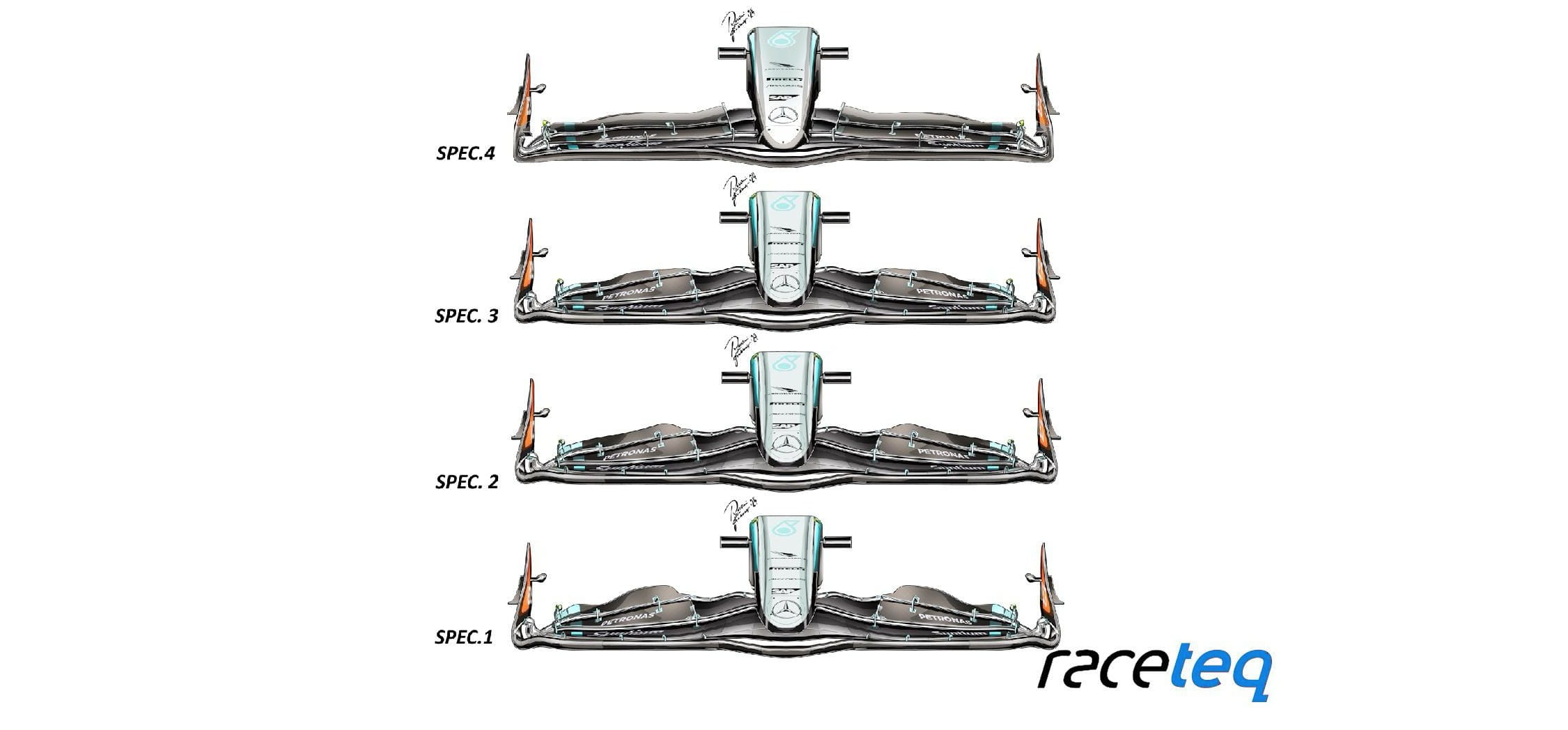
The four iterations of Mercedes’s front wing design in 2024 so far

Car
Mercedes W15: Why the F1 team has struggled with innovative car – and how it differs from W13 and W14
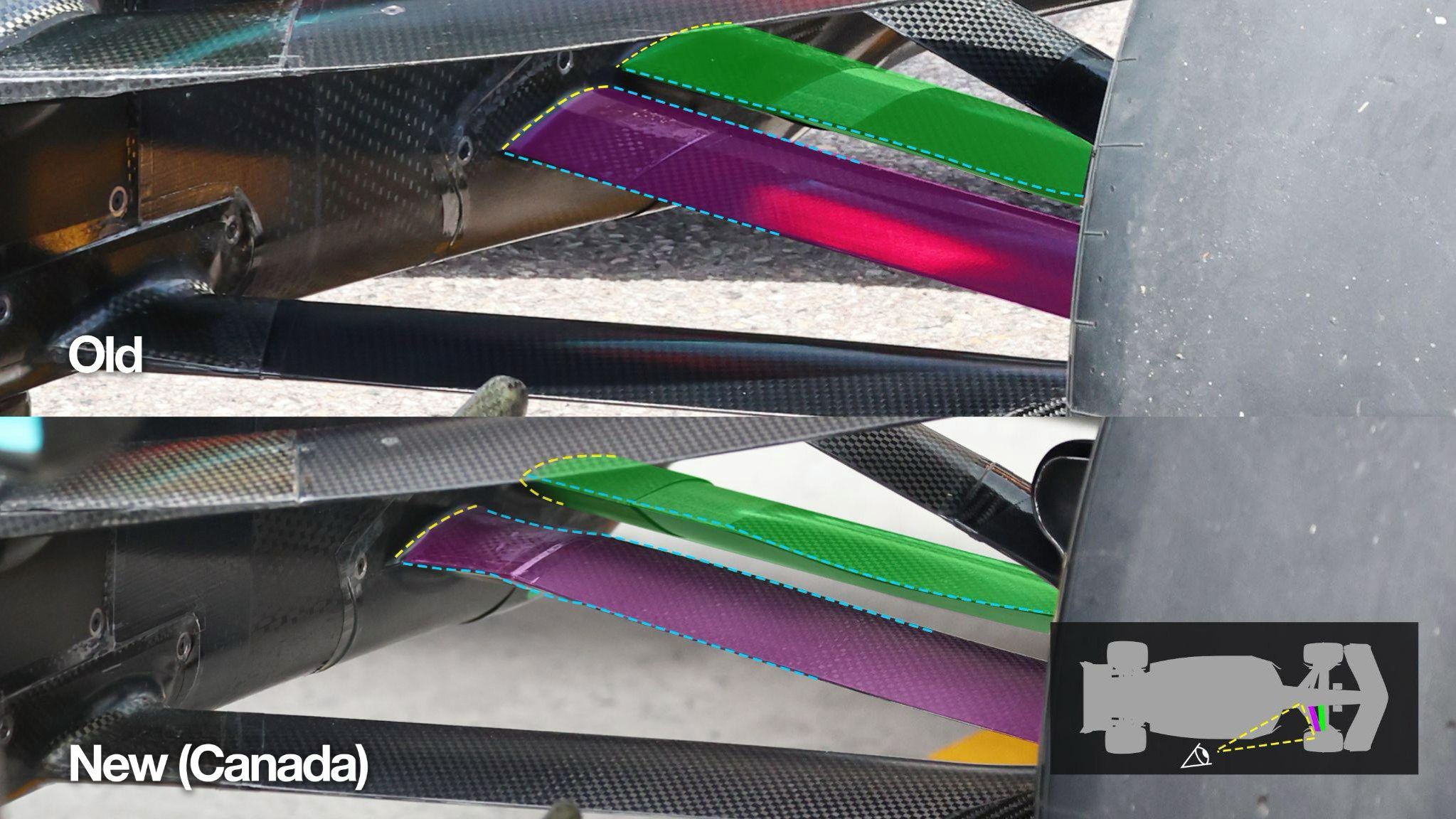
Mercedes realigned its front suspension to account for the new front wing design in Canada
Aston Martin
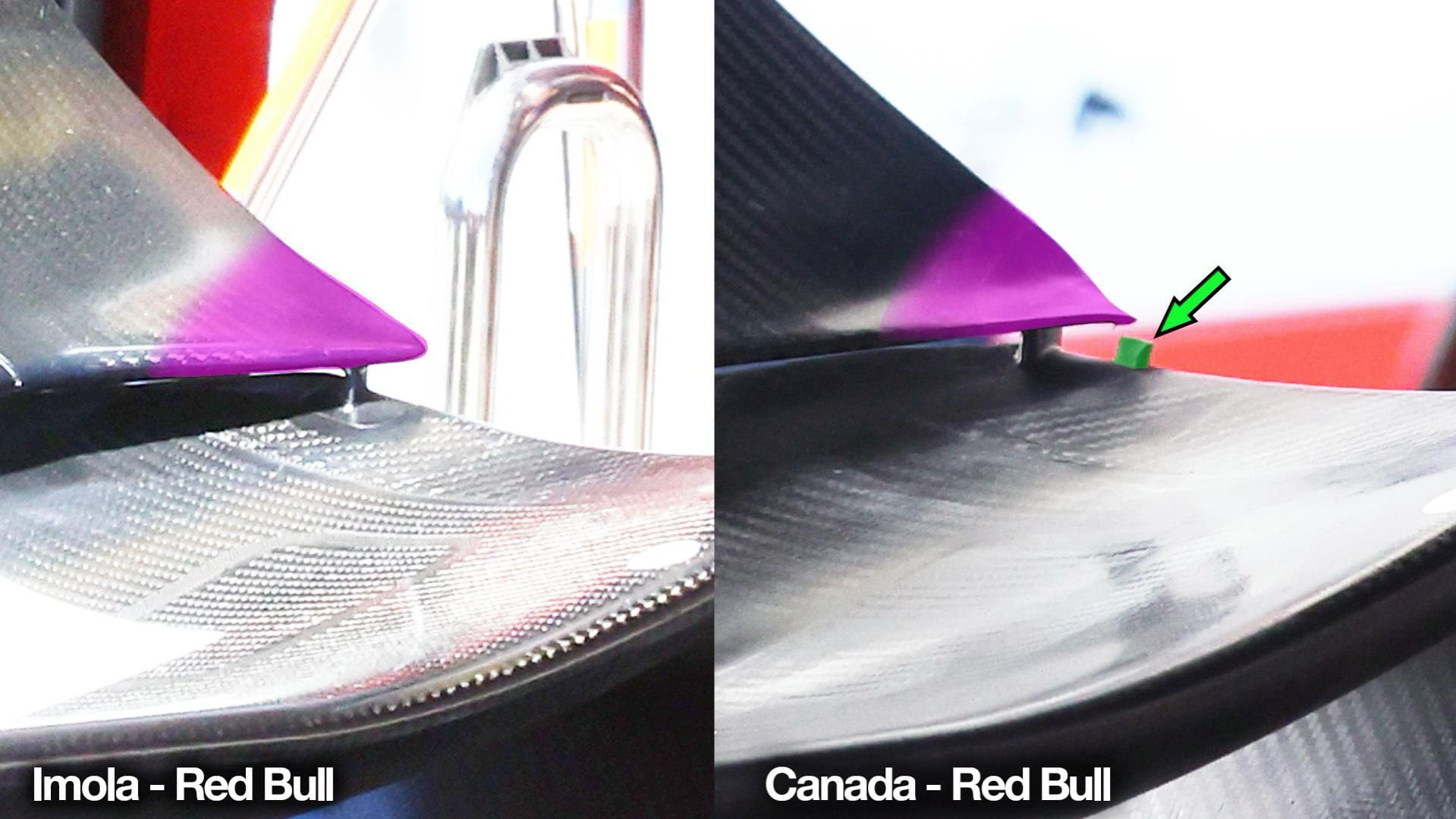
A close-up showing the small tweaks to Red Bull’s rear wing for the 2024 Canadian Grand Prix
Red Bull
Williams
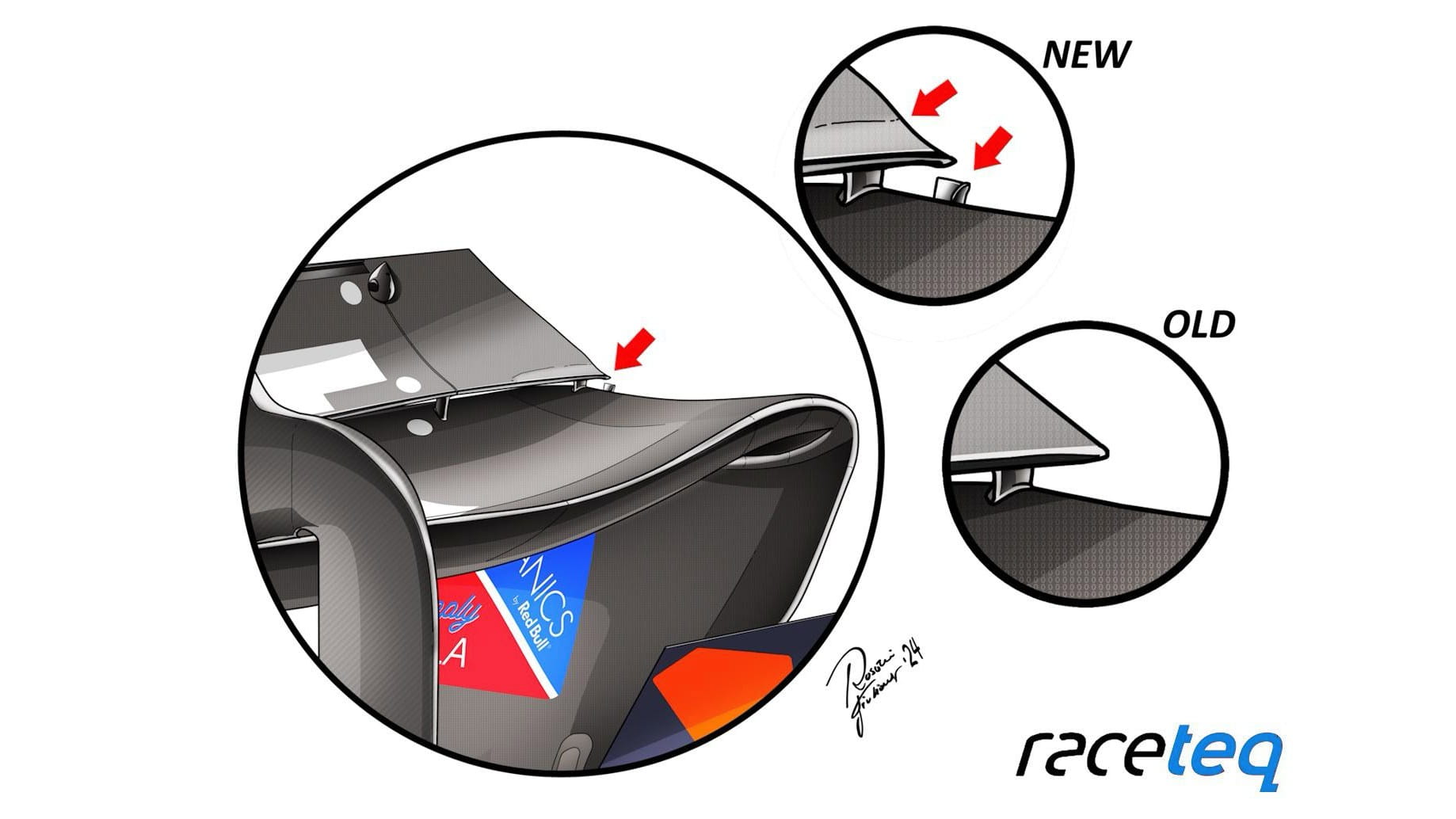
Subtle tweaks to the rear wing of the RB in Canada
RB
RB brought a new iteration of its low-drag rear wing and a front wing to work with that new design.
Sauber
Sauber brought a low-drag version of the single-pillar rear wing that it introduced for the previous race in Monaco. It also brought a new low-drag beamwing to match.
Haas
Haas introduced a front wing specification to balance the car around the use of its low-drag rear wing – another circuit-specific update for the Canadian Grand Prix.
Ferrari, McLaren and Alpine did not declare any updates for this race.
All 10 Formula 1 teams brought upgrades to the Monaco Grand Prix, fulfilling the need to adapt their cars to the particular challenges posed by the most iconic circuit on the calendar.
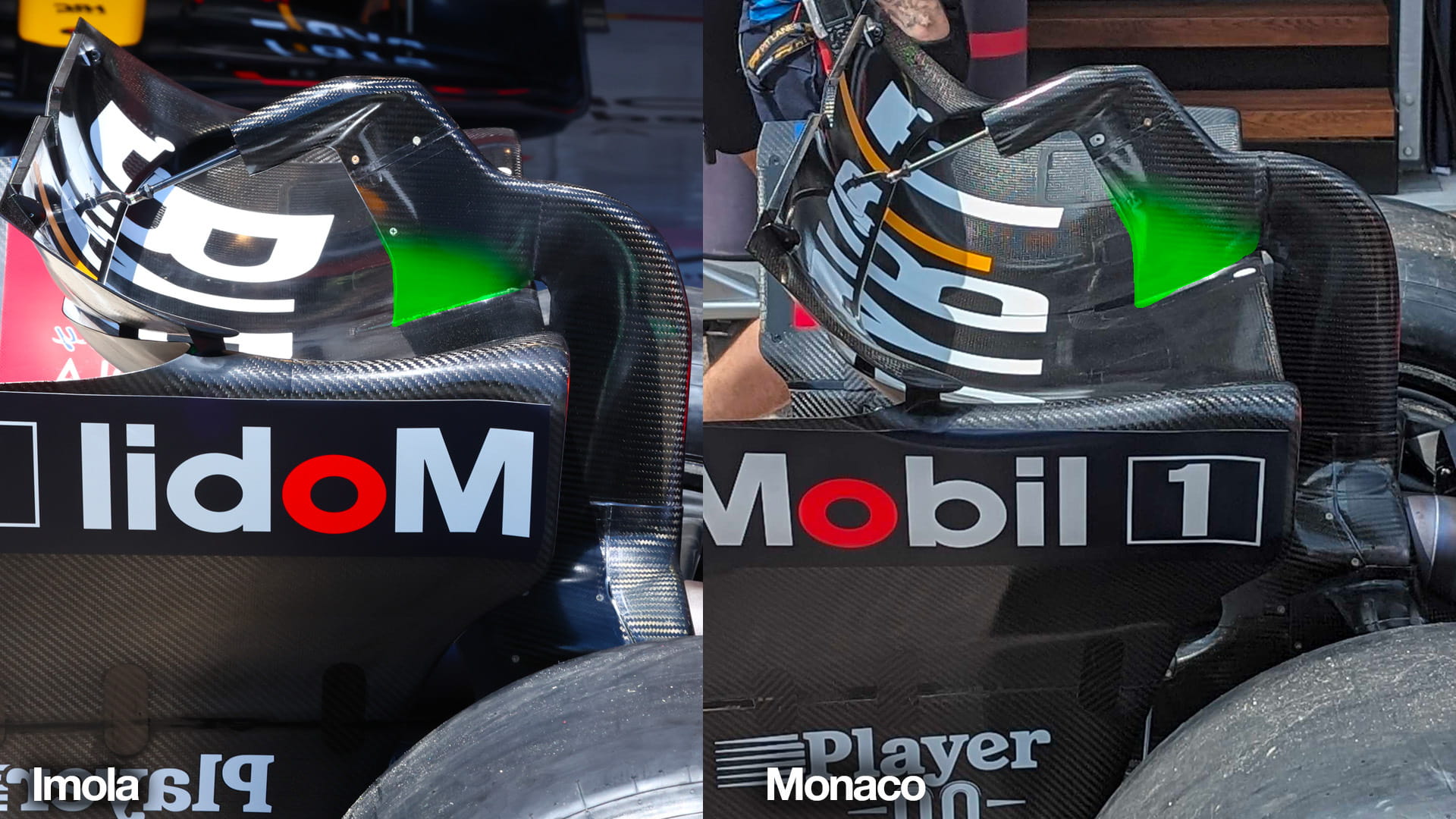
A side-on comparison, showing the Imola-spec, Emilia Romagna Grand Prix Red Bull rear wing (left), and the Monaco-spec Red Bull rear wing (right).
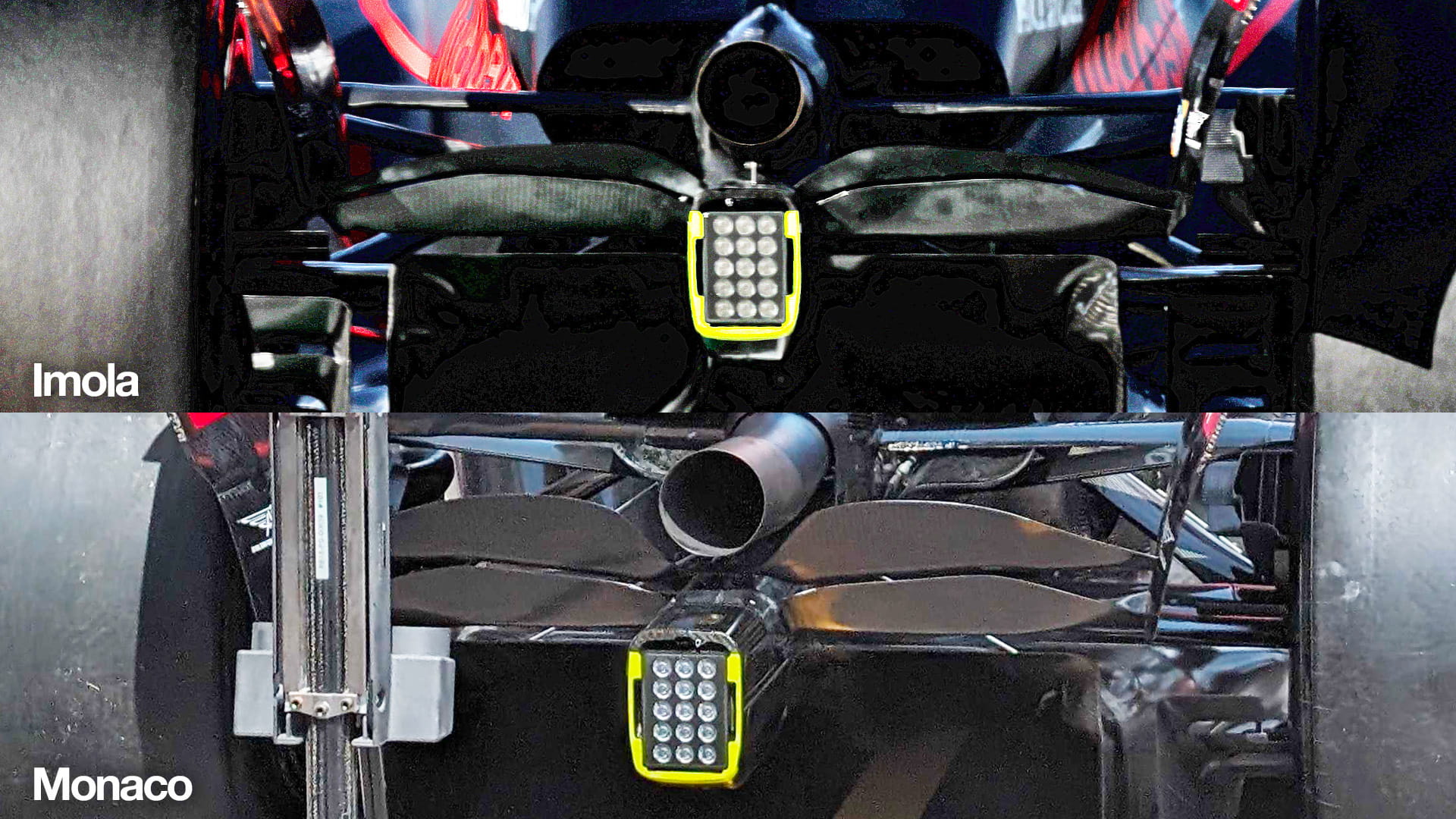
A rear comparison of the enlarged beam wing on the Monaco-spec Red Bull (bottom), compared to the Imola-spec Red Bull beam wing (top).
How all 10 teams adapted to the Monaco Grand Prix
There were circuit-specific rear wings and beam wings aplenty as the teams showcased their upgrades on Friday at Monaco. But so too were there some important performance updates that the teams will carry beyond the weekend.
Here’s what the 10 F1 teams disclosed to the media about their updates at the eighth round of the 2024 season.
Red Bull
The reigning world champion team brought four circuit-specific upgrades to its RB20 in Monaco.The first of those is a steeper and deeper high-downforce rear wing. It has fulfilled the maximum permitted volume of camber and chord length, to extract the optimum performance around the high-downforce track.
Accompanying the new Monaco-spec Red Bull rear wing is a high-downforce beam wing enlarged by chord and camber.
There’s also an enlarged inlet and exit brake duct to optimise cooling around a track that’s very tough on brakes.
To help mobility through Monaco's tight corners, Red Bull also added a small notch in the upper front wishbone fairing for more steering lock.
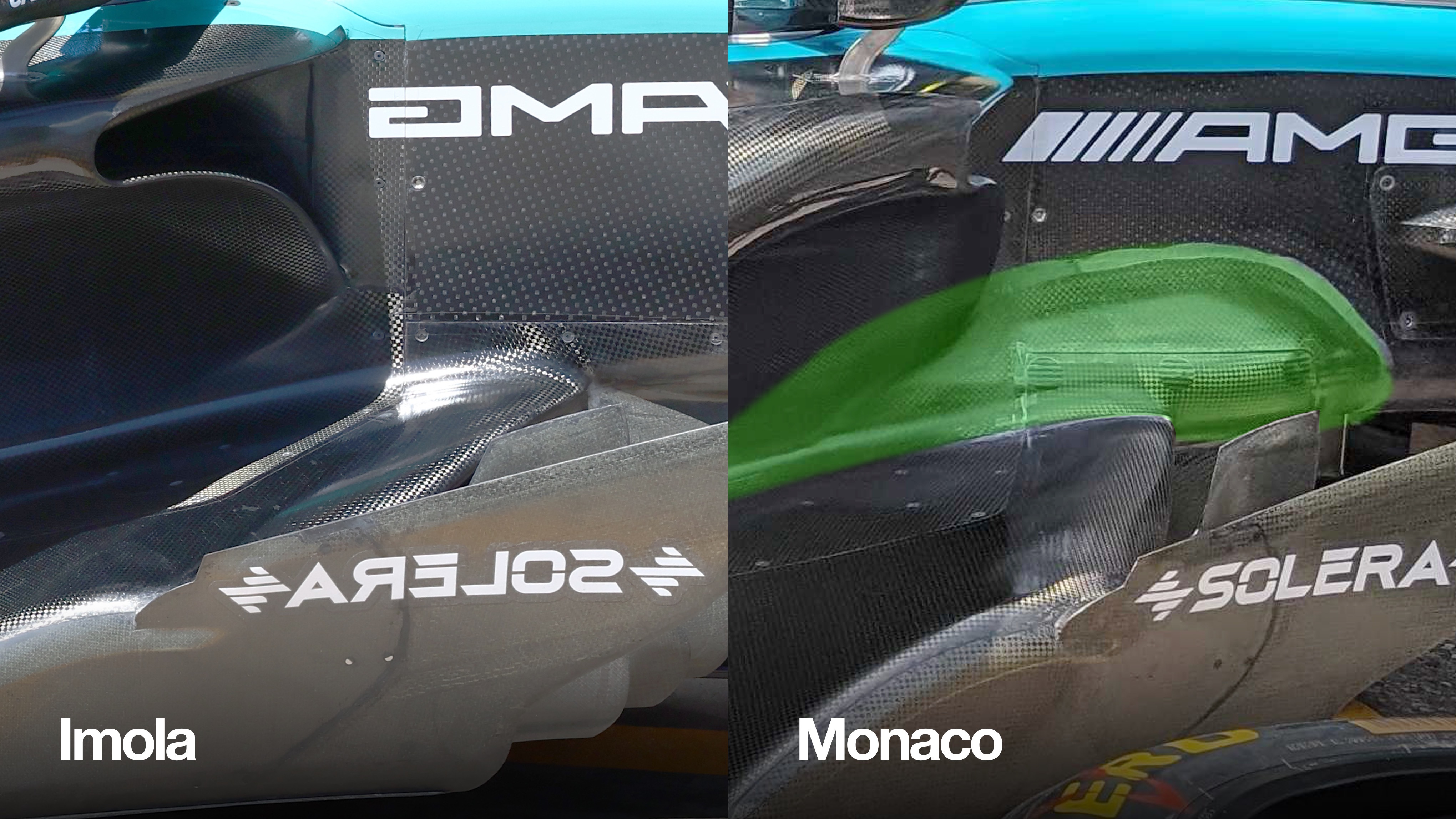
Side-on comparison of Mercedes’ Imola-spec inboard leading floor edge (left) and Monaco-spec inboard leading floor edge (right)
Mercedes
Like Red Bull and Ferrari, Mercedes increased the camber of both its rear wing and beam wing to cope with Monaco’s slow corners.
Mercedes also increased the inboard floor leading edge to increase the acceleration in this area, which in turn generates more load.
There was also a further change to the Mercedes front wing, used by George Russell, with a larger chord inboard flap and redistribution of the main plane chord.
McLaren
McLaren joined its frontrunning rivals in bringing a circuit-specific rear wing and beam wing, two races on from its transformative Miami GP upgrade that helped deliver Lando Norris his first F1 win.
Ferrari
Ferrari also brought a circuit-specific rear wing and beam wing to Monaco to meet the track’s aerodynamic requirements.
continues below
.jpg?cx=0.5&cy=0.5)
A comparison between the Imola-spec Ferrari rear wing (top-right) and Monaco-spec Ferrari rear wing (bottom left).
Aston Martin added a Monaco-spec rear wing and beam wing which it described as having “more aggressive geometry”.
Alpine
Alongside a circuit-specific rear wing and beam wing with “the sole aim of tackling the high-downforce nature of Monaco”, Alpine introduced a front wing with a bigger range of flap profiles, to help compensate for the larger rear wing.
Alpine also joined a 2024 trend of adjusting its fairings on the halo. That helps produce more outwashing flow out of the cockpit, improving the flow to the rear wing and beam wing.
Williams
The beam wing and rear wing on the Williams have increased chord lengths and a higher angle of attack in Monaco.
There are also circuit-specific cooling changes for the brake temperature demands of Monaco, with larger front brake duct scoop exits.
RB
Red Bull’s sister team RB switched to a two-element beam wing and enlarged rear wing with increased camber, as well as enlarged front brake cooling ducts. These are all Monaco-specific changes.
There was one performance update listed that wasn’t specific to Monaco. The profiles of the suspension members were modified and adjusted.
Those updates “improve the flow attachment on the suspension legs” and reduce the unwanted airflow separation in this area.
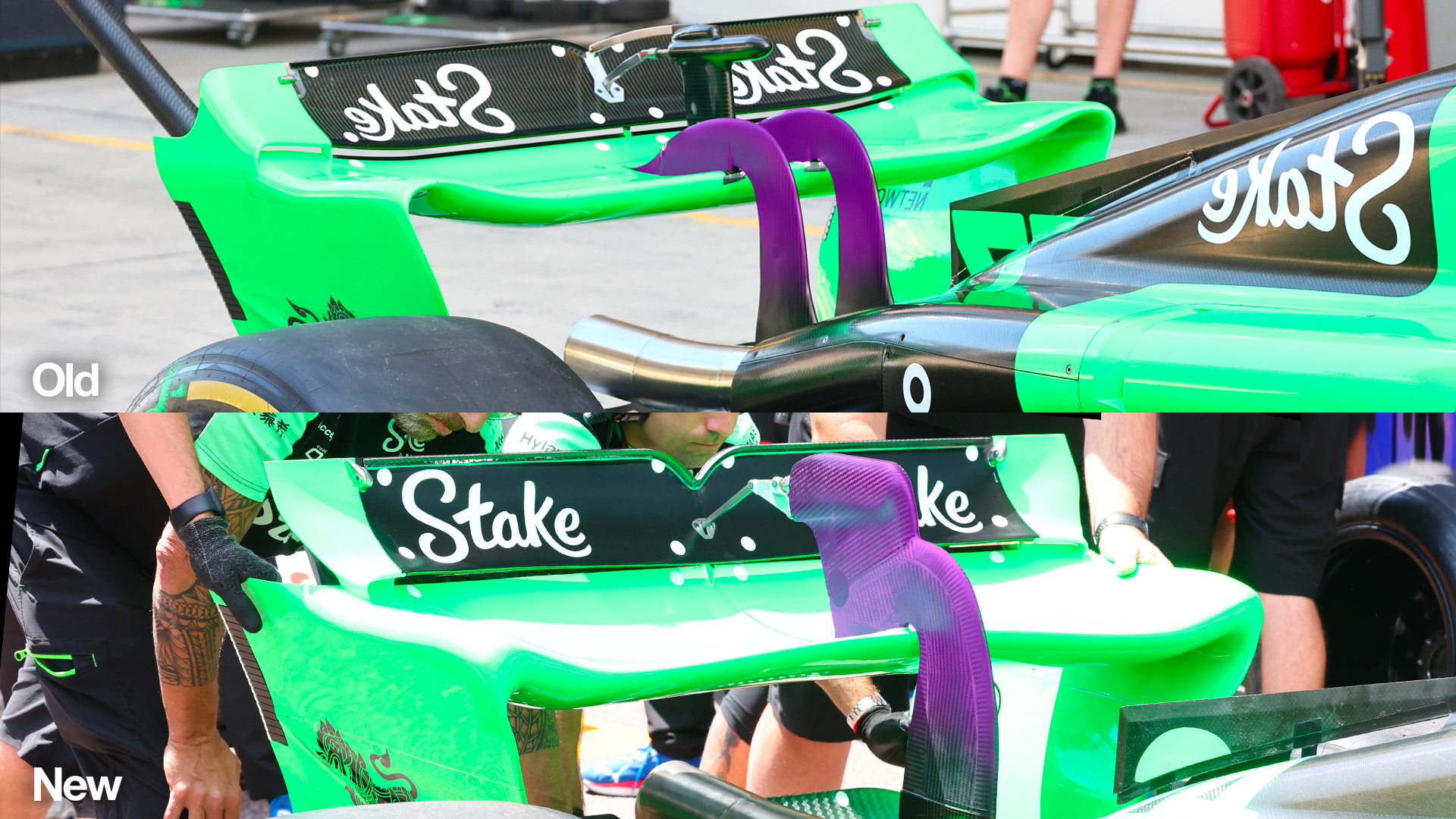
A comparison of Sauber’s double-pylon rear wing in Imola (above) and Sauber’s single-pylon rear wing in Monaco (below).
Sauber
Sauber switched from a double-pylon rear wing to a single-pylon rear wing.The team said this was done to improve aero efficiency for Monaco but it will also “form the basis of future developments” for the rear wing later in the season.
“You will see it also at the following tracks changing to that configuration,” added Sauber’s trackside engineering director Xevi Pujolar in Monaco.
“It will help us to close it up with the competitors in terms of the efficiency we can expect from that configuration.”
In addition to the rear wing change, there was a new beam wing on the Sauber, a redesigned front brake duct to help with cooling, and redesigned front suspension covers that are specific to Monaco.
The fifth listed change was a circuit-specific rear wing endplate change with detached tips that the team said maximises aerodynamic efficiency.
Haas
Haas declared five updates for Monaco.
Those included a beam wing and rear wing with more camber, within the allowed dimensions. There was also a new design of the cooling louvre layout to improve cooling and the brake duct exit scoop conditioner was removed for the same reason.
Like Red Bull, Haas made a trackrod shroud modification to get the steering lock required for Monaco.
continues below
Ferrari’s first significant upgrade package of the 2024 Formula 1 season turned heads before the 2024 Emilia Romagna Grand Prix at Imola.
/rtq-6024-comaparison-ferrari-sf24-side-vide-imola-1-1/rtq-6024-comaparison-ferrari-sf24-side-vide-imola-1-2.jpg?cx=0.5&cy=0.5)
A side-on comparison showing the Imola-spec SF-24 (below) and the Bahrain-spec SF-24 (above)
Nine teams including Ferrari bring upgrades to Imola
Ahead of its first home race of 2024, Ferrari tested part of its Imola upgrade package at its local circuit Fiorano, where photographs showed a sneak peak of the SF-24’s updates including revamped sidepods.Eight other teams, including McLaren, Haas, and Aston Martin, also brought upgraded cars to Imola. Here’s what teams disclosed to the media ahead of free practice at the 2024 Emilia Romagna Grand Prix.
Ferrari
All eyes were on Ferrari’s upgraded SF-24 in the build-up to the race at Imola – particularly the markedly different sidepod inlets of the car. Now in the shape of a ‘P’, with a top lip skewed forward, Ferrari’s new inlet design has been pursued in conjunction with a new floor and bodywork design.continues after image gallery
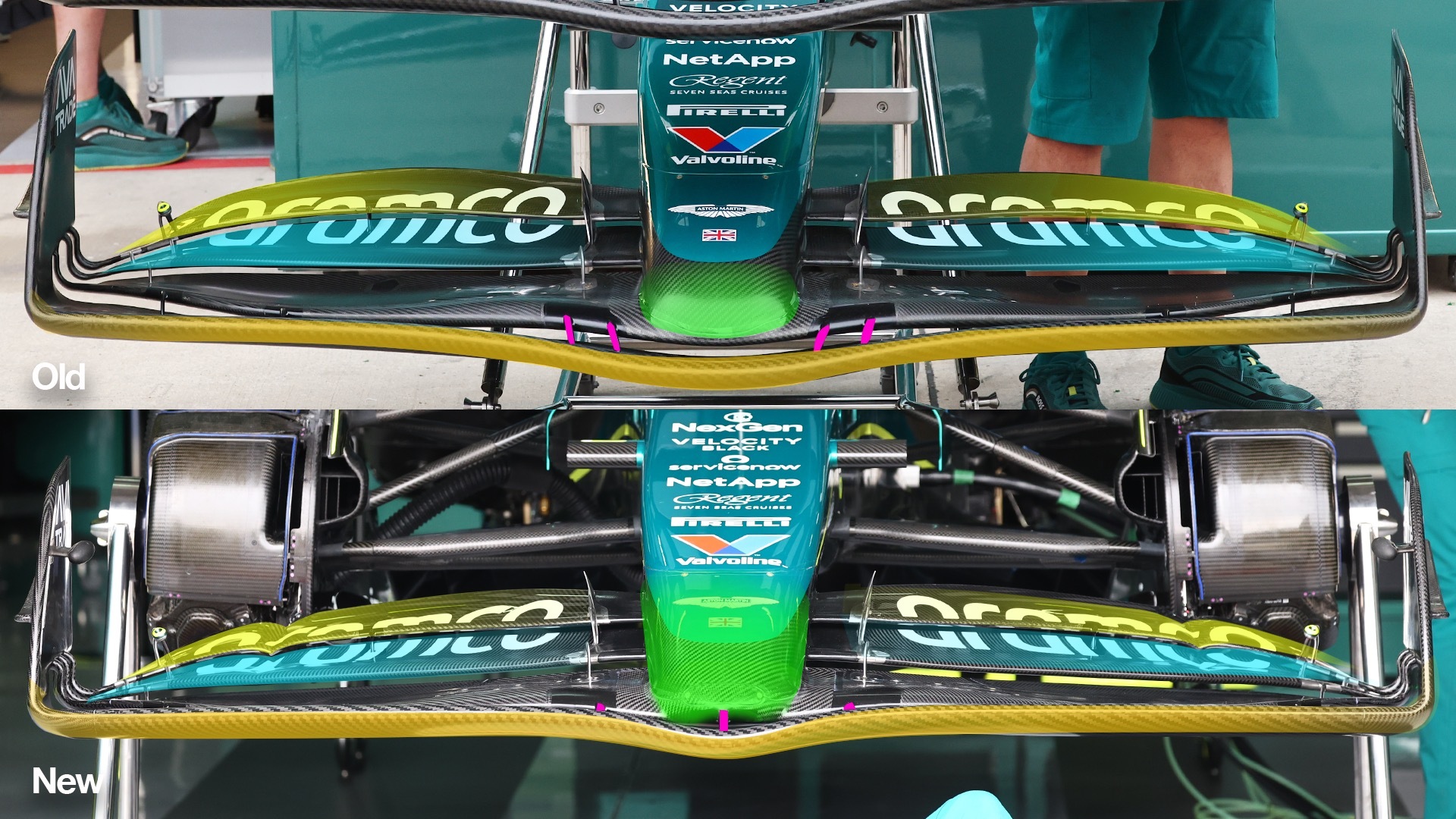
A highlighted diagram showing the changes at the front of the Aston Martin AMR24 at Imola (below) compared to its previous-spec, which was run by Lance Stroll during FP1 in Italy.
Aston Martin
Aston Martin brought major upgrades to Imola, revamping its AMR24 from front to back. A new central section of the front wing and a new first element has been brought to improve general performance. The nose has been changed to suit those changes.
The floor body has been reshaped to improve underfloor airflow and increase local flow, as have the floor fences and floor edge.
The top edge of the diffuser has been modified to improve load, while the rear suspension and rear corner have been reshaped to work with those changes.
Finally, the coke-bottle section, where the engine cover narrows towards the rear of the car, has been revised to improve local load and cooling specific to the demands of Imola.
Red Bull
continues below
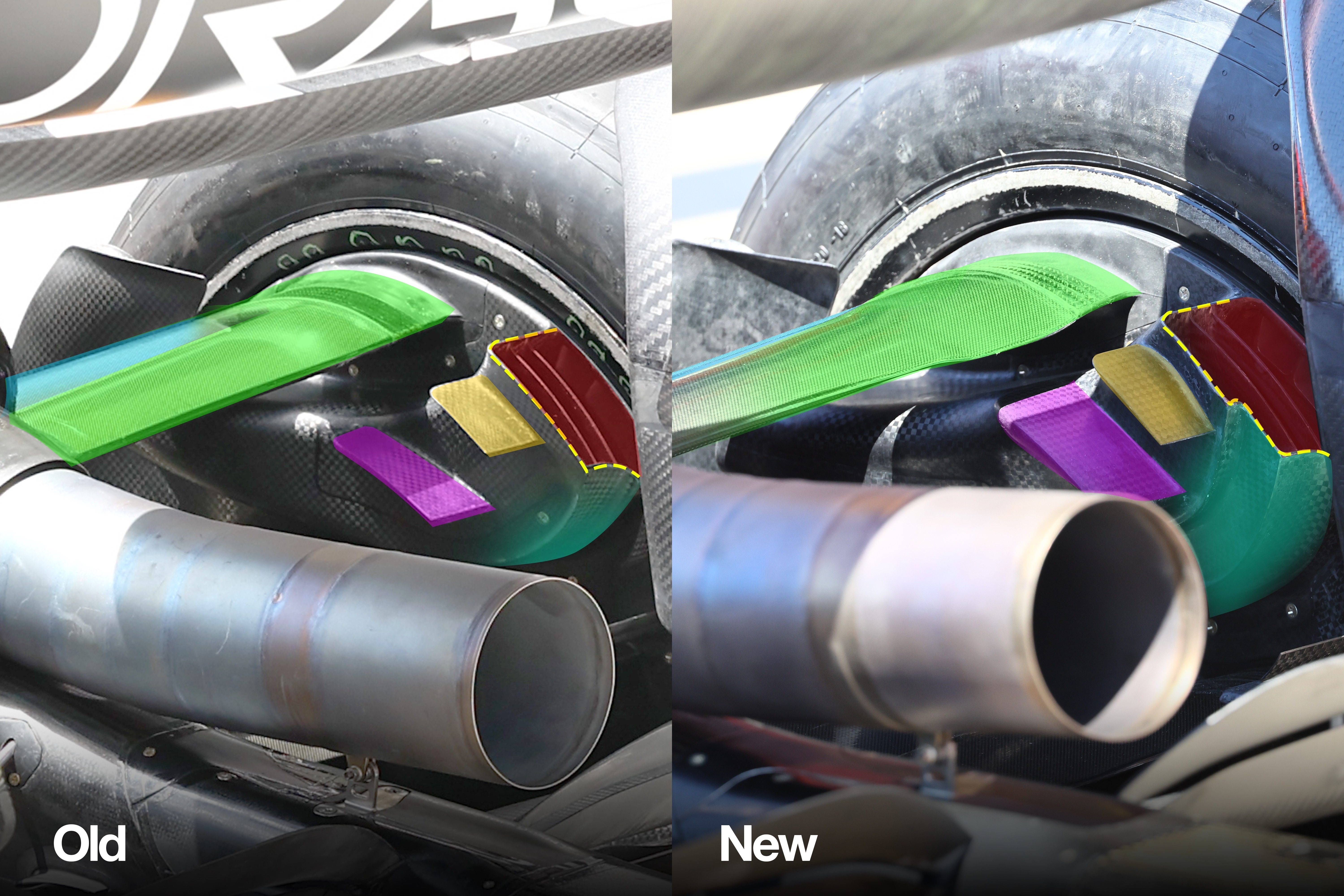
A comparison showing the reprofiled rear brake ducts of the Red Bull RB20 (right) at Imola
Mercedes
Haas
McLaren
Williams
Sauber
Alpine
In every round of the Formula 1 season, teams declare the upgrades they’ve brought to the track. And for the 2024 Miami Grand Prix, McLaren and Mercedes brought significant upgrade packages.
McLaren and Mercedes bring major changes to Miami
McLaren
McLaren brought a significant upgrade package to Miami including a completely revised floor design, reshaped brake ducts and reshaped bodywork throughout the car. The team brought two different specifications of cars to the track with Norris running all of the new upgrades and Oscar Piastri about 50% of them.
The bodywork and engine cover of the MCL38 were reshaped to work in conjunction with new sidepod inlets and the revised floor design.
Mercedes
Mercedes’s upgrades for the 2024 Miami Grand Prix centred around the floor of its W15. The floor edge was tweaked with more vanes added on the outer edge to improve airflow to the diffuser at the rear of the car.Red Bull
Aston Martin
Williams
RB
Sauber
Sauber’s updates for Miami were track-specific; it trimmed the front wing and brought a lower-downforce rear wing.
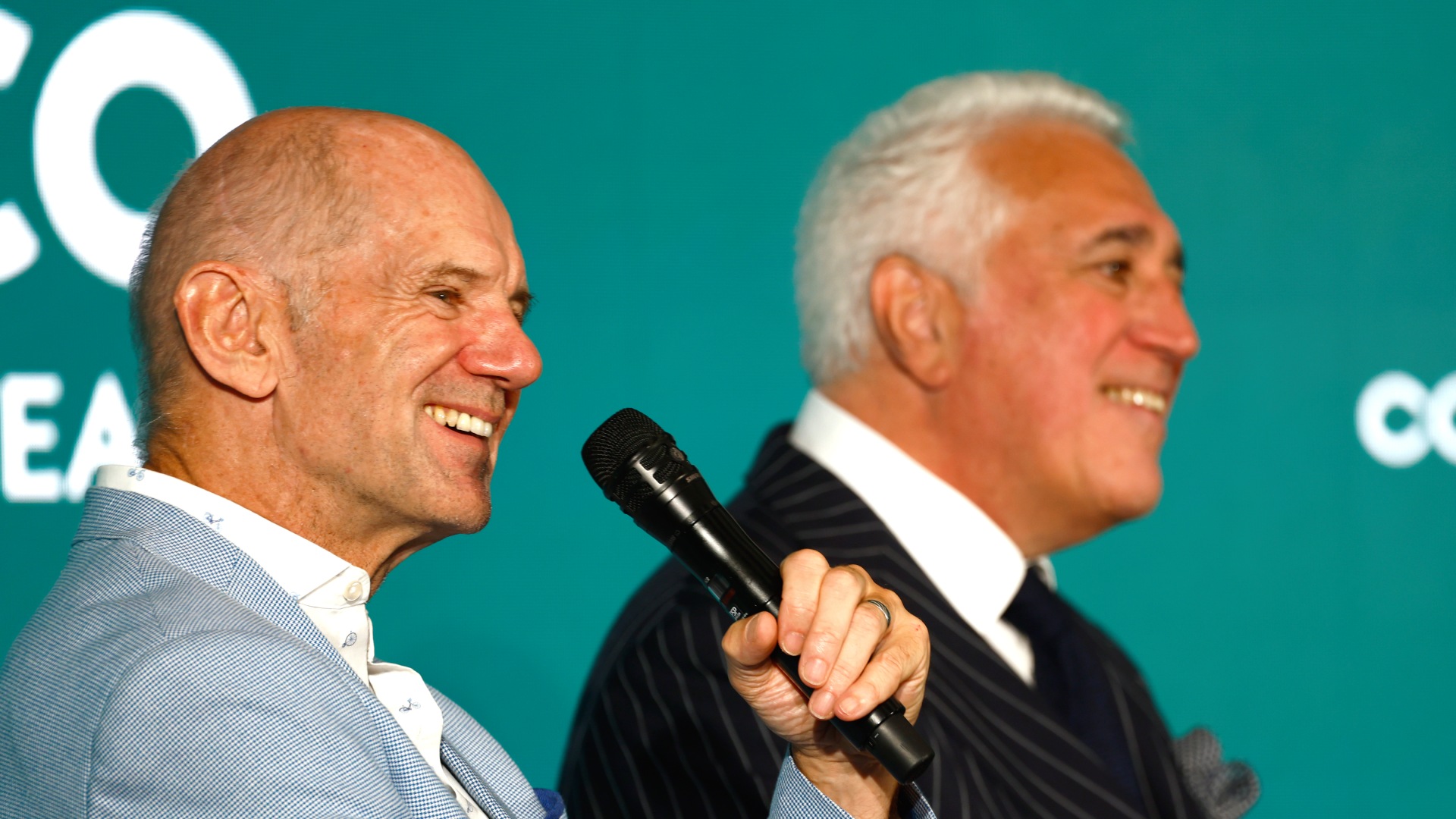
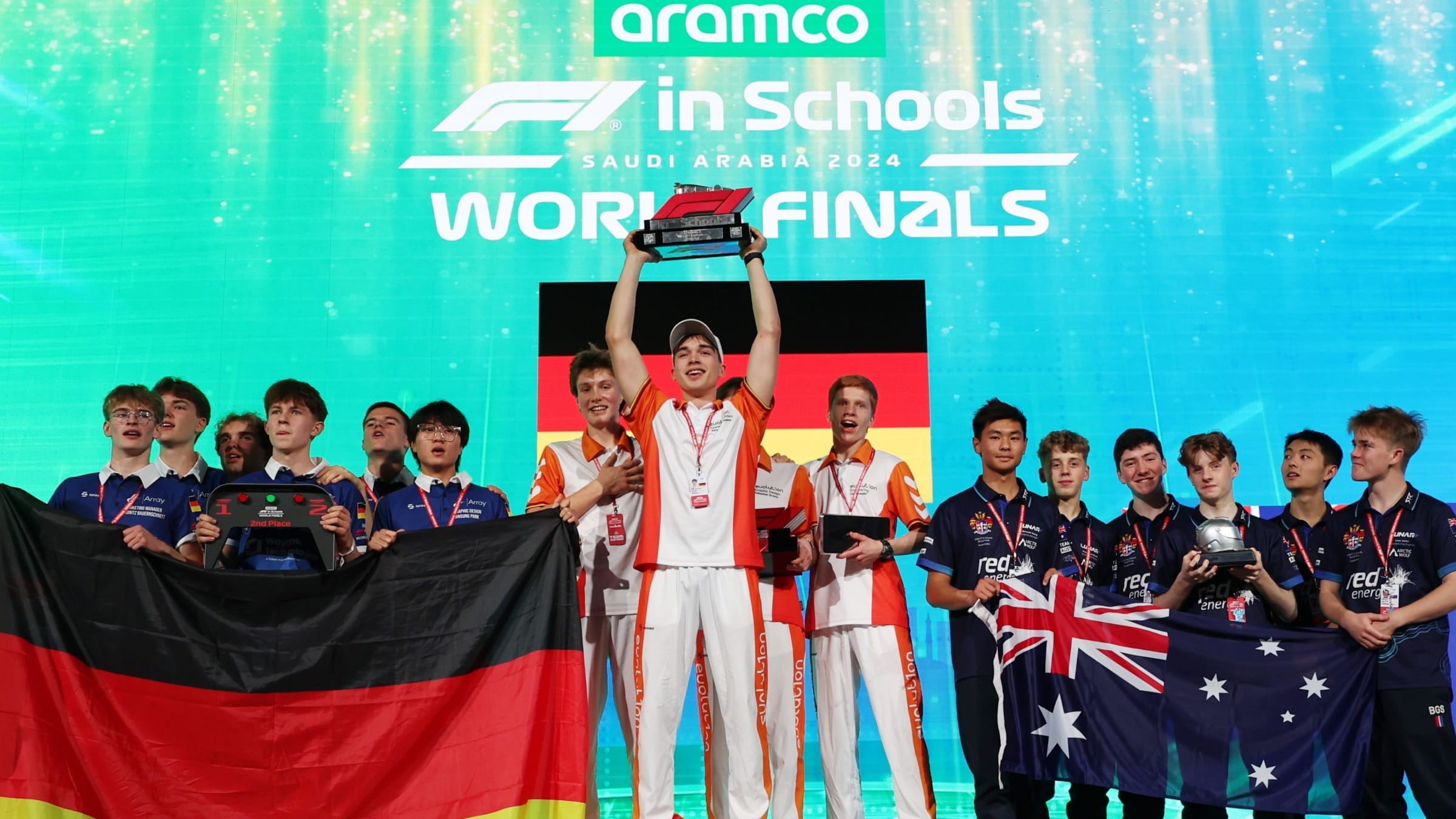
.jpg?cx=0.5&cy=0.5)
.png?cx=0.5&cy=0.5)
.jpg?cx=0.62&cy=0.39)
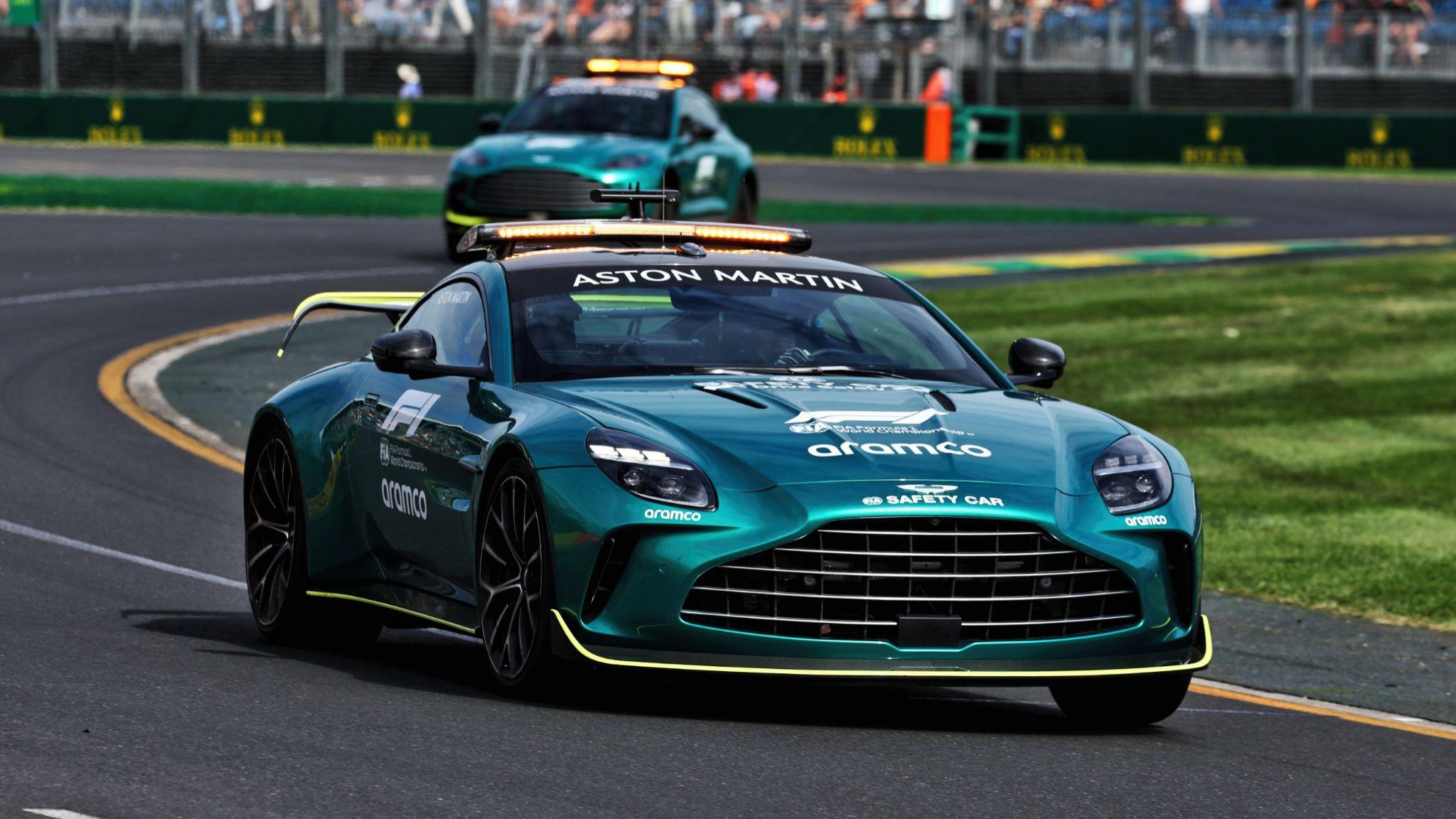
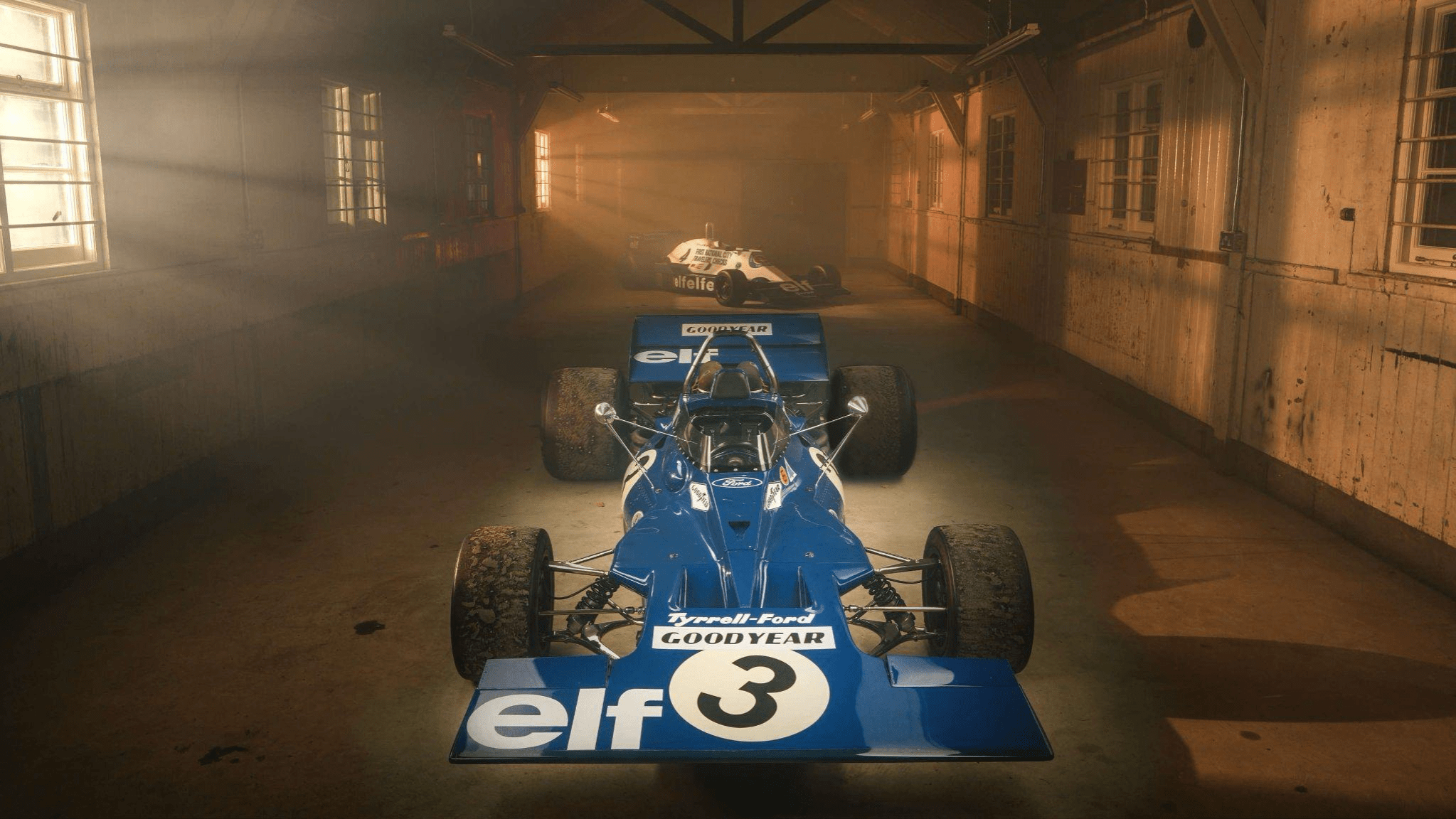
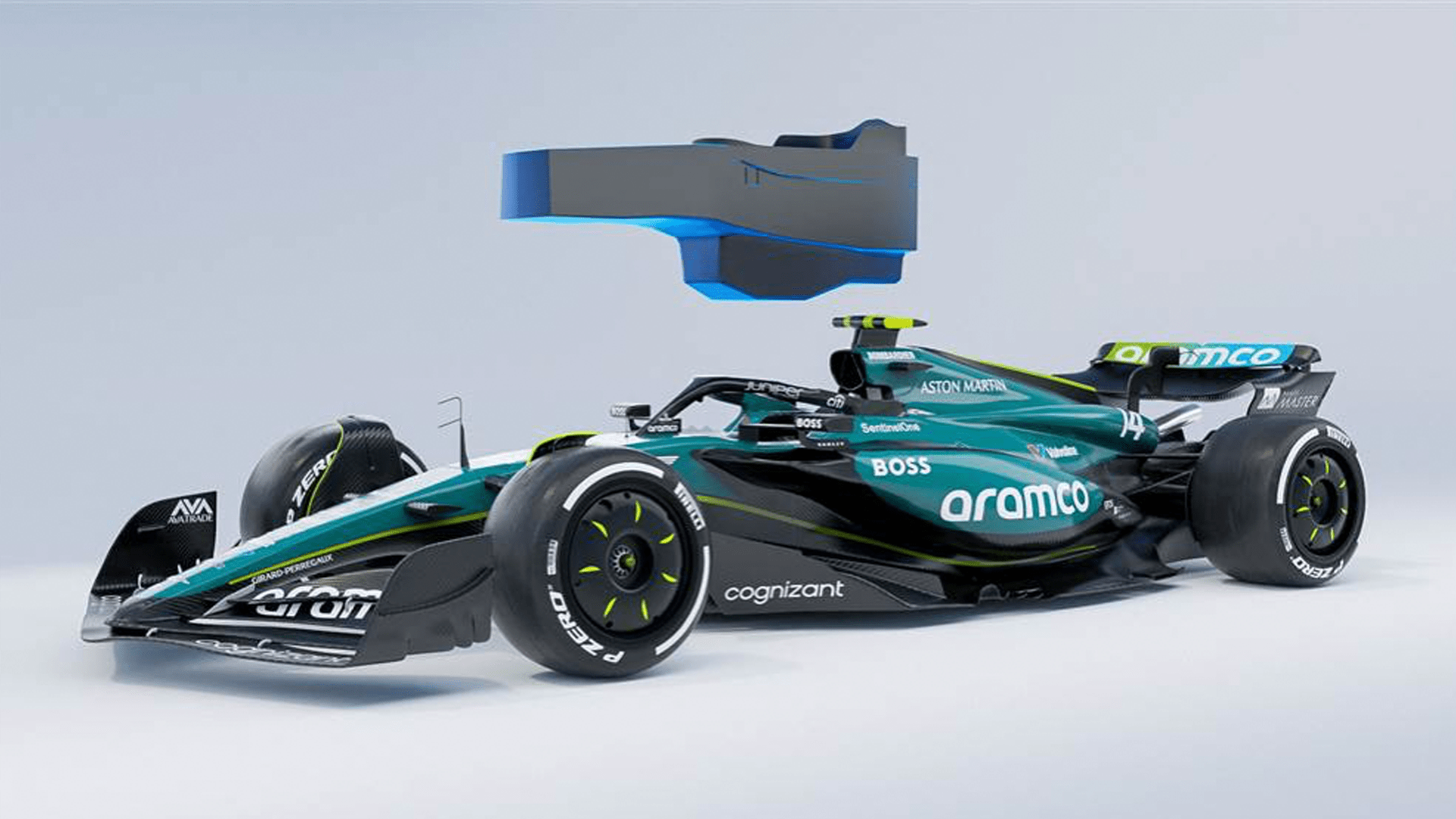
/xpb_1300472_hires-(1).jpg?cx=0.52&cy=0.57)

/sidepods.jpeg?cx=0.5&cy=0.5)
/inlet-1.jpeg?cx=0.5&cy=0.5)
/cobra.jpeg?cx=0.5&cy=0.5)
/cobra-2.jpeg?cx=0.5&cy=0.5)
